Encouraging Blog Posts
Why Your Child Shouldn’t Skip Martial Arts Classes During the Holidays

Why Your Child Shouldn’t Skip Martial Arts Classes During the Holidays
As the holiday season approaches, many parents find themselves in a familiar predicament. The bustling holiday schedule, family gatherings, and the overall chaos that can accompany this time of year often lead parents to consider pulling their kids out of extracurricular activities, including martial arts classes. It’s understandable; the holidays are a busy and sometimes overwhelming time for families. However, as a child development expert, I want to encourage you to think twice before making that decision.
Here are some compelling reasons why your child should continue attending martial arts classes during the holiday season:
1. Consistency is Key: Martial arts is all about discipline and consistency. By attending classes regularly, your child not only reinforces the skills they’ve learned but also builds a strong foundation for future learning. Consistency is the cornerstone of mastery in any discipline, and martial arts is no exception.
2. Maintaining Routine: Children thrive on routine and structure. Martial arts classes offer a sense of regularity in their lives, providing stability and predictability during the often tumultuous holiday season. Continuing classes can help your child maintain their daily routine, which is beneficial for their overall well-being.
3. Physical Activity: The holiday season often involves indulging in festive treats and spending more time indoors. Martial arts classes keep your child physically active, ensuring they stay fit and healthy even during the holidays. This is especially important given the increase in sedentary activities that often accompany holiday traditions.
4. Emotional Balance: Martial arts teaches not only physical skills but also emotional intelligence. It helps children manage stress, develop resilience, and build self-confidence. These skills are invaluable, especially during the holiday season when emotions can run high.
5. Social Connections: Martial arts classes foster social interactions and friendships. Skipping classes during the holidays can leave your child feeling isolated. In a martial arts class, they have the opportunity to bond with peers and instructors, creating a sense of belonging.
6. Goal Setting and Achievement: Continuing martial arts classes reinforces the importance of setting and achieving goals. Your child learns to work towards their next belt or skill level. This sense of accomplishment is a great way to end the year on a positive note.
7. Stress Relief: The holidays can be stressful, even for children. Martial arts provides a healthy outlet for managing stress. It’s a place where your child can channel their energy and frustrations positively.
8. Lifelong Learning: The spirit of martial arts is about continuous improvement. Encourage your child to see the holiday season as an opportunity to learn and grow, both inside and outside the dojo. Life lessons learned in martial arts extend well beyond the mat.
In conclusion, I encourage you not to pull your child out of martial arts classes during the holidays. The benefits of continuity far outweigh the inconvenience. The lessons they learn in discipline, routine, physical fitness, and emotional well-being are essential not just for the holiday season but for their overall development.
Remember that many martial arts schools offer flexible schedules during the holidays to accommodate busy families. So, discuss your concerns with your child’s instructor and explore alternatives that will allow them to continue their martial arts journey while enjoying the holiday festivities.
By maintaining their martial arts routine, your child can truly reap the rewards of this empowering and transformative journey. So, let’s embrace the spirit of the season and let martial arts be a source of joy, learning, and growth throughout the holiday season. Your child’s development will thank you for it.
Is Your Child Ready for School?

The past couple years have been such a tumultuous ride. From school closures to virtual classes to partial reopening, it seems as if our children have experienced every out-of-the-norm scenario we could come up with. Although the goal was to keep children safe, their development took a significant hit. We’ve seen more emotional distress, poorer health choices, regression in cognitive momentum, and decreased social skills. So, as the new school year approaches, it is more important than ever to ensure that they are prepared for school in ways that covers all developmental areas.
The idea of “school readiness” has always been mostly referenced when related to cognitive skills needed for school. However, many studies have found that teachers aren’t as concerned with these skills and feel that it’s more important that students function in the classroom by being confident, independent, and able to self-regulate. To prepare for this, it’s crucial that parents implement strategies now to give their children a jump start before heading back to school.
Physical: While we have focused on hand-washing and minimizing germs, many other healthy habits were forgotten. Sleep, nutrition, and physical activity were all put on the back burner. In order for children to be successful in school, parents need to begin implementing healthy habits again, such as early bedtimes, nutritious meals, and physical activities.
Intellectual: The combination of the summer and the COVID has been detrimental because it contributed to even more learning loss. Although everyone is eager to make up for this, it’s important to ease back into learning and avoid the “cognitive cram.”
Emotional: We are aware that many children have experienced anxiety to depression to lack of motivation, among many other emotions. Therefore, it’s so important for parents to role model appropriate reactions .
Social: Now that some social interactions have begun again, they are very different than before. It seems as if no one has been sure of what is and isn’t appropriate, so social anxiety began setting in. Children need a refresher course on social skills to get them feeling more secure again.
Finding fun, creative ways to get children back on track and ready for school will help them feel more confident again. The SKILLZ Child Development Centers’ approach is a whole-child focus through fun and developmentally appropriate classes. The goal is skill development physically, intellectually, emotionally, and socially. In this program, children are exposed to physical training, cutting-edge brain training, a supportive environment, and age-appropriate social interactions. All these things, combined in one class, provide the most benefit to children in their development. This is especially effective for reigniting the learning process and building relationships again.
Any new school year brings about some amount of anxiety. The start of this new school year will bring about mixed emotions, as well, and will be clouded by some insecurity. Students must be prepared when they enter the classroom this year and are excited and empowered. To do this, ample preparation is key, and we should approach our children’s development with a flexible mindset to create a safe space for them to reclaim their skill level and feel confident again.
Benefits to SKILLZ Training Over Summertime
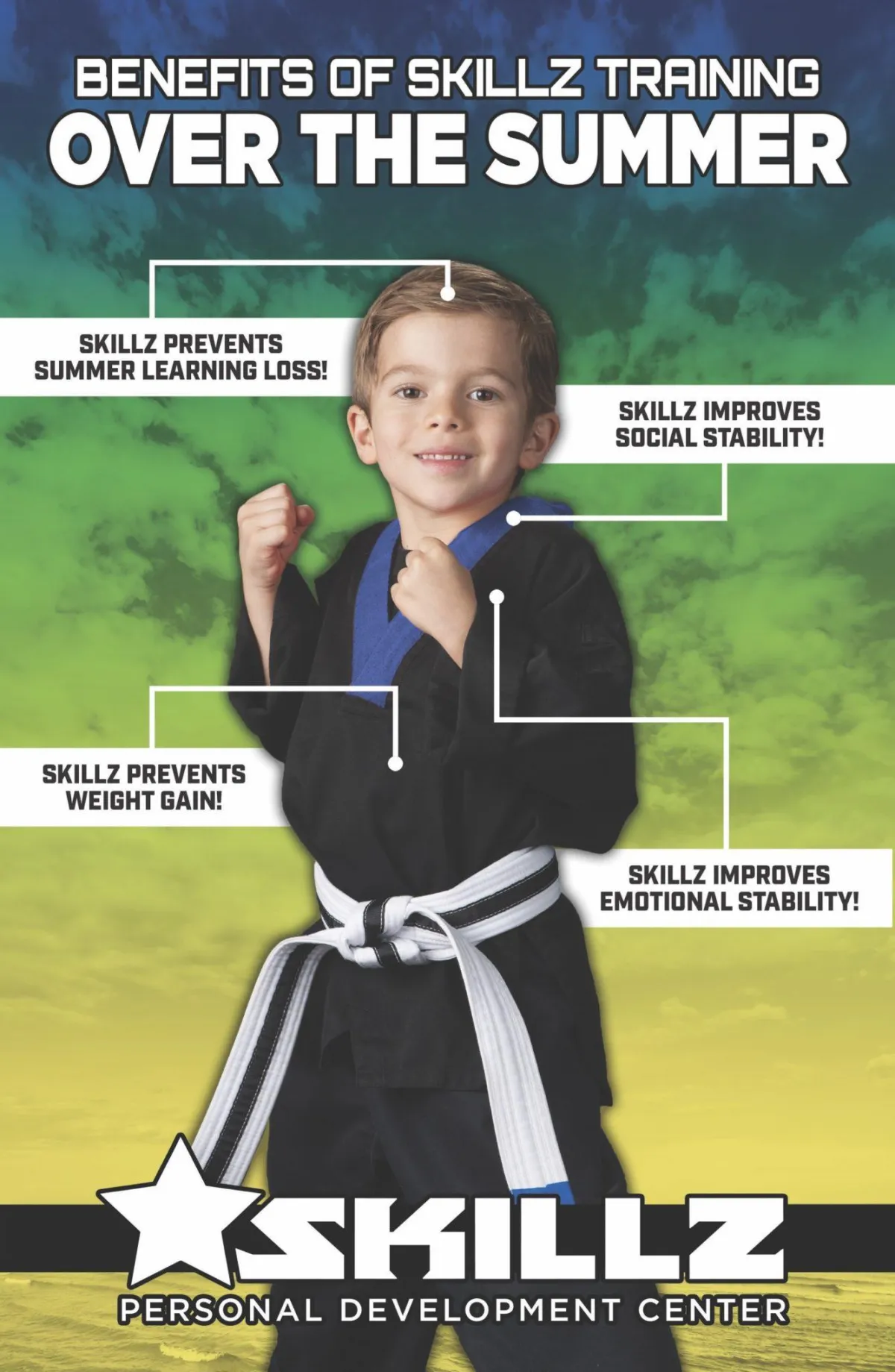
During the school season teachers, assistants, and counselors are focused on helping your children learn and grow. But what happens during the summer season when these people are not around? It makes sense that as a parent you would want your child to maintain some level of growth and development over the summer in order to limit or prevent your child from losing a lot of the skills gained over the last school season. This includes growth and development in the following areas: physically, intellectually, emotionally, and socially.
With that said, one of the very best options is to keep your child active through a solid martial arts program such as SKILLZ™. Whether your child is currently active in a martial arts program and you are considering giving him/her a break from training over the summer, or you are seeking some sort of activity to get your child involved in, consider the benefits of SKILLZ training over the summer before you make a decision. To make your job easier, we have selected four of the top benefits and provided an overview of each one below.
The benefits that we are going to cover in this report are:
1. SKILLZ prevents weight gain!
2. SKILLZ prevents summer learning loss!
3. SKILLZ improves emotional stability!
4. SKILLZ improves social stability!
Let’s get started!
Benefit 1: SKILLZ can help prevent unhealthy weight gain!
Although it may seem like children are more active over the summer, the lack of structure also contributes to weight gain. Even just two days of structured physical activity over the summer can have a snowball effect on their physical activities at home. SKILLZ is so much fun, that children actually enjoy the physical workouts even during the summertime.
Did you know?
• Children gain weight nearly twice as fast over the summer because they are snacking more often, many times out of boredom or lack of proper supervision. At the same time, many children are also less active over the summer because they sleep in longer, watch TV longer, play video games longer, etc.
• SKILLZ includes fun daily classroom activities that boost physical development. In fact, children who train in SKILLZ practice more at home over the summer since they have more free time to do so. This means they will enter the new school year in better physical shape than the previous school year!
Benefit 2: SKILLZ can help prevent summer learning loss!
Many people have an image of summer being a carefree happy time where “kids can be kids,” and take for granted the benefits of enriching experiences from organized activities. Even just two times per week in a structured program can make a tremendous difference in a child’s intellectual development over the summer. SKILLZ provides these benefits in a manner that is also fun so that kids can still be kids and not lose that carefree and happy summer lifestyle.
Did you know?
• For over a century, scholars have recognized that summer vacation is a period when children’s brain development declines relative to the school year. In fact, studies have shown that children score much lower on standardized tests when they enter the new school season compared to the same tests taken at the end of the previous school year.
• SKILLZ includes daily classroom activities to boost intellectual stimulation over the summer. In fact, children who train over the summer also tend to progress even faster because their brains are not “bogged” down after a long day of academic learning. This means children can actually enter the next school year even smarter than when they left for the summer break because their working memory and fluid intelligence are expanded to a whole new level of development!
Benefit 3: SKILLZ training can improve emotional stability!
When the school year ends, children lose a lot of key contributors that boost self-esteem. This leads to less confidence entering the back to school season. SKILLZ provides a great environment for building children’s emotional development in a manner that is positive and productive.
Did you know?
• Children that lose self-esteem over the summer enter the new school season with many fears associated with making new friends, meeting new teachers, and bullying.
• SKILLZ includes daily classroom activities that strengthen children’s emotional outlook. In fact, children that are more confident enter the new school season excited about all of the wonderful opportunities that schooling has to offer!
Benefit 4: SKILLZ improves social stability!
Following rules are very important, especially over the summer when there are lesser rules that children must follow. This includes proper social behavior. SKILLZ develops proper social behavior during class, and those lessons carry over at home.
Did you know?
• Children that do not have proper social development over the summer tend to misbehave when they enter the new school season. At the same time, children that do not have sufficient positive social interaction over the summer enter the new school season with more anxiety.
• SKILLZ includes daily classroom activities that boost social development. In fact, children who train in SKILLZ over the summer tend to be the same students that get glowing behavior reviews from teachers during the first round of parent-teacher conferences. At the same time, children with the best behavior reviews are also statistically the students with the best academic reviews because they are not distracted by the repercussions of poor behavior.
Conclusion
The summer can be a wonderful opportunity to help your child not only enjoy a break from school but at the same time become a better version of themselves as they enter the new school year. What parent would not want to see their child enter the new school year physically, intellectually, emotionally, and socially stronger? SKILLZ training could very well be the best investment you make over the summer!
Supporting Big Feelings and Self - Regulation
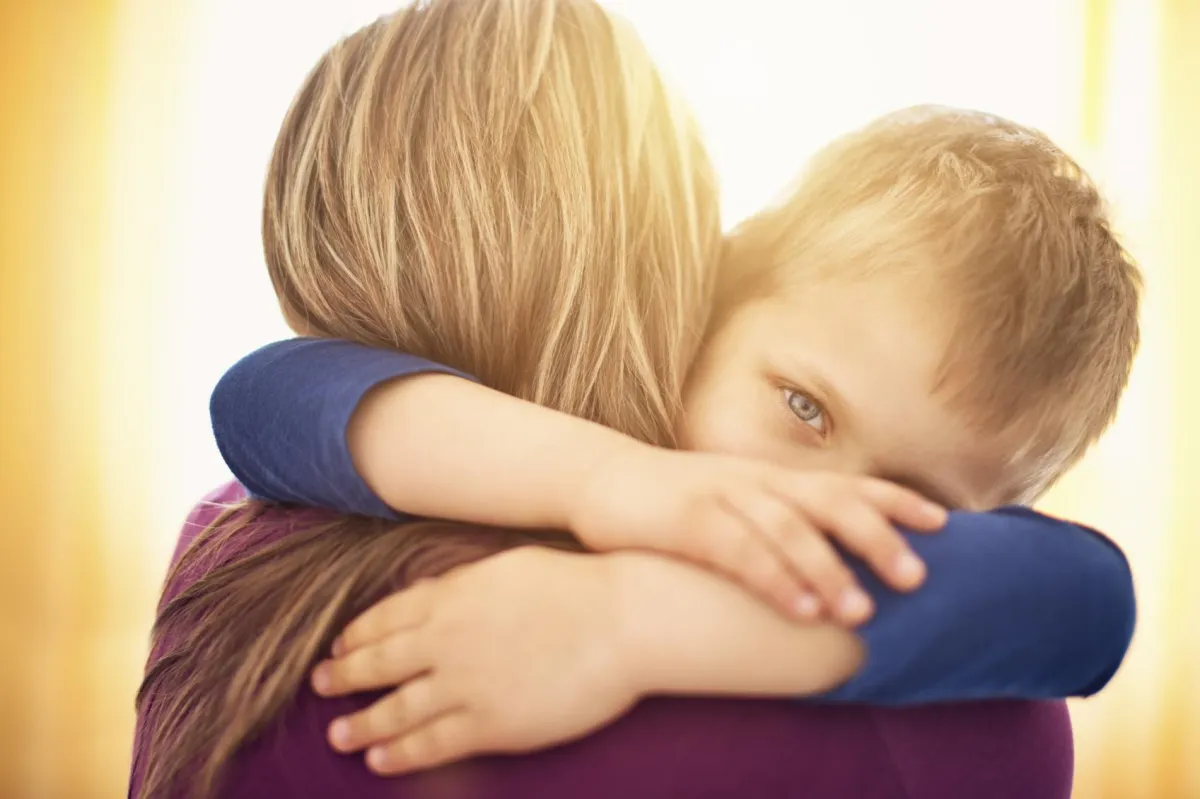
“I see you, I hear you, I feel you!”
Two weeks ago, Megan’s oldest son was preparing for a new session of hip hop classes to officially begin! He was just about bursting at the seams with joy and excitement as he could not wait to get back to the hard beats and sweet jams he had come to love in his previous session of enjoyment.
You see, his last session of dancing was a huge, big deal! Being on the Autism Spectrum, trying hip hop was a new and exciting physical, mental, emotional and social experience for the family. Megan and her husband had to become attuned alongside our son to supporting him in a new space and learning environment, with a new teacher, new friends and style of movement that was up to that point completely foreign to our boy. Just as he was learning how to navigate this new adventure, so were they, ever present by his side!
She waited excitedly in the lobby for her precious boy to come on out of the class to show her all the new sweet moves he had learned that night. But upon the door opening, Megan wasn’t met with sweet moves or the latest and greatest steps. Instead her son’s face was red, his shoulders and back were hunched, as if he just received a crushing blow to the heart and tears were about to overflow from his blue eyes.
Asking, “Honey, what’s going on?” He quietly whispered, “Something happened, I need to talk to you now.” Wrapping her son in his warm winter coat, she found his eyes and whispered back, “I see you, I hear you, I feel you. Let’s go talk.”
Nothing cuts through the heart of a mom or dad quite like seeing your child in pain. Whether that pain is physical, mental or emotional, seeing your baby in a place and space of wrestling with the hard and heavy of life is never easy.
But how can we as parents support our children when they are experiencing deep, emotional responses? Further, how do we help children grow in their ability to self-regulate when moments test them most? Let’s explore!
• I see you.
When children shift in spirit from a happy, carefree space to “Something is wrong,” there are definite cues in body language, tone of voice, behavior that alert us both as parents and instructors that something has changed and it’s time to support, nurture and advocate for their voice to be heard.
Finding a child’s eyes who is experiencing a heightened emotional response goes a long way in first and foremost connecting with them in their time of need. Even as adults, there is something truly special and comforting about receiving the validation of being seen in a moment of distress, disequilibrium and struggle.
When parents and instructors come alongside a child in their hurt and validate the state of emotion they are in, it gives reassurance and encouragement to the child in that moment that we all have their back and they will not have to figure out what has happened on their own.
• I hear you.
Coming down to a child’s eye level, being with them in the place and space they find themselves in is powerful when taking the intentional and necessary step of understanding what has ignited the emotional response from their perspective.
Listening goes far beyond the words a child is expressing. As their vocabulary develops, it certainly becomes a bit easier with age and time to decipher all of the clues we are given when heightened states of emotional expression arise. Truly listening to the body language of the child as well as considering the factors of what happened within the surroundings are all pieces of a puzzle that can help to unlock the root of the struggle.
Especially in moments of competition where the surge of adrenaline is at its peak, you’ll often see our instructors take a knee, getting down to a child’s level to find their eyes, hear their truth and aid them in working through their big feelings when experiencing a loss of the game for example. The ability to cope with and process emotions takes practice and patience. Remaining consistent in this practice, calm and levelheaded is a must! Remember, being the parent or the instructor a child needs us to be requires us remaining grounded and centered, not joining in the heightened emotional response.
• I feel you.
Parents, you know your child best. Period. We as instructors have the privilege of coming into your family’s world when you become a part of our tribe, not the other way around.
As a Childhood Development Center, we are committed to the support, nurturing and guidance of the whole child. Providing our students in moments of distress real life support with tools of success to:
1. Come back to breath
2. Come back to center
3. Process the events that lead to the distress
4. Hold space until such time regulation is achieved
… This all contributes to giving you and your child the support you deserve. Because just as this boy experienced being seeing, heard and held in the space he found himself in with the help of his mama, so too do each and every one of our students receive the same level of care, compassion and love. For how they are seen and supported in their moment of struggle, so too will they in turn learn to be there for those they love in their time of need.
Supporting Intellectual Connections at Home
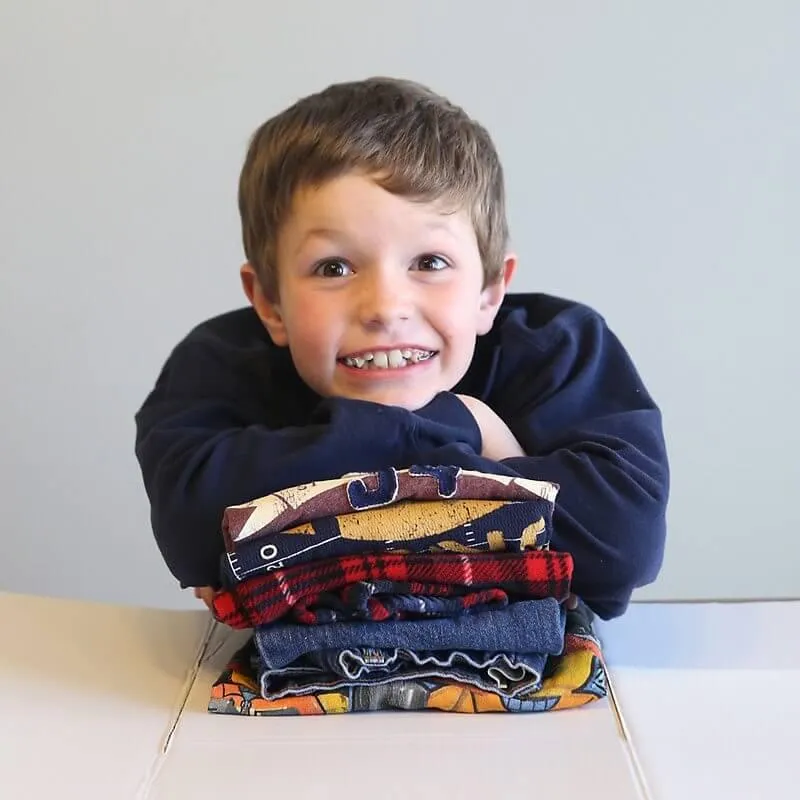
Pablo Picasso once said, “I am always doing that which I cannot do, in order that I may learn how to do it.” What an incredible posture, way of looking at that which is not yet known or second nature to us!
All of the parts of the whole, the physical, intellectual, emotional and social pieces all come together as we teach with the developing brain in mind. But how can we as parents further support, nurture and guide the developing mind and critical intellectual connections beyond the mats? Great question, let’s explore!
1. Bringing Ninja SKILLZ Home!
Seeing our team in action, you’ve come to know, love and expect that your child is going to be playing with purpose when they enjoy time on the mats. Teaching with the brain in mind, we incorporate Teaching SKILLZ alongside Brain SKILLZ into all that we do which is something you can do at home too!
Let’s look at Trickery for example! Trickery is a fan favorite on the mats and beyond when you incorporate “Ready, get set, GOOSE!” Google, Goo, Gopher… Any word but “Go!” into the picture! Through the Teaching SKILLZ of Trickery, we are building a huge amount of connection, attentiveness, engagement, focus and awareness into the mission of the moment. Further, this is all influencing and nurturing Speed of Processing and Auditory Processing for example. The use of these two critical Brain SKILLZ on and beyond the mats can have a measurable impact on the success of completing tasks in school and at home when speed and efficiency are needed most.
So the next time you find yourself in a battle over putting away the folded laundry for example, take that spirit of resistance and turn it into a spirit of assistance!
1. Engage the power of flexible thinking and have a “Captain Underpants Battle!”
2. Line up the contestants at the starting line, for us the kitchen table where we fold our laundry, and load up the troops with their first pile of laundry in hand.
3. Making sure the rules of the run have been clearly defined ahead of time, now we’re ready to have some fun! Are grippy socks on and ready to run?
4. “On your marks, get set, GHOST!” Capturing the attention of all those before you, you now have dopamine releasing, the anticipatory brain chemical, neural networks firing and pathways lighting up, ready for deeper, strengthened connections! Top off the “Captain Underpants Battle” with hugs, high fives and praise, increasing the flow of oxytocin, feel good chemicals all around and you have just taken intellectual connections to a whole new level right at home!
Play on the mats, play in school but especially play at home is vital to your child’s overall, holistic growth and development. Enjoy the creative and spontaneous elements of life and learning as they come along!
2. For Our Neurodiverse Friends…
Creating a safe environment at home where role playing can pre-frame the mind, heart and spirit for what may come amid a group dynamic is a great place to explore the world of making new, strong connections alongside friends in a group setting.
Considering the above example, Trickery can first be introduced in the form of a social story with neurodiverse children. A social story is a tool in which the context of an activity, social engagement, practice etc., is broken down into clear steps that offer a template of interaction that is to occur. For the above example, I have broken down the context of the game in prep for play with purpose as follows:
1. Mommy and brother are going to play a game with you called “Captain Underpants!”
2. You will start by standing by the kitchen table.
3. I will give you a pile of your clean, folded laundry to hold.
4. Now here is the fun part! Mommy is going to say some silly words to see if you are really listening.
5. Mommy might say, “Ready, get set, GOOSE!” But we can’t run on the word “Goose,” we have to wait for the word “Go!”
6. It is a change to hear silly words that sound like “Go!” It is okay to laugh when you hear the silly words.
7. When you finally hear the word “Go!” run to your room to put your clean pile of clothes in your drawer. Then come back to me!
8. I will be waiting to give you big hugs and high fives when you complete your “Captain Underpants” mission.
9. You can tell mommy how you felt about the new game after we play.
For your child, you may need to edit the above template here and there to help support them in their individual needs. If your child is non-verbal, social stories can be a great tool of connection and communication. Our family often uses this special tool when experiencing new things, understanding social dynamics and supporting hard concepts that are difficult to understand.
Supporting the power of intellectual connections at home is so much fun and heartwarming for all involved! If you find yourself in need of further inspiration to keep the awesome ninja juices flowing beyond the mats, please connect with one of our Pediatric Ninja Specialists who are always standing by. Playing, learning and growing with purpose is all a part of our mission, one which we are so blessed to be able to walk alongside your family in!
Supporting Kids Physical Development in the Face of Challenges
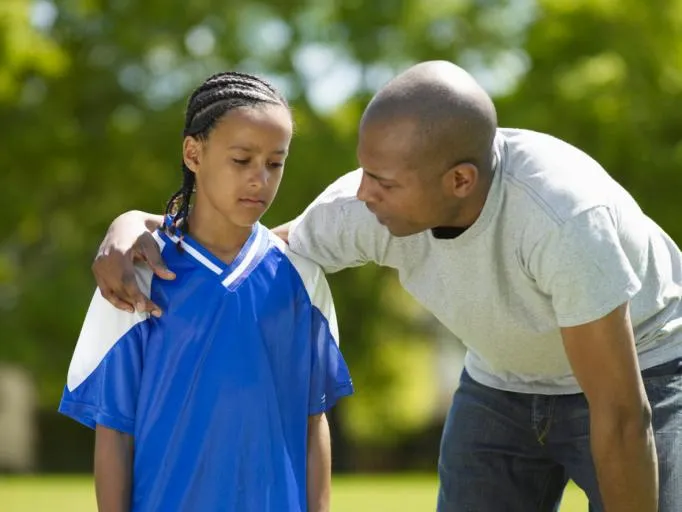
Have you ever had a teacher, coach or mentor that inspired you to the very core? One that cheered you on to achieving your big dreams and goals with the biggest heart, joy and fire?
What happens when your child encounters a challenge, a mountain in the face of their progress? How can parents be allies to their kiddos when you find them wrestling with doubt in their ability to finish strong?
Step #1: Time for a gut check!
When our children face physical challenges that lead to a question of their ability to keep going, striving towards their next goal and earning the win they have been fighting for, it is important for both parents and kiddos to take a step back and consider the dynamics of the crossroads. It is gut check time! Some things to consider:
1. How is my child doing?
2. Have you noticed a change in their physical well-being as of late related but not limited to appetite, sleep patterns, activity level?
3. What is on my child’s life plate right now? Is there balance or overfill and overflow?
Other questions, cues may need to be considered. But from this assessment, parents and coaches alike can glean insight into the root of the doubt being felt.
Lack of motivation, doubts in one’s ability to succeed are merely symptoms attempting to mask a deeper root issue!
Step #2: Dig Deep!
If after considering the big picture you find that a lack of motivation is influencing your child’s underlying doubt, ability to finish strong, then it is time to dig deeper and be the parent your child needs you to be in supporting them to stay the course!
Motivation is not something our children are born with in most cases. Are there the anomalies, the children who are born with a drive to compete on a very intense, high level and one day professionally? Absolutely! But even the best of the best, even us as parents in our day-to-day life, we all have our moments when we feel like our fire isn’t burning as hot and/or our drive is less than stellar.
Some things to consider if lack of motivation is playing a part in your child’s doubt to see a mission through:
1. What are the conversations, feelings, sentiments being shared about the challenge(s) before your child? Are you noticing a thread of negative cognitions, “I’ll never be good enough,” “I am not strong enough” or “Everyone is getting it but me!”
2. Taking the first question a step further, how are you supporting the conversations, feelings and sentiments? Is a light being shined upon the good, positive, well-done strides of progress you have witnessed on their way towards crossing the finish line? Or do you find yourself stuck with your child in a posture of what is not going right on repeat?
3. Is there intentional space being created before it is time to train to set the mind up for success? Or are there perhaps strong distractions like playtime on technology that have become more appealing in the moment, pulling away from the goal to be accomplished?
The inner monologue we preach to ourselves often becomes our truth.
So let what we speak about ourselves and what is spoken over our children be seasoned with Love, Light and Encouragement!
Step #3: We’ve Got Your Back!
A you well know, we are very passionate about ensuring that the whole child is supported in anything and everything that we do. When you see that your child is struggling to finish strong, is wrestling with their abilities or is expressing thoughts of self-doubt, we are here and we have your back!
No child or parent should ever walk through the challenges of life alone. Further, no child should ever feel as though they cannot succeed and win in whatever goals, dreams and aspirations have been put upon their hearts.
This is why we welcome your conversation, communication and collaboration. Because it takes a village to raise a child! We know that at every level of our SKILLZ Strong Programming, each and every one of our ninjas are going to face new physical challenges that also test their minds and spirits. Why? Because they are going to face tests of the mind, body and spirit in the real world someday, if not already. And it is our passion, mission and drive to ensure that each and every one of our ninjas is equipped with the tools of success to face any obstacles or challenges that come their way with amazing success.
There is no limit, no cap on the potential of what our children are capable of achieving in their lives. Each and every one of us are witnesses to the most amazing stories of heart, courage, strength and perseverance within our children every single day. May you be encouraged as you go forward today knowing that there is a great tribe of support surrounding you and your child!
Social Development Goals in the New Year
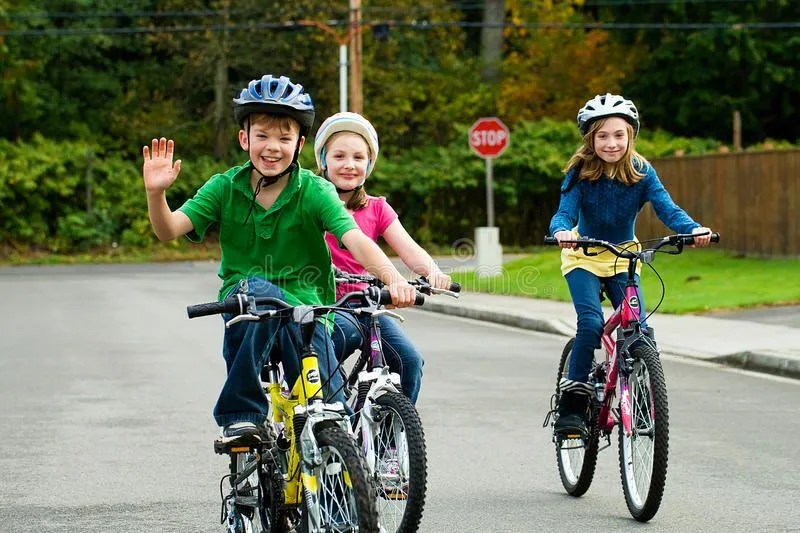
Do you remember the carefree days of your youth? Running outside to meet up with your friends at the park and keeping an eye on the sun and street lights to know when it was time to head home for dinner and family time. Those were the days!
Present day socialization practices for our children are on a whole other level! Not only do they engage in very different in-person interactions amid the ongoing pandemic, some also engage in social media connections with peers that are far from the days of our youth, free of accessible technology anytime right at our fingertips.
As we all continue to navigate through these unprecedented times, it goes without saying that our children’s social and emotional development has been affected for some more so than others. From our youngest ninjas to our teen ninjas, all of our children have experienced some degree of shift in their ability to make healthy social connections. This all begs the question, how can we best support our children’s social development in the New Year?
Before we can dive into socially supportive strategies, we must first recognize and appreciate where are children are currently at in the challenges they face with their social growth and development. Let’s break it down:
Early SKILLZ Friends (3–4 years old): Neurotypical challenges this age group faces include communicating through physical means vs. verbal, expressing difficulty in taking turns and being very self-focused. Why?
At this age and stage of development, young friends have a limited vocabulary making it very challenging to express themselves using their words. Thus, physical expression when emotional flooding; surge of emotions occurs is very common.
When friends of this age experience an emotional response to stimulus that is overwhelming to their system, a shift from the “Upstairs Brain,” responsible for higher thinking to the “Downstairs Brain,” flight, fight or freeze occurs.
Basic SKILLZ Friends (5-6 years old): Neurotypical challenges often faced by this age group include seeking constant attention, becoming easily distracted by what others are doing especially when involving friends, speaking with zero filter and poor sportsmanship.
During the ages of 5-6 years old, children are positively increasing their knowledge of new words and expressing them more often vs. using physical means of expression. With that said, due to an underdeveloped pre-frontal cortex, impulsivity; speaking before thinking, acting before thinking is quite common.
As children of this age group begin to take baby steps in exploring more social connections with friends vs. parents/caregivers, interest in what friends are up to can challenge this group as they strive to relate, form more bonds with those outside of their primary circle.
Core SKILLZ Friends (7-9 years old): Neurotypical challenges this age group faces include getting frustrated when they witness things that aren’t fair like a peer cheating during play to win as well as disliking having the spotlight on them.
As children of this age group continue to grow and develop through the years of 7-9, they are faced with frustration and begin to engage in the time-honored tradition of tattletaling. While this often comes as a frustration to parents, it is actually a sure sign of their brain reaching a critical stage in its development; the ability to call out right from wrong, reasoning and critical thinking skills beginning to come online.
Further, feelings of fear of failure, especially in front of adults, contributes to apprehension of being put under the spotlight in a variety of settings. Emotional regulation in these uncomfortable situations can be challenging as their minds can still easily shift when overwhelmed from the “Upstairs Brain” into the “Downstairs Brain.”
Extreme SKILLZ Friends (10-14 years old): Neurotypical challenges often faced by this age group include caring more deeply about what peers think and feel about them, demonstrating riskier behaviors and displaying immature behaviors amongst friends.
As children of this age group enter into their final years of physical, intellectual and emotional growth, culminating in full maturation of their brain in their early twenties, lack of ability to make good decisions due to peer pressure as well significant changes in their brain’s final stages of growth and development all contribute to an emotional roller coaster ride for teens.
There is the notion amongst teens discussed by Jean Piaget of the “Imaginary Audience,” the belief held by adolescence that they are being constantly watched and scrutinized for their appearance, actions, etc. This coupled with an overwhelming desire to please their peers can contribute to complications in experiencing healthy social interactions.
Bearing your child’s age and stage of social development in mind is critical to being able to effectively support, nurture and guide them in their social goals this year. Reflecting upon each of the SKILLZ age groups discussed above, consider these socially supportive goals:
1. Early SKILLZ Social Goals:
a. Create time and intentionally supportive space that gives your child the opportunity to learn alongside and interact freely with their friends.
b. Standby! Allow your child to explore their world through play with friends!
c. Call Out the GOOD! Take every opportunity to call out your child’s positive choices, nurturing good behavior decisions when interacting with peers.
d. Provide choice of pre-approved options that your child and their friend may exercise their decision-making abilities, flexible thinking together.
e. Finally, offer praise and rewards when your child and their friend exhibit control when big feelings arise!
2. Basic SKILLZ Social Goals:
a. For this age group, just as with our Early SKILLZ friends, create time and intentionally supportive space for your child and their peers to explore play together; especially play that encourages good teamwork, working together.
b. Help oversee and nurture opportunities of healthy competition where friends can actively practice winning and losing with grace. As with anything, practice makes improvement!
c. Encourage your child and their friends to take pride in playing together well, with kindness, flexible thinking and abundance of caring!
3. Core SKILLZ Social Goals:
a. Creating opportunities for your child and their friends to build up and boost their positive feelings of self and of others is must!
b. Offering encouragement and positive reinforcement will go a long way in helping your child build their overall confidence in engaging with peers.
c. Supporting regulation of emotions and offering assistance between your child and their peers as needed while they are displaying critical thinking skills will also go a long way to help improve and strengthen your child’s ability to move from the “Downstairs Brain” back into the “Upstairs Brain” when strong emotional interactions and responses arise.
4. Extreme SKILLZ Social Goals:
a. First and foremost, create safe, soft, caring, trusted space with your teen, allowing them to express their emotions if interactions with peers are at a heightened emotional state. You are still your teens safe place! Be the parent they need you to be, not reacting out of emotion to what may be poor choices on their part. But hold space for them, responding in love, light and truth as needed to help them navigate through this critical stage of their growth and development.
b. Create opportunities for your child and their peers to come together in a safe space to enjoy time with one another as often as you can!
c. Praise, Praise, Praise their positive choices!
d. And never stop the flow of unconditional love you have for your teen, supporting them every step of the way as they make their final progression into adulthood.
Health and Wellness - Goal Setting in 2022
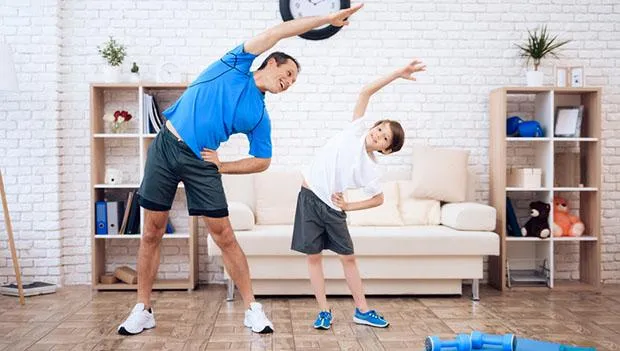
Many of our SKILLZ Strong Ninjas and Proud Ninja Parents are breaking out into their best “Jingle Bell Rock” as the promise of a Ninja-tastic New Year knocks at the door! As 2021 draws to a close, the dawn of the New Year comes with fresh inspiration, motivation and high hopes for conquering great things in 2022!
Whether your goals for the New Year are physical, intellectual, emotional and/or social, there is truly something special and exciting about the blank canvas of the next 365 days before us, all about to be filled in with the colorful, precious moments of living and loving to the fullest!
As we consider how our fresh canvas will look in the New Year, there is no denying the importance and power of caring for the mind, body and spirit so it can thrive! In the constant flow of the daily missions before us, movement is central in our everyday living. Further, purposeful movement has an undeniable impact on the whole being of not just our children but us as grown-ups too! From our quality of sleep and overall mood, to energy level and complete physical health, daily intentional movement is vital to supporting our whole selves.
But how can we as Proud Parents best support the health and wellness goals of our children in the New Year? Consider these tips to keep everyone in your family rockin’ through 2022:
1. Be the role model your child needs you to be. Physical health and wellness starts at home! Each and every day, our children are watching and learning from us about how to take care of themselves physically, intellectually, emotionally and socially so they can formulate their own unique self-care regimen. Taking an active and present posture in your child’s health and wellness goals means taking a look first at your own patterns of health and wellness to see if what you are currently practicing is what you want to continue preaching.
• If there is something in your overall health and wellness upon self-reflection you wish to change, take it one step at a time! Narrowing down your goals to focusing on one healthy aspect of improvement at a time will go a long way towards creating consistent habits of success.
• As you begin to model your own practice of self-reflection and self-improvement in your health and wellness journey, talk with your child about what goals they too wish to work on! Consider creating a visual aid, like an accountability chart to help them along their journey. Rewards like choosing the next game for family game night after picking a healthy snack consistently for 5 days straight before bedtime will go a long way to help keep your child motivated in their pursuit of creating healthy habits in their own health and wellness walk!
• Food for thought: How can you too use a version of the accountability chart above with rewards at certain check-in points to keep you motivated in your 2022 health and wellness goals?
2. Keep it real and keep it simple! Incorporating intentional movement at home should never be a burden but rather a great opportunity for connection with your child! Consider introducing your child to a band you loved rockin’ out to when you were their age. Turn on an old favorite song and have a blast dancing around the whole kitchen as you prepare a delicious meal together. Allow your inner child to have fun with your kiddo!
3. Balance rest and relaxation with the adventures of everyday life! The go-go-go of life can truly sneak up on us and take hold if we are not mindful and careful of all the happenings going on in any given week. Making supportive decisions that take into due consideration the overall health and wellbeing of the family is vital to everyone’s success.
• Taking the opportunity to schedule in downtime throughout the week, to reconnect, refocus and regroup is important. Maybe this looks like a bedtime story with your child every night or dinner all together on Friday nights followed by a special family movie. Whatever practice resonates most with your family to honor space and time together, to rest your mind, body and spirit throughout the week is the way to go! Remember, we cannot give on an empty cup.
It goes without saying that we are so excited for a fantastic, fun filled New Year! Our team of childhood development experts is here and ready to serve your family, to help support you all in your goals for 2022! If you find yourself in need of some specific tips to help nurture and guide your child in their aspirations for the New Year, please reach out to connect with one of our ABK team members. It takes a village to raise a child and we are so honored and blessed to be rockin’ alongside you all every step of the way!
Playing with a Purpose
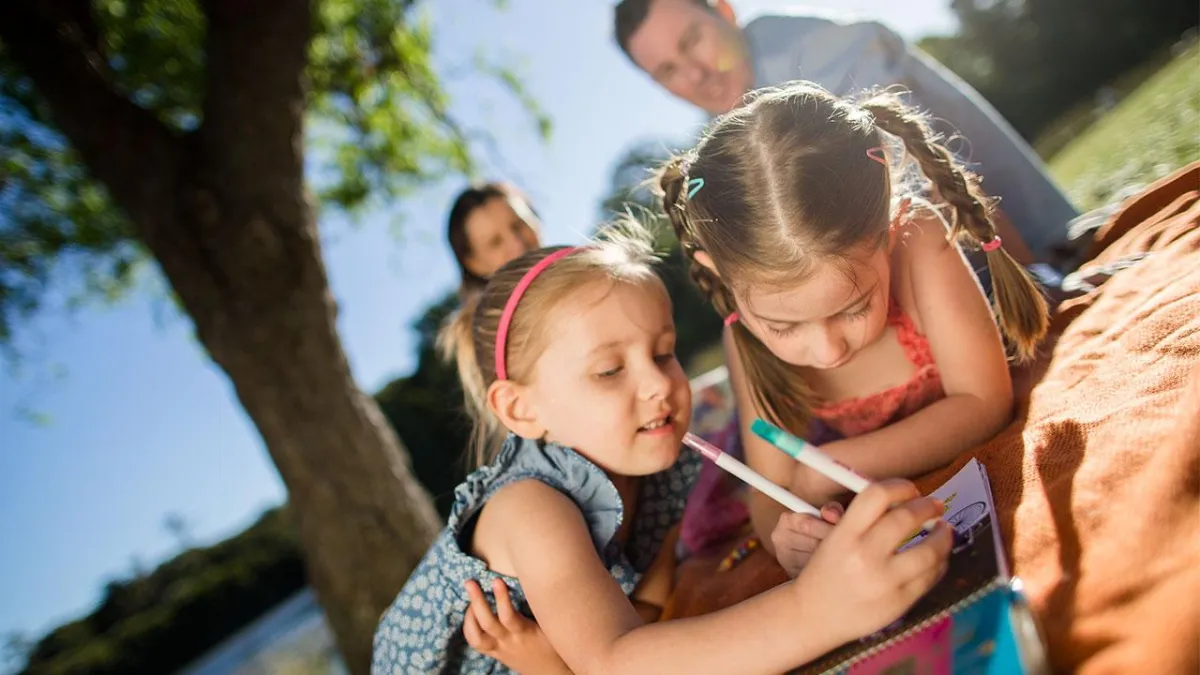
Have you ever taken a moment to truly admire the art and incredible beauty of watching a child at play? Their fully engaged spirit, drive, imagination and passion are all completely vested in the mission of the moment. Whether tinkering with their next greatest creations or saving the day as their favorite superhero, children demonstrate freely and without any reservations the power of playing with purpose!
Maria Montessori once said, “Play is the work of a child.” How very true! As parents, teachers and coaches, we each have an incredible opportunity to step with intention each and every day into the world of a child, meeting them exactly where they are at in their own unique phase and stage of development. But what are “phases and stages of development” you may ask? Great question!
For years, child development experts in the specialized fields of science and psychological study have been uncovering the physical, intellectual, emotional and social characteristics of adolescence at different ages and stages of their ever-evolving development. By utilizing nurturing, age-specific curriculum purposefully designed to help a child grow, excel and exceed their developmental expectations, we are equipping children for bold, bright futures in their own distinct endeavors!
Taking a deeper dive for just a moment into the purpose of age-specific play, let’s consider two ends of a beautiful spectrum. Imagine for a moment a three-year-old and a fourteen-year-old. How a three-year-old vs. a fourteen-year-old play are very different and understandably so! Developmentally each are in different seasons of life. The three-year-old for example is far more rooted in parallel play, mimicking and mirroring behaviors witnessed than engaging naturally in back-and-forth play. Further down the developmental line however, the fourteen-year-old is far more inclined to be exploring the ever-changing dynamics of their own social universe. With eyes wide open, they step with greater intention and interest into seeking and valuing the thoughts and feelings of their peers more than their parents. As the mind, body and spirit of a child continue to grow and develop, so too does their level of meaningful interaction with peers, individuals outside of their core family influence.
But what happens when play doesn’t come naturally to a child? How can we as Proud Ninja Parents support our youth in experiencing the power of purposeful play? By taking action and engaging in:
1. Creating time and space for purposeful play. Setting intentional time aside to practice back-and-forth play with your child will go a long way in helping them know the boundaries and expectations within appropriate play with peers. Modeling expected and unexpected behaviors that may arise when playing tag for example with your six-year-old is a great way to help your child know what to expect when spontaneous play occurs. While tag may not be the go-to game with your teen anymore, there are ways to connect with them in play as well. Consider asking them what adventure they would like to go on with you today! Connection and attunement to the needs and desires of your teen are just as vital and important as they were when they were young.
2. Set up a play date. For Proud Ninja Parents with little one’s just beginning to explore the power of play, confide in a trusted fellow parent whose child may be a great motivator and influencer for your child to develop deeper connections with outside of home. Prior to your time all together, decide upon the activities you’ll play involving hands-on, purposeful play.
a. Maybe you’ll start off the play date at the park with some parallel swing time to break the ice, allowing your child and their new friend to settle in. From there, perhaps a friendly game of “Alligator,” a recognizable game from SKILLZ Ninja Class that would involve both parents and children in the special playtime. As your time together progresses and friends become more familiar with each other, allow for space and personal exploration amongst them, keeping a watchful eye from a distance to prompt and redirect as needed.
Remember, play dates certainly do not need to be elaborate, expensive excursions. Some of the best play you can have with your child and their friends are the simplest, organic and engaged kind!
It takes a village to raise a child and we are honored to be a part of your amazing story! Never hesitate to connect with us because we are here to support you every step of the way in your journey, parenting with purpose.
Here I play with purpose.
Here I learn and grow.
Here I’m supported and nurtured.
Here I’m surrounded by a tribe of people who love me more than I know!
Parenting with a purpose
The Invisible String

Have you ever heard of “The Invisible String?”
Beautifully written by Patrice Karst and illustrated by Joanne Lew-Vriethoff, “The Invisible String” is a phenomenal children’s book! Interwoven from page to page is the theme of the strong, unbreakable bonds we share with our children, whether near or far away. While Patrice and Joanne crafted a story that certainly offers a lifeline of support and comfort for children and families when facing things like loss, anxiety when separated from loved ones and even loneliness, they also powerfully capture the essence and strength of the purposeful relationships we share with family, friends and other cherished souls throughout the course of our lives.
Taking a moment to think about your own life’s journey, do certain family members, friends, teachers, coaches, people of influence come rushing to your mind? From infancy through adulthood, our entire lifespan is shared with others who bear witness to our stories just as we bear witness to theirs! The power of connections and the bonds we all share with those closest to us make a very large impact on the course of our lives. Because we are not meant to journey through this life alone! Relationships, connections, sharing in the journey is all a part of the walk.
When it comes to the power of relationships and connections for our youth, it goes without saying that the social development piece plays just as great a role as ones physical, intellectual and emotional development does. With that said, it is important to bear in mind that certain ages and stages of development bring with them certain milestones, areas of increased growth and exploration of new experiences!
To better illustrate the differences in social development, let’s compare a three-year-old to a fourteen-year-old for just a minute.
In the early preschool years, children often exhibit a very strong attachment to their parents or primary caregivers; The adults who are most present in their lives. Since they were born, these adults have been their whole world! They have loved, cared for and watched over this little one from day one. It is no wonder that these precious little humans sometimes struggle in saying goodbye to their trusted adults when it is time to go to school or even enjoy extracurricular activities. You are asking them to leave, step away from their safe person and safe zone. That is a lot to grasp, understand, sit with and incorporate into their intellectual and emotional being!
Now, compare a preschooler to a teenager and you see a young man or woman learning to step into their truth, power and identity! The days of relying solely on their primary caregivers have shifted now into looking to their circle of influence including friends, teachers, coaches and others to formulate opinions, ideas and ways of moving forward along their journey. Though the natural progression in the teens social development is certainly to begin branching out from their home base, it does not in any way diminish the need still for the presence of their parents and other close family members. As the beautiful teen mind continues to mature and
development, parents still continue to play a vital role in supporting, nurturing and guiding their son or daughter in next best purposeful steps towards adulthood.
Bearing in mind the ages and stages of social development of every student we serve, SKILLZ Childhood Development Centers strive to support the social piece by:
1. Instilling a sense of tribe. Children as they grow often seek places where they feel a sense of belonging and unconditional love and support. Incorporated into every class experience is a conscious sense of tribe. Because we are a team! Each of our students in the practice of their individual skills is also developing and maturing in their development of teamwork, leadership, empathy, compassion, love and respect for their friends.
2. Being the role model your child needs us to be! Again, as children grow and mature, their circle of influence grows from looking to just their parents towards others they admire, respect and wish to emulate. That is why each and every one of our instructors are held to the highest of standards! Their passion for supporting children throughout the journey is genuine and heartfelt. Thus, their constant motivation and drive to improve upon themselves and their own skill set to be the best role model your child needs them to be!
3. Practicing consistency. Children need a sense of structure and consistency to thrive in the classroom. We accomplish this not only through the sense of tribe and being the role model your child need us to be, but by also ensuring their class experience is always one filled with positive reinforcement, enrichment and building each other up. We strive to be a light in what can sometimes be a dark world. Through our practice of consistency, our students develop deeper connections and bonds with those they enjoy their classes with because they know it is going to be an experience that lifts them and their peers up!
Purposeful relationships, bonds and connections within our circle of influence are so very powerful. We are so honored to be a part of your child’s tribe, instilling a sense of support and consistency as the role model your child needs us to be.
If you find your child is struggling in their social development, please connect with one of our amazing team members. We are here to help and support you and your child every step of the way! Because together we are a team and together, we walk alongside each other, always connected by our invisible string.
Is Your Child Ready for School?
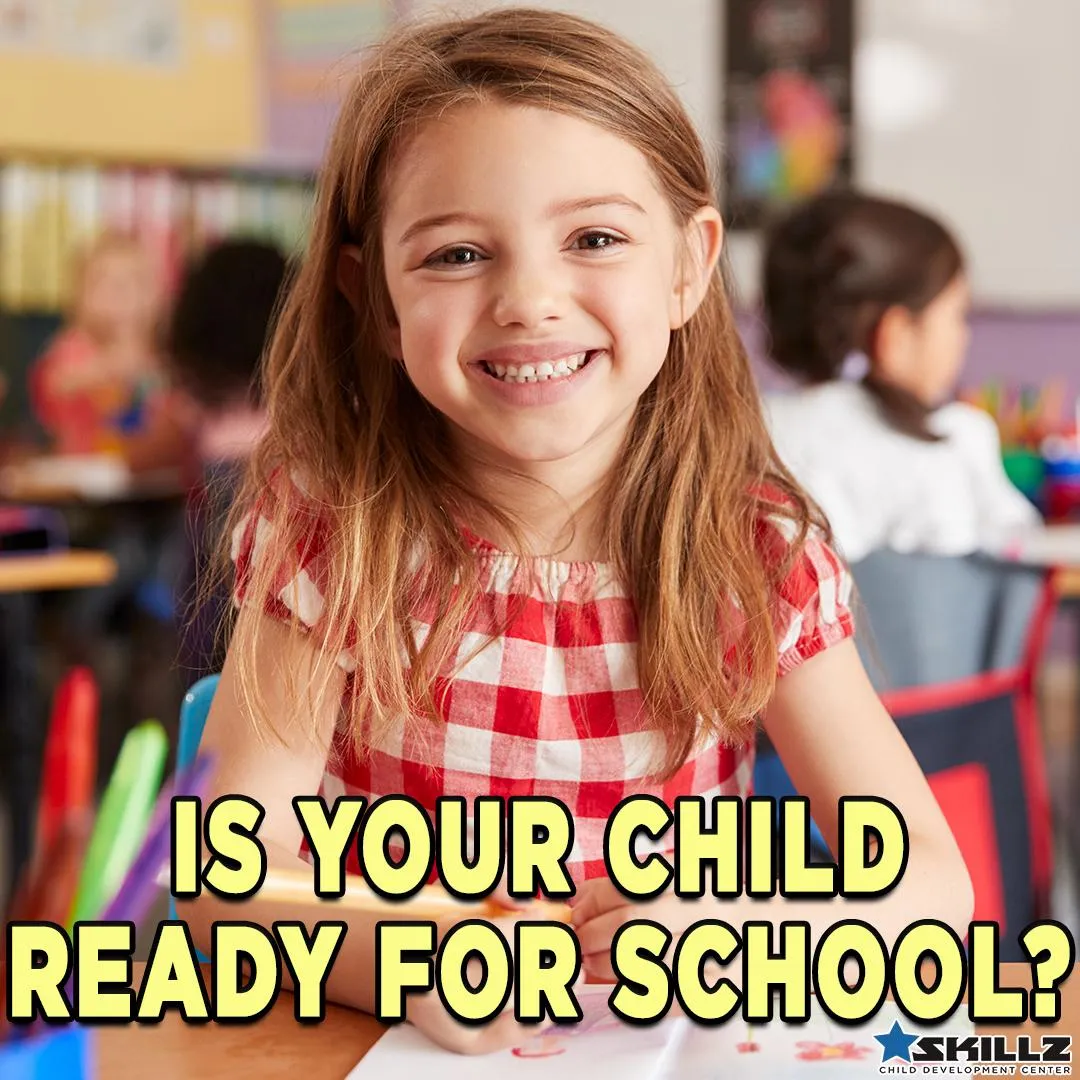
The past year and a half of school have been such a tumultuous ride. From school closures to virtual classes to partial reopening, it seems as if our children have experienced every out-of-the-norm scenario we could come up with. And although the goal was to keep them safe, children’s development took a significant hit. We’ve seen more significant emotional distress, poorer health choices, regression in cognitive momentum, and decreased social skills. So, as the new school year approaches, it is more important than ever to ensure that they are prepared for school in ways that covers all developmental areas.
The idea of “school readiness” has always been mostly referenced when related to cognitive skills needed for school. However, many studies have found that teachers aren’t as concerned with these things and feel that it’s more important that students function in the classroom by being confident, independent, and able to self-regulate. To prepare for this, it’s crucial that parents implement strategies now to give their children a jump start before heading back to school.
Physical: While we have focused on handwashing and minimizing germs, many other healthy habits went out the door. Sleep, nutrition, and physical activity were all put on the back burner. But for children to be successful in school, parents need to begin implementing healthy habits again, such as early bedtimes, nutritious meals, and activities.
Intellectual: The combination of the summer slide and the COVID slide has been detrimental and contributed to even more learning loss. And although everyone feels a rush to make up for this, it’s important to ease back into learning and avoid the “cognitive cram.”
Emotional: With all the unsureness, children have experienced anything from anxiety to depression to lack of motivation, among many other emotions. The constant emotional shifts have left everyone feeling uneasy, including parents. Therefore, it’s so important for parents to role model appropriate reactions.
Social: In the beginning, social interactions came to a complete halt. And even when some social interactions began again, they were very different than before. It seems as if no one has been sure of what is and isn’t appropriate, so social anxiety began setting in. Children need a refresher course on social skills to get them feeling more secure again.
Finding fun, creative ways to get children back on track and ready for school will help them feel more confident again. The SKILLZ Child Development Centers’ approach is a whole-child focus through fun and developmentally appropriate classes. The goal is skill development physically, intellectually, emotionally, and socially. In this program, children are exposed to physical training, cutting-edge brain training, a supportive environment, and age-appropriate social interactions. All these things, combined in one class, provide the most benefit to children in their development. This is especially effective for reigniting the learning process and building relationships again.
Any new school year brings about some amount of anxiety. The start of this new school year will bring about mixed emotions, as well, and will be clouded by some insecurity. Students must be prepared when they enter the classroom this year and are excited and empowered. To do this, ample preparation is key, and we should approach our children’s development with a flexible mindset to create a safe space for them to reclaim their skill level and feel confident again.
Movement
Reducing the Effects of Sitting

There’s no denying that advancements in technology have made our lives easier. We can work from home, shop online, and watch newly released movies, among many other things, all without leaving the couch. And while this saves us travel time and hassle, it can lead to unexpected health consequences. The reason is that we are sitting for prolonged periods, which can deteriorate our bodies. Even worse is our children are also sitting a great deal, so they are now faced with the same issues that adults have been. Therefore, children need to keep their bodies moving throughout the day.
The human body is like a machine. If we sit too long or too much, our bodies become rusty and aren’t easy to move. The significant damage that can result, over time, can lead to heart disease, obesity, posture issues, neck and back pain, and poor circulation, to name a few. Children today are not only sitting in school but for much of their evenings and weekends. This is all thanks to technology. But not only are they more prone to developing diseases earlier, but studies have also shown that sitting can negatively affect their mental health as well. In addition, sitting causes fatigue, affecting concentration, which is a necessary element for optimal learning and retention. Prolonged sitting also makes it difficult for the vestibular system to develop correctly, leading to a disorganized brain and lack of spatial awareness.
The good thing is we can counteract these effects with movement, which increases blood flow and creates new brain cells. Since fidgeting and poor attention are often symptoms of lack of movement opportunities, it’s crucial to get children up and going as much as possible throughout the day. In school, teachers can take quick stretch breaks between subjects and encourage children to run and play during recess. Parents can limit tech time at home and create opportunities to get moving, such as family walks, sports, or simply outside playtime. By being proactive, parents can reduce the risk of their children developing long-term physical and mental health issues and ensure that they have a solid foundation for healthy habits.
As technology continues to advance, our lives will become easier but at what cost to our health. Machines, especially complex ones like the human body, must be moved daily. Therefore, parents must encourage and role model healthy movement throughout each day. These simple things can instill future health habits while also giving parents and children time to connect each day through activities together.
Parenting the Shy Child
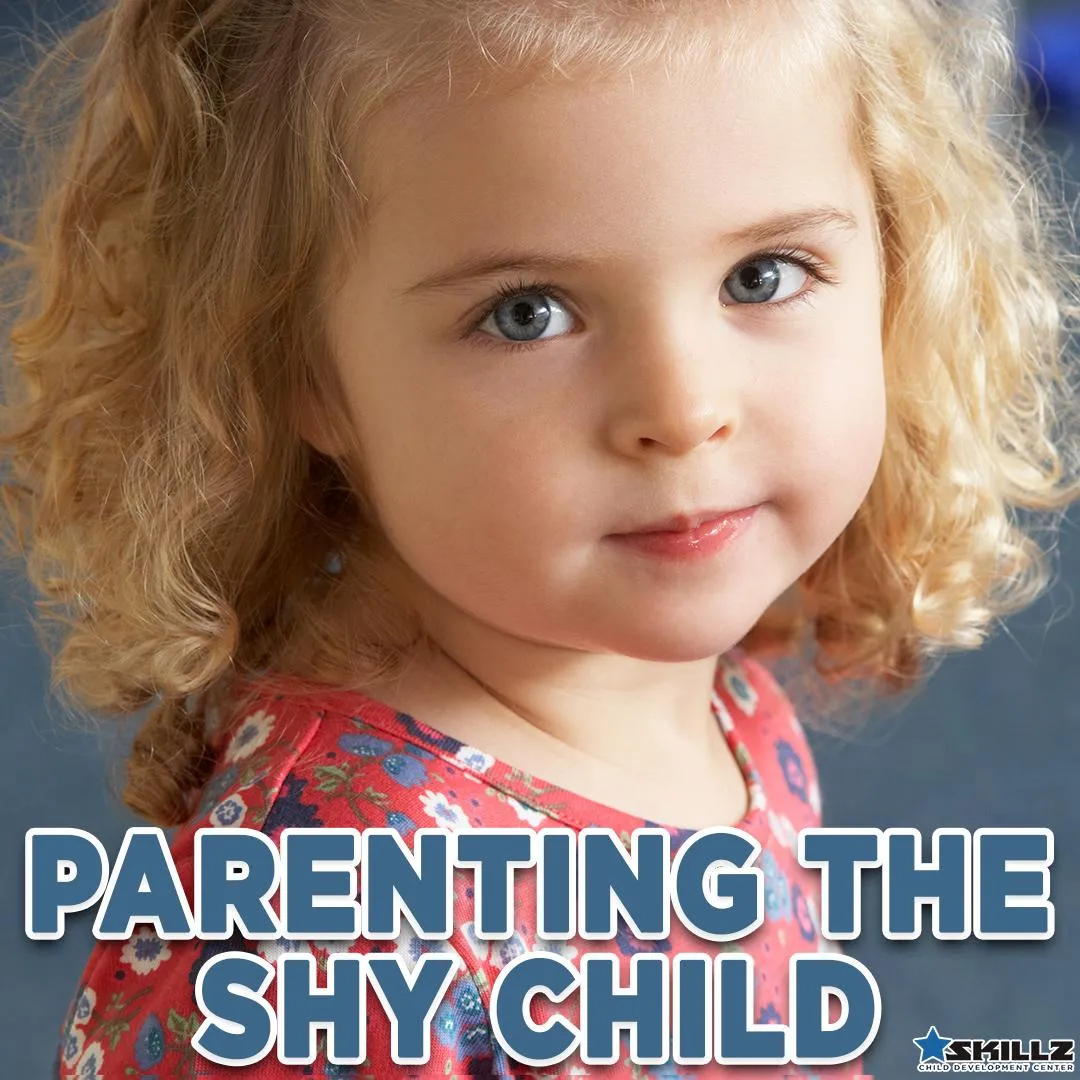
In a world that highly values the traits of extroverted individuals, shy children are often assumed to have something wrong that needs to be fixed. However, shyness is simply a personality trait that is part of their temperament. Children are born with unique personalities, although the environment can play a significant role in how these traits present as the child develops. What is apparent is that shyness falls on a continuum, where children have varying levels of this trait. The important thing is to remember that different character attributes should be embraced to appreciate the unique way a shy child interacts with the world around them.
Children are wired with a variety of traits, and these things affect all areas of their life. Shyness is a trait that most parents are concerned about because they feel their child doesn’t have a good self-image. However, many shy children have a strong self-concept. They are often deep-thinkers and great listeners but also very protective of their inner peace. Shy children with a healthy confidence are polite, happy, and make eye contact. They are just simply quiet and slow to warm up to novel situations and people. And yes, more extreme shyness traits can cause concern, such as avoiding eye contact, behavior problems, and excessive fear. This is when adults need to step in and help.
The key to nurturing a child’s shy personality is avoiding labels and forcing the shyness out of them. This will make them feel like they don’t fit in and think that something is wrong. Instead, be patient and let their personality develop naturally, encouraging them along the way. Appreciating the beautiful qualities of a shy child that is caring and sensitive will make them shine brighter. And when shyness is so extreme, that is genuinely a cause for concern. Exhibiting patience with children and helping them role-play positive social scenarios will be a much more positive approach than forcing them into uncomfortable situations unprepared.
Encouraging environments are vital to the individual development of a child’s personality. Adults must understand that children have different temperaments and traits and that given the best settings, they can develop to their best potential. The SKILLZ Child Development program was created with a whole-child, individualistic approach in mind. Accepting children where they are in development and adapting a way to nurture their temperament is how we help cultivate happy, successful children. Establishing a supportive setting where role-modeling positive social interactions help even the shyest of children develop their personalities with confidence.
Removing judgment and a “fix it” mentality when interacting with shy children will go a long way in reinforcing a positive self-image and helping confidence develop. Nurturing a child’s innate traits will be a more successful approach than attempting to change them, which can have irreversible, long-term effects. Patience and support will allow a shy child’s inner peace to shine so that everyone around them can see it glow.
Regaining Health - Role Modeling Healthy Habits
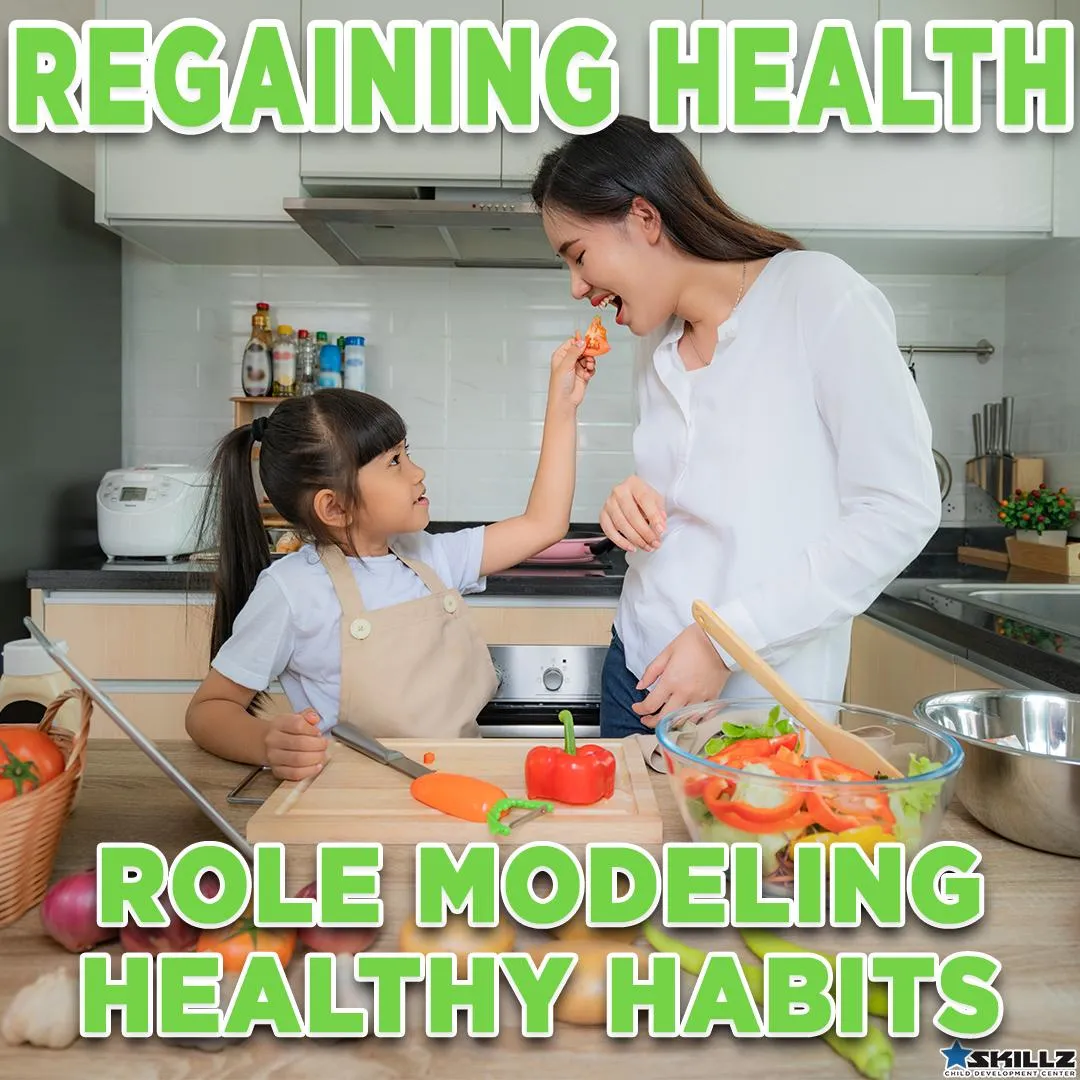
The "Quarantine 15" has been yet another horrible reality of the pandemic. Not only were we separated, from loved ones and friends, but unstructured days, decreased motivation, and increased boredom led to unhealthy habits for families. The result, for many, has been weight gain and reduced fitness levels, which has set the stage for disease and long-term health problems. For children, these habits can carry into adulthood. Therefore, a healthier lifestyle should be implemented now, with parents serving as role models. However, to do this, parents must take a delicate approach to not contribute to their child having an unhealthy relationship with food.
For over a year, children have had disrupted sleep schedules, minimal physical activity, increased screen time, and poor eating habits. The loss of schedules, in general, has led to weight gain in children. During the summer break, children have had an extended period to fall into the unhealthy habit trap. But now that we are getting back into somewhat of a normal life again, the pandemic's health implications need to be addressed. This can be tricky, however, so that we don't cause more fixation on bad habits. Additionally, we must remember that children have varying growth patterns. Therefore, judgment and the need to "fix" a child's weight should be left alone. Instead, parents should role model health habits and are supportive of effort.
Typically, when children gain weight that is more than parents feel "normal growth," they often begin restricting food as the first line of defense. However, experiments done by Dr. Leann Birch found that "overly controlling what children eat can cause them to fixate more on the foods." We need to keep children's overall health as a priority, including mental health. Putting children on diets can cause more harm than good. Instead of worrying about weight specifically, focus on healthy habits, such as fun activities and healthy food choices. As weight drops, physical fitness levels will return to a more normal level. Role modeling by parents is one of the easiest ways to help children create life-long healthy habits.
Since we've all spent so much time sedentary over the last year, the motivation to start may be difficult. Finding fun physical things for children to be involved in is essential, so they stick with it. The SKILLZ Child Development Centers encourage a balance of healthy habits for all areas of a child's development, including physical, intellectual, emotional, and social, all while having fun. This, coupled with nourishing food, will lead to healthier habits and help children feel better overall. The Parent SKILLZ supplemental information goes a step further by helping parents connect, be attuned and patient, and prompt good habits through weekly tips. The parent-child bond strengthens, and then children are more likely to follow the healthy habits of their parents.
As we regain more normalcy in our lives, we must begin returning to healthy habits. Although the implementation of more nutritious food choices and fun activities will give us the right jump-start, we must also remain patient with our children during these adjustments. Encouragement and positive feedback for their effort will go a long way rather than judgment and criticism. The result will be a healthier relationship with food and excitement about physical activity.
Say Yes to Childhood
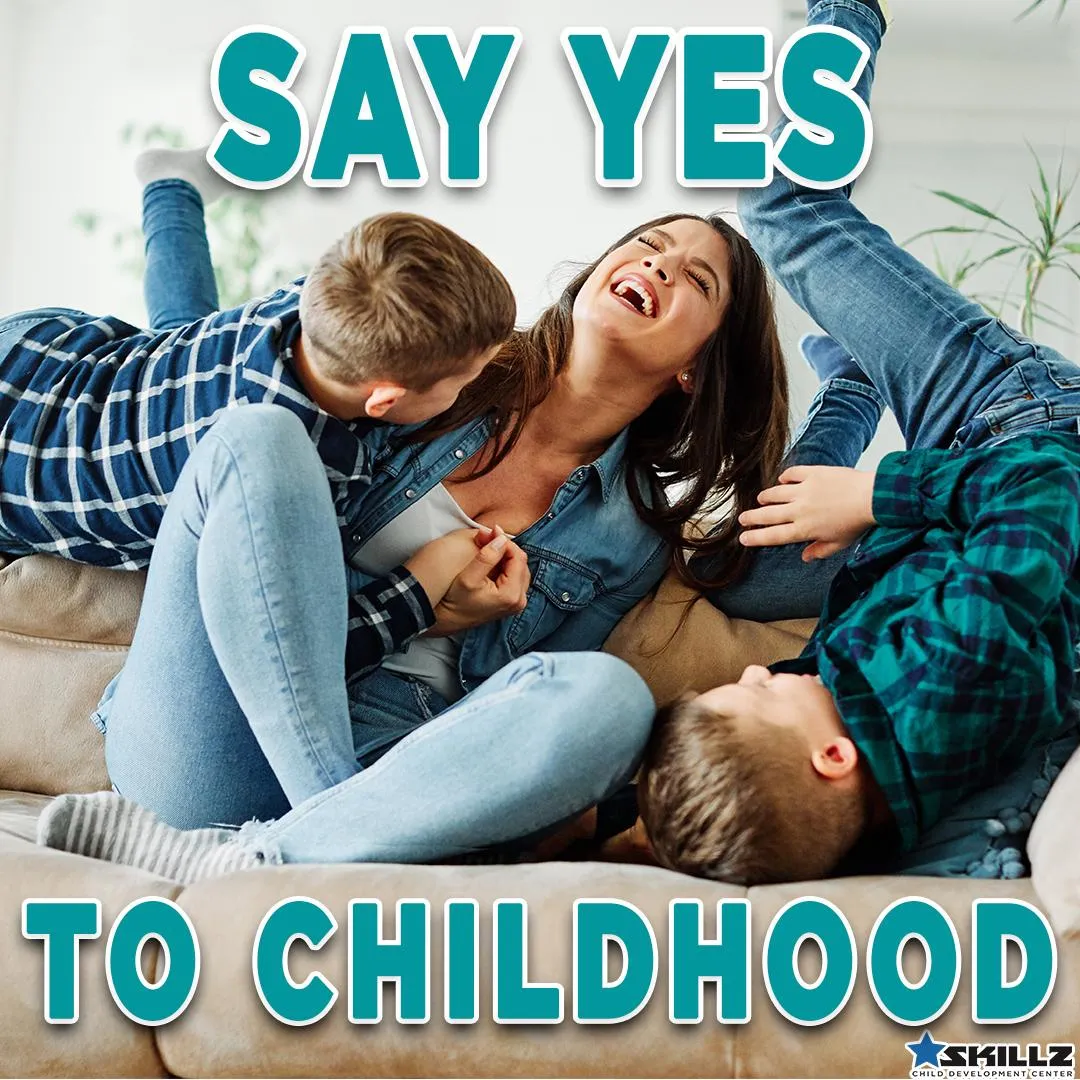
Parenting can be tricky. We want our children to be resilient, empathetic, and able to self-regulate. However, with the busyness of life, the experiences that build these characteristics fall by the wayside, and “no” becomes an automatic response. Children are continually being told what to do and what not to do. As a result, the reaction of parents for many child requests is rarely yes. And, unfortunately, this is typical because they are exhausted, don’t want to be disturbed, or simply because it has become a habit. However, parents should be saying is yes…yes to childhood, and yes to a joyful family.
As we would all agree, children need rules and limits. Therefore “no” is something we need to say. But the more frequently we use the word no, the more children begin to exhibit unwanted behaviors such as tantrums, talking back, and defiance. Remember…behavior is communication. And often, parents aren’t aware of how frequently they say no, and when children become disobedient, parents implement even more rules. However, this approach frustrates children and parents further, takes the joy out of the little moments in life, and suffocates children’s wonder about the world around them. Having a balance of rules and finding moments of happiness within the daily chaos will help children develop better self-regulation.
As parents, it is our job to create an atmosphere for our family. Finding times to say yes, enthusiastically, to our children’s requests will go a long way in connecting and strengthening family bonds. This is not about saying yes to all their requests, however. There still needs to be rules and limits. Instead, it’s about saying either “yes” or “no” consciously and turning off the automatic “nos.” By doing this, parents become more present in the moment, which helps them realize that their child’s requests are a way of connecting. Being open and flexible will go a long way in assisting children in experiencing more joy in their daily routine.
One of the most beneficial programs to help parents find this balance is the Parent SKILLZ curriculum created through the SKILLZ Child Development Centers. The program provides tips on becoming a better parent by implementing eight essential skills in strengthening the parent-child bond. Those include connection, attunement, patience, prompting, edutainment, nurturing, adaptability, and consistency. These easy-to-implement skills are a quick way for parents to be present with their children and have fun while finding joy in the little moments with them. By doing this, bonds are strengthened, and children become more resilient and empathetic.
As we engage and connect with our children, we are saying yes to childhood. Being more flexible and open to our children during daily chaos will help everyone feel happier. As parents, we must remember that there can be joy within the rules and limits that are in place. By choosing to say yes to some of your child’s requests, you express acceptance and create a more cooperative child.
Strength-Based Thinking
Reframing Children’s Challenging Behaviors
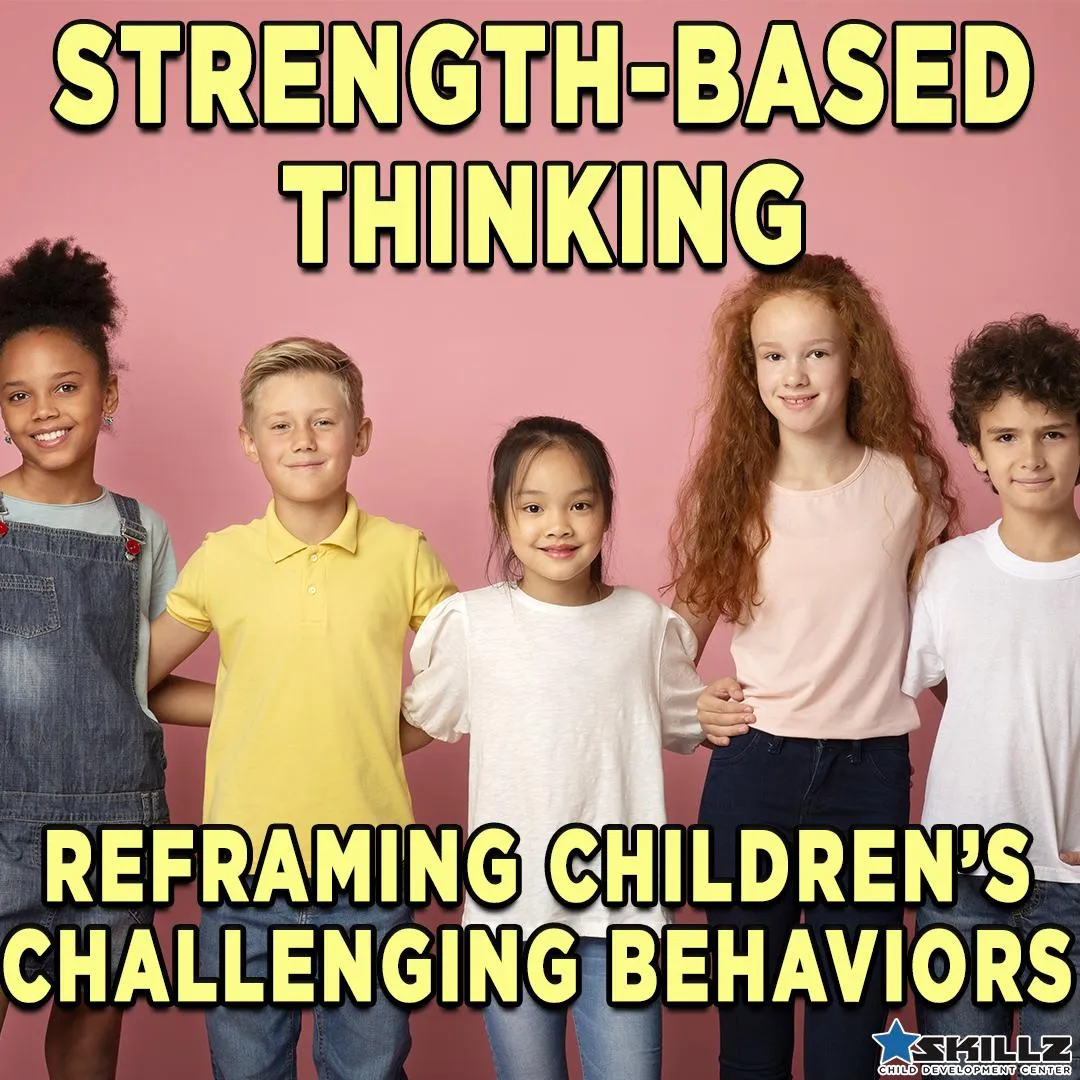
Children’s challenging behaviors have long been the focus of adults’ pessimistic viewpoint of characteristics that don’t fit the mold of societal expectations. This rigid “deficit thinking” causes parents to complain about their child’s qualities and make them try to “fix” what is wrong or make excuses as to why they can’t do certain things. However, these assumptions don’t help children but hinder them and cause low self-esteem and self-efficacy. As they say, “We are what we think we are.” Instead, adults should reframe how they view a child’s weakness or misbehavior and raise the ceiling for them.
Children are criticized daily for their undesirable behaviors. Labels such as overly sensitive, hyperactive, impatient, defiant, etc., are automatically assigned to children when they exhibit actions outside of what is considered “good.” Adults feel that they should address these things immediately to ensure that future success isn’t impeded. But in adults’ pursuit to be good teachers, parents, and coaches, they forget that the child should be the focus. However, the goal should be to understand the child and shift to strength-based thinking to build children up based on their personalities instead of making them fit into what’s considered the norm.
Common complaints among parents regarding their children are that they are sensitive, distracted, playful, or defiant, to name a few. Instead, we should see them as empathetic, creative, spontaneous, or strong-minded. This simple perspective shift redefines undesirable traits and creates an opportunity to nurture each child’s personality. Then, we can begin to look at them for who they are instead of what we want them to be. This fresh perspective will help their individual light shine brighter and build confidence. The goal is not to encourage problematic behavior but to redirect it in more constructive ways.
It’s no doubt that how adults view a child has an enormous effect on their expectations. The SKILLZ Child Development Centers promote an attitude of helping children become “the best version of themselves.” The whole-child focus builds on necessary developmental skills while also encouraging individuality. For example, the Pediatric Ninja Specialists assess each child with curiosity instead of judgment. This allows them to nurture all behaviors in constructive ways that ultimately build the child’s confidence and appreciation of their uniqueness. In addition, the Parent SKILLZ supplemental information provides parents with tips for best parenting practices which improves the parent-child bond and makes parenting more easy and more fun.
When we maintain a positive focus on our children’s behaviors, challenging or not, we begin to appreciate their individuality more. This viewpoint fosters more positive feelings in a child, and their confidence grows. As they feel secure in themselves, their abilities and self-regulation improve because they can channel their, once deemed, negative behaviors into a constructive direction. As Henry Ford said, “Whether you think you can or you think you can’t, you’re right.” Let’s help children believe their behaviors and individuality are good, and their light will shine brighter.
Sensory Processing
How Does Your Child Respond?
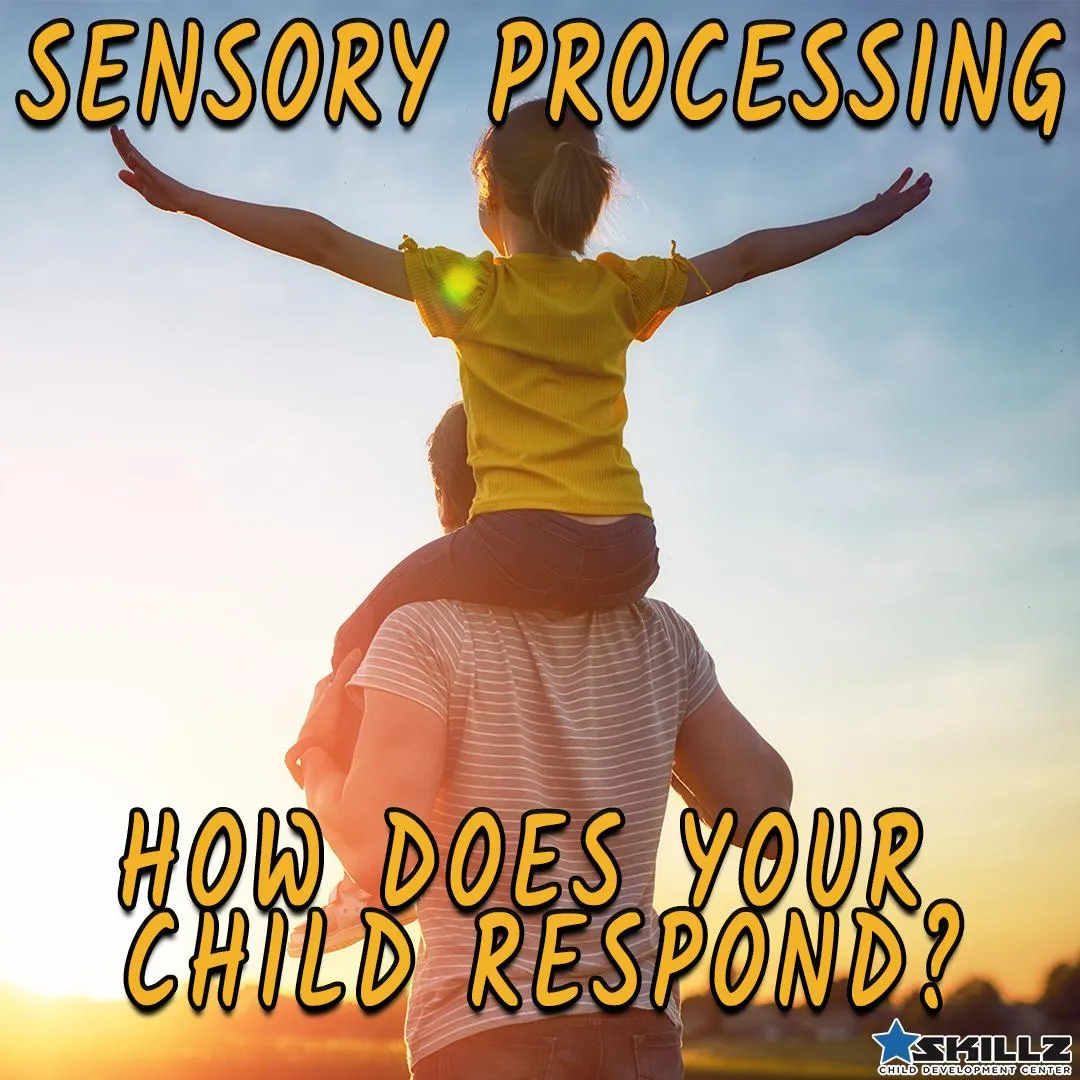
As we navigate the world, we all use our senses to receive input from our surroundings, let our brains process, and then tell us how to react. Generally, we respond with minimal disruption to our routine. However, processing sensory stimuli can be a challenge for some people, either because there is too much or not enough. This can be difficult for children since many experiences are still new, and they haven’t yet developed coping skills and emotional regulation to respond appropriately. Educating ourselves on the variations of how Sensory Processing Disorder (SPD) can present in our children will help us assist them in learning how to manage the way they respond.
Sensory processing the way messages from the senses are received by the nervous system and translated into appropriate behavioral and motor responses. This includes input from sight, smell, hearing, taste, and touch, as well as the proprioceptive and vestibular senses. Unfortunately, the brains of children with SPD get the information mixed up, and, therefore, reactions are often problematic. These things can manifest in various ways depending on the age, setting, arousal level, and how well the child knows how to self-regulate.
There are two ways that children with SPD react to sensory input.
1) Sensory Seekers (hyposensitive): These children under-react to sensory input. They are always in motion and seen as “wild.” They enjoy rough play, make loud noises, constantly touch objects, and have poor personal space.
2) Sensory Avoiders (hypersensitive): These children overreact to sensory input. They prefer quieter environments, are particular about clothing and how it feels, are picky eaters, and can be startled by unexpected lights or sounds.
In addition, some children can show a combination of reactions depending on their temperament and their situation. But no matter how they react, SPD can be difficult on children and interfere with making friends and learning. For Sensory Seekers, their behaviors can be mistaken for impulsivity or hyperactivity. For Sensory Avoiders, their behaviors can be seen as being overly picky or anxious. Therefore, misdiagnosis for another disorder often happens.
To give children the best chance of learning to respond more successfully to sensory input, we must begin by being aware of what processing issues may look like and how best to help each child. The SKILLZ Child Development Center instructors are armed with this knowledge and implement it as needed. In addition, the Parent SKILLZ information gives parents tips on being attuned to their child’s sensory responses, including triggers and reactions, providing ideas for adapting to these things and prompting more appropriate reactions, and suggestions on how to be patient through the process. These things, combined, help work on appropriate sensory responses.
As children grow and develop, their reactions to sensory input or lack thereof will change. And although SPD is not an official diagnosis used by psychiatrists, it is nonetheless a real challenge. Remembering that there can be various ways SPD presents in each child and situation can be useful in helping them learn to respond appropriately and implement better coping skills.
How Motor Skills Affect Learning
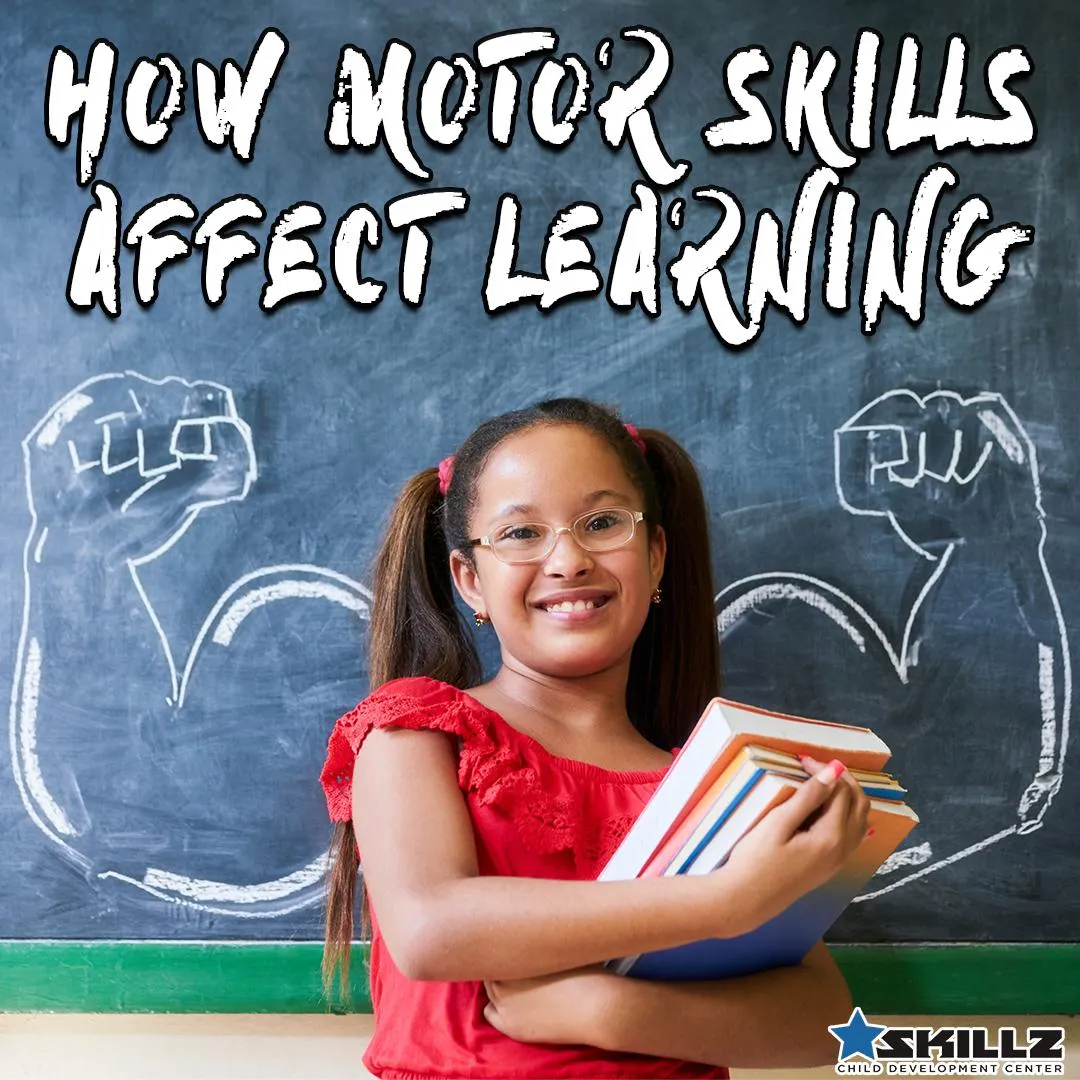
Most are aware of the benefits of physical activity for people of all ages… a stronger cardiovascular system, improved muscle tone, weight management, motor coordination, etc. Additionally, there are brain-boosting benefits that help children with brain function and learning, leading to better school performance. Unfortunately, however, many adults aren’t knowledgeable about the significance of underdeveloped motor skills, especially balance and coordination, on the learning process. Therefore, children engage in activities that boost these skills leading to more learning success.
Although balance and coordination don’t seem like they would directly impact learning, they are linked. When children have problems with balance, which is a skill needed for body control, they fidget more and have bad posture; therefore, they struggle to focus and retain information in school. Balance is part of the vestibular system and is responsible for motor planning and hand-eye coordination. When this system isn’t developed, there is a disconnect between the brain and the body, requiring that children use their focus to keep their bodies calm instead of on learning. Because balance is achieved through our center of gravity, girls tend to have better balance than boys. As a result, boys are observed to be more fidgety and active in classroom settings.
Since children need to be successful in school and feel confident in that setting, our goal should be to make balance and coordination automatic so brain space can be better used for learning and retention. During physical activity, areas of the brain that are triggered during coordinated motor activity are also sparked during some cognitive tasks. In addition, exercise stimulates the Brain-Derived Neurotrophic Factor, which is a protein that is involved in changes to learning. The hippocampus, the learning center for the brain, also increases in size during exercise and the pre-frontal cortex activates as well. Therefore, consistent engagement in gross motor development improves attention and memory, necessary skills for learning, and better school performance.
While most sports help develop physical skills, the SKILLZ Child Development Centers take it a step further. The innovative curriculum was strategically designed with the brain in mind. Not only do children master gross motor skills for their stage of development, but classes are taught in such a way that activates neural connections in the brain, stimulates working memory, and fosters fluid intelligence. This groundbreaking approach not only develops physical skills but also trains the brain. As a result, children participating in this program have increased self-control and confidence, increasing school learning success.
When children have good coordination and balance, sitting still takes less brainpower and focus. This gives them the brain space to concentrate on listening to their teacher and processing and learning new information. Strategically designed gross motor skills development programs can aid in this and help students become more physically developed while also giving them a better edge with learning. Consistent engagement is key and the earlier a child becomes involved in focused gross motor development, the better.
The Secret to Developing Well-Rounded Athletes

Over the last year, sports programs have had shortened seasons, if any at all. Because of that, training time for athletes of all ages has dropped significantly. Now, with sports returning to a more normal duration, young athletes are working hard to regain lost skills and recondition their bodies. The problem, however, is that lengthy breaks increase the risk of injury upon returning to training. In addition, when athletes specialize in a sport, they generally only train muscles for that sport. To be truly at the top of their game, young athletes should engage in training that develops all muscle groups through a system designed to meet their athletic and developmental needs.
When athletes are on an extended break from their sport, their body deconditions, and they lose cardiovascular power, muscle strength, speed and agility, and other skills. As we generally see, after a “normal” break, athletes go back into training at a high level which usually increases their risk of injury. With COVID, breaks have been longer, and training hasn’t been as extensive as it was in prior seasons. Coupled with the lack of cross-training in sports in general, young athletes are currently at a higher risk for overuse injuries, leading to further setbacks. To truly recondition their bodies, they need to take it slow and build skills back in a steadier approach.
One of the most effective ways to help young athletes cross-train is by engaging them in martial arts. This versatile type of training strengthens all muscle groups, develops speed and agility, hand-eye and hand-foot coordination, flexibility, balance, and cardiovascular endurance. In addition, the focus required expands mental acuity, memory, clarity of thought, and confidence. The multi-dimensional approach to training is beneficial to athletes in any sport. Even better is martial arts is a year-round program. It can keep athletes at the top of their game during the on and off-seasons. This ultimately gives them an edge in their sport.
It’s important to note, however, that not all martial arts programs are the same. When working with young athletes, programs should know age-appropriate milestones, brain growth, learning styles, and a myriad of other child development areas. Experience working with children is also essential. The SKILLZ Child Development Centers are equipped with all of this and utilize martial arts training to develop skill development. In addition, a game-based learning format is implemented, so students have fun while building the skills necessary for anything from gross motor coordination to more refined, sports-focused abilities.
Utilizing martial arts as a foundation for athletic development is one of the most effective means for cross-training young athletes to be at the top of their game. Steps taken to regain lost skills and build new ones are done steady, which promotes safety and reduces the risk of injury. As knowledge is gained through cross-training, athletes will remain strong mentally and physically during the on and off-seasons.
Celebrating Each Child’s Uniqueness
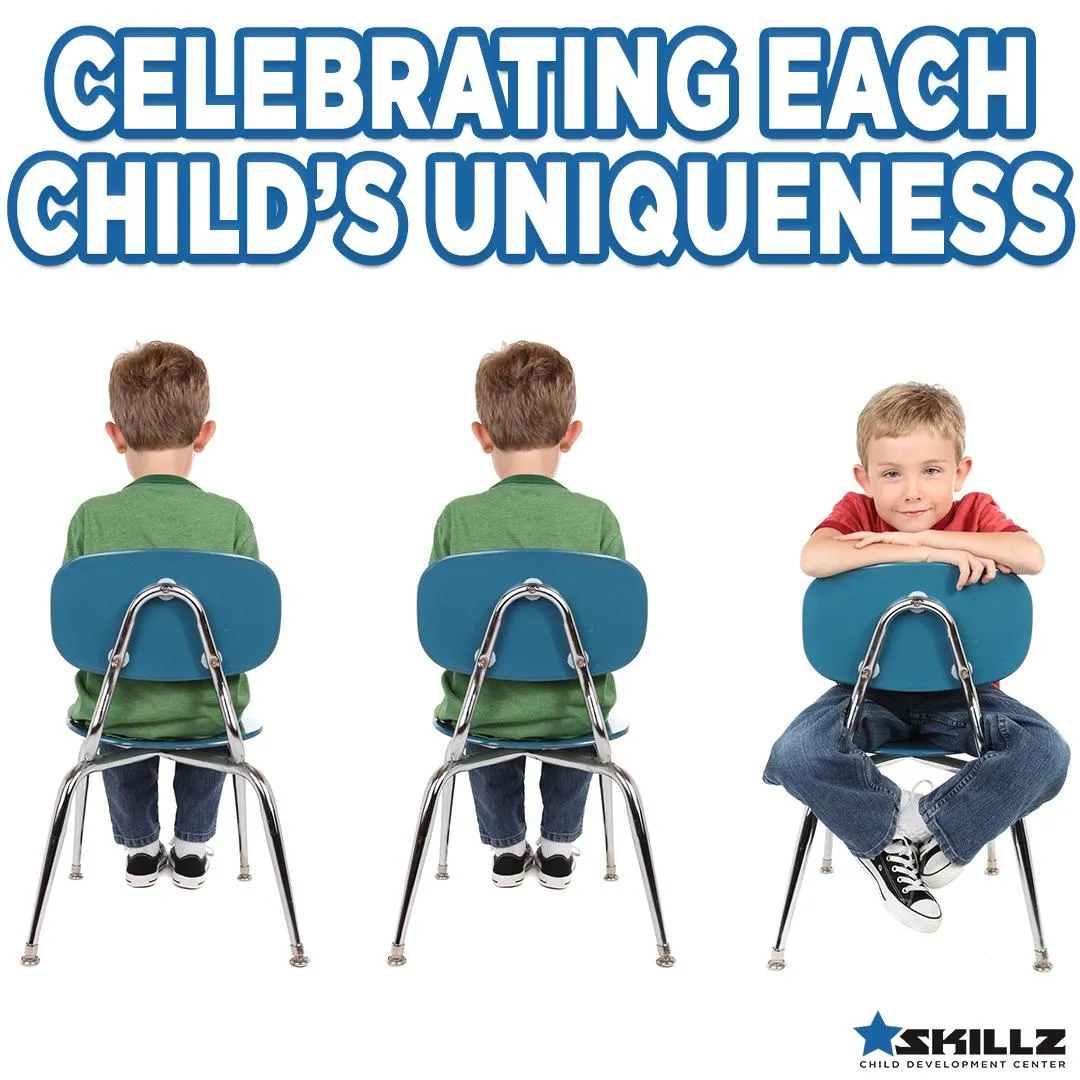
Parents everywhere want their children to achieve success. This is usually defined by fulfilling societal norms, whether in terms of grades, athletic abilities, or something else. And the push to accomplish these things first is putting pressure on children and parents as well. Comparisons are fueling the expectation for children to develop at a specific rate and master skills at a certain time. Unfortunately, this is causing stress and decreasing children's self-esteem. Instead, we should celebrate each child's uniqueness and nurture their individuality by allowing them time to grow into the best version of themselves.
What often gets forgotten is that every child is different. Children have different temperaments, strengths, personalities, and vulnerabilities; therefore, their development will vary. During these stages, it is normal that children might be a little ahead of their peers in some areas and not in others. The problem is that parents often feel under pressure to parent the "right" way to avoid judgment from others. This causes them to push their children in ways that may not necessarily be the best for that child. The constant prodding to not fall behind is counterintuitive to a child achieving the most success. As Bansky, a street artist, said, "A lot of parents will do anything for their kids except let them be themselves."
It's no doubt, parents want their children to do their best, but often "their best" is someone else's best. The expectations that are put on children frequently become unreasonable and creates more anxiety than motivation. This is usually because parents get so caught up in planning their child's future career that they don't allow time for natural talents to develop independently. And while reaching developmental milestones is important, there will still be variations from child to child. However, given the correct nurturing and stimulation, children will catch up, as needed, and go on to achieve great things that are unique to themselves.
There are many programs available to children that can enrich children's skill development in an area. However, the SKILLZ Child Development Program offers a curriculum that develops the child physically, intellectually, emotionally, and socially. Classes are age-specific, and techniques are implemented so that children can reach age-appropriate goals but also have the chance to advance to higher levels quicker. This individual-based approach allows for all children to feel successful and develop their abilities at their own pace. In addition, the game-based learning approach makes classes fun and engaging, which not only takes the pressure off but allows children to feel proud of their accomplishments.
We must remember to slow down and meet children where they are in their personal growth. By appreciating each child's uniqueness, we can nurture their individual development, which will create more motivation in them. This will increase their confidence and help them achieve more remarkable successes. Keep in mind, "Every child is gifted. They just unwrap their packages at different times."
Rebuilding Social Skills During the Summer
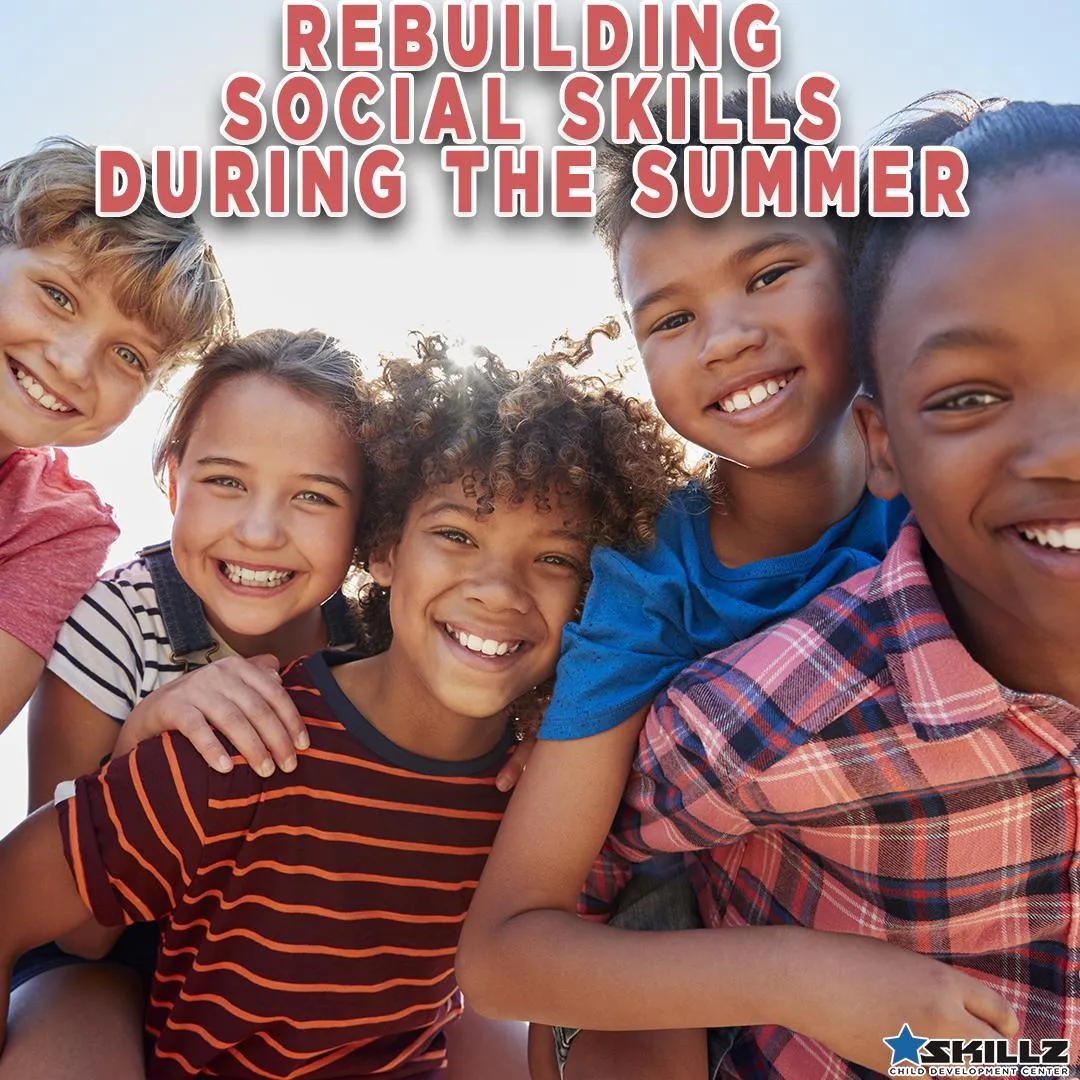
There’s no doubt that children’s social skills have become rusty over the past year and not progressed as they should have. With more limited interactions than usual, children have experienced adverse effects on their social development. And while many children have had the opportunity to engage in some school setting and/or activity, there were still restrictions on what type of interactions they could have. Now, as reopening efforts continue, it’s imperative we use the summer to help children regain lost social skills and build new ones. This will give them more social confidence when returning to school in the fall.
With all the changes to our lives in the last 12 months, anxiety surrounding social relations has increased and caused a sense of unsureness, especially for children. School settings and extracurricular activities have always been where children develop most of their skill set for social situations. With the lack of opportunities during the past year, progress has not only been halted, but many children have taken a step backward in their age-appropriate social development. Knowing this, parents and teachers can now begin helping children rebuild these skills. Providing opportunities this summer is the perfect opportunity to help children get a jumpstart before school starts.
Since we know that children need a refresher course to restore their social skill set, parents need to find opportunities to help their children do this. A few things can be done at home to get the ball rolling again. Opening a conversation for children to voice their concerns regarding expectations for social situations can help gauge what children are feeling. Role-playing scenarios can help children be prepared for how different types of social interactions may play out. This can lead the way to stimulate their social skills. But as with anything, real-world experience is critical in locking in the skills and confidence.
As we continue to navigate through the apprehension of social situations with our children, we must be patient and attuned to their reactions. Involving them in programs and activities that offer nurturing social environments will help build their social confidence again. This will ultimately help them regain lost skills while also building new ones to get them back to where they should be developmentally. Children can then return to school and activities with a rejuvenated sense of social appropriateness and support in the fall.
Rebuilding Emotional Skills During the Summer
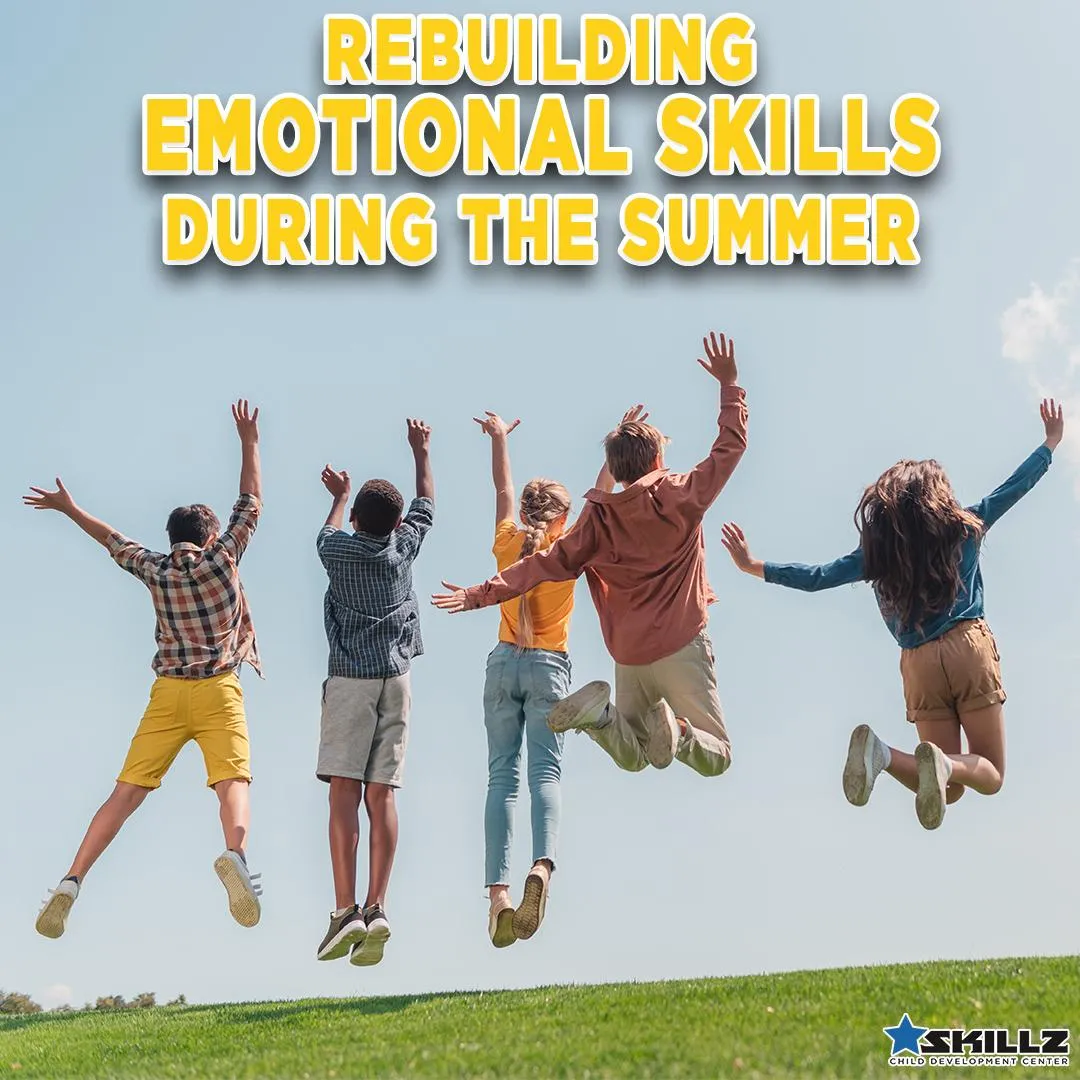
Over the past year, children have faced many disturbances in their daily lives and interactions. These things have contributed to a lot of emotional imbalance and brought on or exacerbated feelings of sadness, fear, and anxiety. Since children are still developing abilities to regulate their strong and ever-changing emotions, they need assistance in strengthening these skills. Providing parents with resources to support their children is crucial. In addition, getting children involved in environments that support their emotional development will help fill the void and rebuild more positive feelings.
The effects of isolation from family and friends have taken an emotional toll on everyone. But for children, the impact was more significant due to the already present lack of self-regulation skills. An essential aspect of this, however, is understanding that everyone has experienced this emotional rollercoaster differently. Children have expressed their distraught in ways ranging from anger to sadness to tantrums and everything in between. This has left parents and caregivers to try to pick up the pieces while also managing their emotional conflicts. The situation has created a more considerable burden on parents and left them feeling unsupported, especially since not all children could return to school and activities.
As we begin anticipating a more “normal” return to school for all children in the fall, we must rebuild and expand on their emotional skills now. The good thing is that we know children are resilient. For parents, this means staying attuned and connected to their children’s emotions as they begin making a shift back to more routine things. To do this, however, many parents may need assistance and direction in getting their child back to a more stable emotional place. Engaging children in a supportive summer program for them and their parents can be a game-changer for mitigating the emotional obstacles present.
As we all continue to navigate the emotional ups and downs of our current lives, finding supportive environments for our children that not only rebuild skills they have lost in one area but skills in all developmental areas is vital. And since parents have taken on a vast emotional load with their feelings and their children’s, they need to have resources and support available to them. If we all take the time to be patient with ourselves and each other, more empathy will be shown, so we all have the space to process things and support each other. Then, our children will develop appropriate coping and self-regulation skills so future obstacles will be less emotionally taxing.
Rebuilding Intellectual Skills
During the Summer
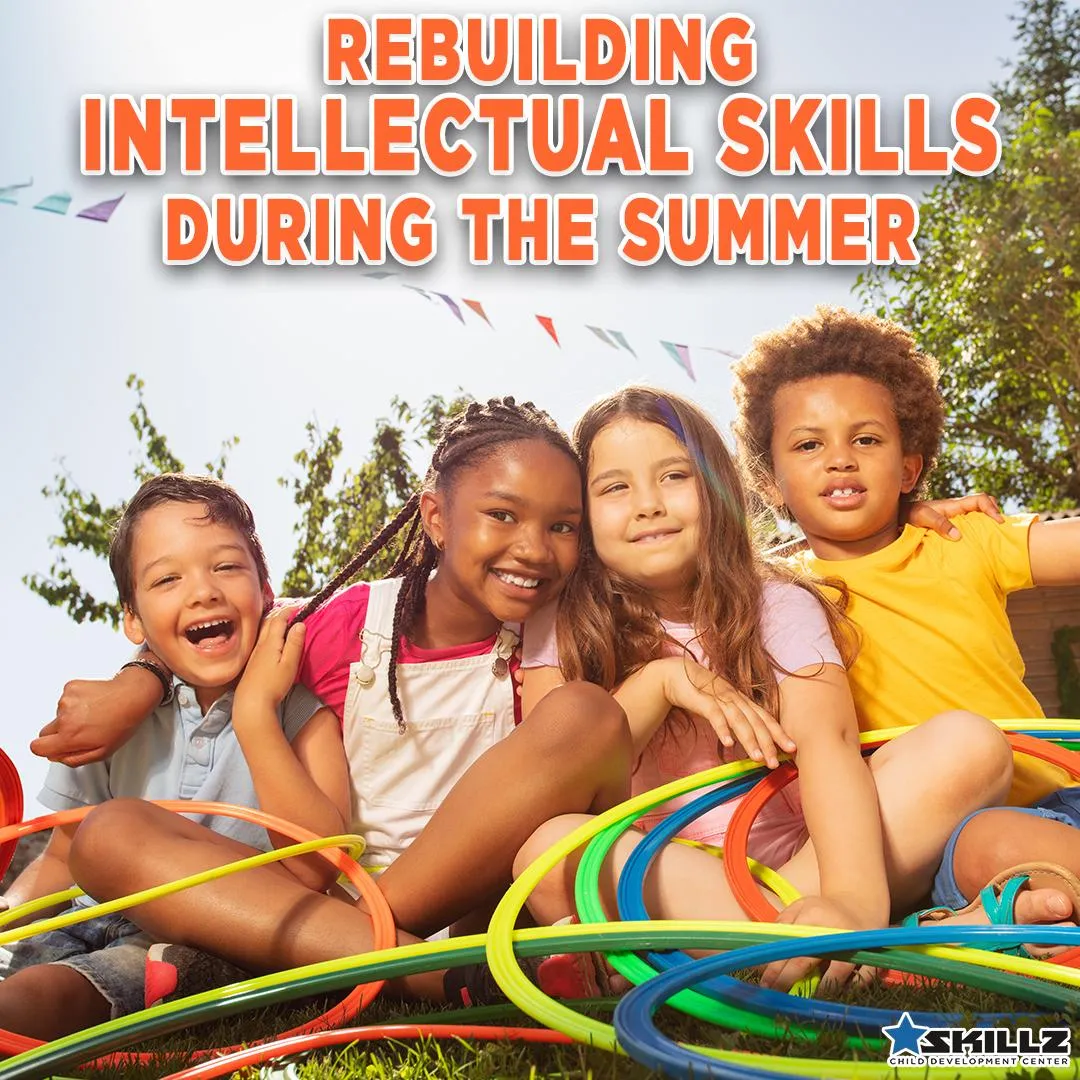
Summer break is typically viewed as a time for relaxation, fun, and no schedules. However, considering the dramatic change in our lives over the past year and seeing communities begin opening back up in a full capacity now, this summer would be the perfect time to get children back on track. As unfortunate as it is, the reality is that most children’s development has been stifled in one, if not all, areas. Cognitive performance has been significantly affected since schools have had limited options for learning, and for some children, these choices are not as conducive to learning. To counteract this, we must engage children in a program that fosters brain development and learning.
As most parents have witnessed over the past year, the COVID slide is a real thing. Children’s cognitive performance has decreased dramatically, and the learning loss that has been associated with this has left everyone feeling the pressure to regain momentum. And while parents and teachers have attempted to implement methods that boost learning, the drastic change from a “normal” school experience has led to extreme detriments in our children’s education. Many experts believe that children, on average, have lost around three months of learning progress over the past year. To some, however, this may not seem like a lot. But when we understand how rapidly children’s brains grow and how all experiences are significant to their development, this length of time can be detrimental.
Now, as progress continues to be made towards loosening up on restrictions, it’s time to get children’s brains rebooted and turn their brain “strains” into “brain gains.” There are a host of tutoring programs that can help children catch up to where they should be academically. However, most of these programs don’t incorporate any motivation or fun. And since we know that children’s motivation is at an all-time low due to the trauma they’ve experienced this past year, it’s best to engage them in a program that not only benefits them cognitively but also increases their motivation while they have fun.
Since children learn best through play, a program that enhances cognitive development in an environment that is safe and fun is the ultimate win-win. The SKILLZ Child Development Centers offer a program that incorporates both of these while also enhancing physical, emotional, and social growth. This 4D approach encourages the most remarkable progress. The use of alternative methods of learning causes active learning to be engaged, thereby initiating working memory. As new neural connections are made, fluid intelligence improves. One technique known as neurobics is very effective in priming the brain for learning. This, coupled with procedures that boost positive chemicals in the brain, gives children the best shot at counteracting the effects of the COVID slide.
As the summer gets underway soon, now is the time to engage children in a program that will boost skills in all developmental areas and give them a jumpstart on the next school year. By utilizing methods that are fun and involve play, children’s motivation will increase and, as a result, their intellectual development will improve and give them the appropriate skills needed to start a new school year.
Rebuilding Physical Skills
During the Summer

For the past year, children have mostly been stuck inside, in front of a computer for school, and on a device during free time. And as much as parents have tried to keep their children active, it’s been a struggle with the limitations of many activities. But now, as communities begin opening back up in a fuller capacity, we must get children moving again. The summer is a perfect time for this. The key, however, is to find activities that focus on the developmental needs of children so they can rebuild any lost physical progress quicker while also developing a higher skill set. This will lay the groundwork for all other areas of development to also be expanded.
The development of fundamental motor skills such as hand-eye and foot-eye coordination, balance, strength, and agility are necessary for a child’s physical development. The vestibular and proprioceptive senses need to be exercised, although they are often overlooked because “safety first” is typically the priority. But children’s activity level is critical not only for their physical development but also for their intellectual, social, and emotional development. It also helps to maintain good health and encourages a healthy lifestyle. These things combined give children the most excellent chance for optimal development.
To give children the physical boost they need for reigniting essential development, participation in activities that build age-appropriate motor skills is vital. Providing opportunities for children to have playtime outside, on playgrounds, or in an organized activity will allow them to exert extra energy, build strength and agility, and engage their proprioceptive and vestibular senses. These things will elevate a child’s physical skills and improve their mood, which contributes to better cognitive growth and produces more positive social interactions. This makes physical activity an essential foundational element for a whole-child development approach.
As the time spent on devices has surged to an all-time high, children must be reengaged in activities that boost their physical development and health. Finding programs that create the best opportunities for this while also enhancing other areas of development will multiply the benefits. As children get back on track with physical activity during the summer, all areas of their life will improve. Then, by the end of the summer, children will be refocused, rejuvenated, and ready to start the new school year.
Single-Focused Tasks
The Key to More Productive Learning
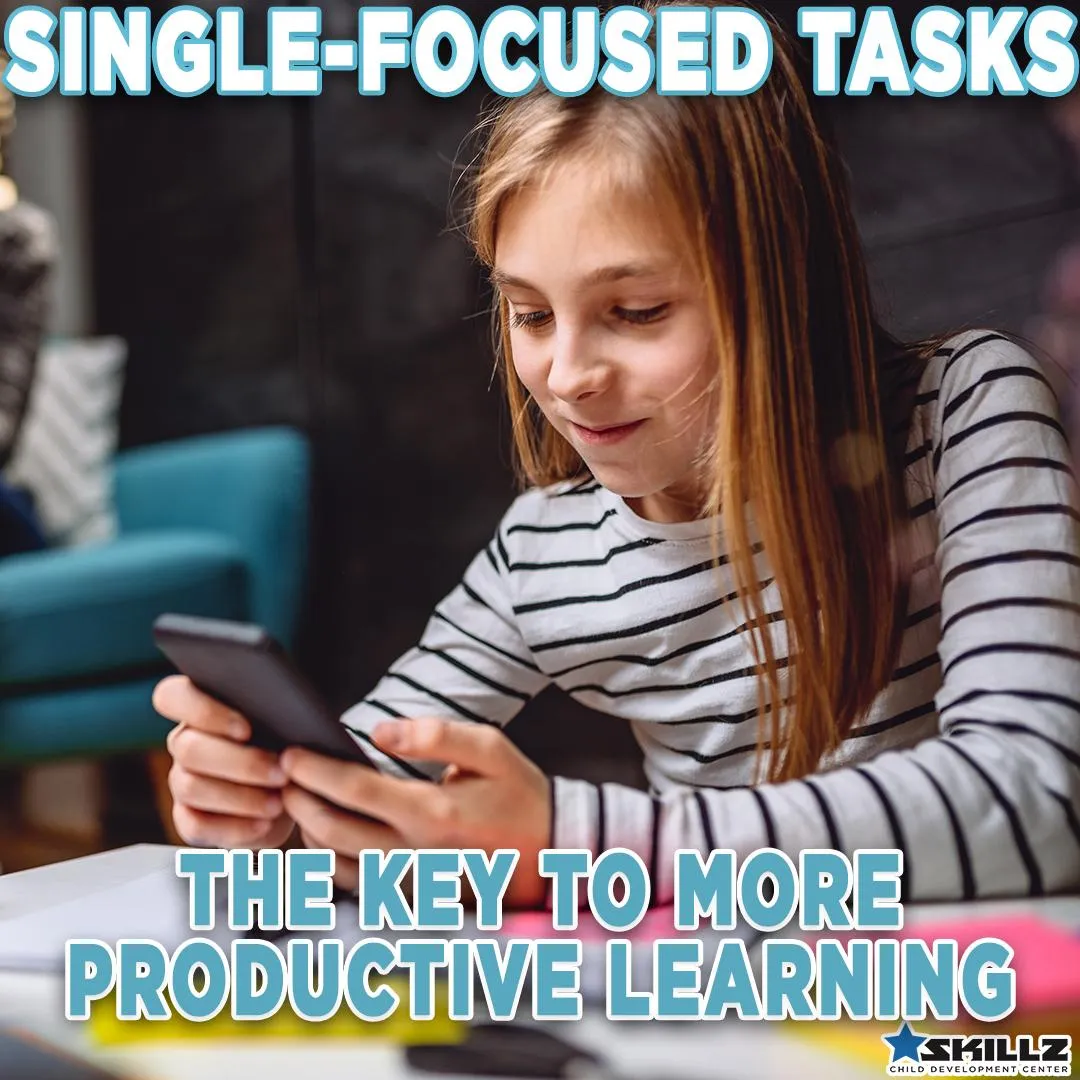
Productivity is one of the most highly regarded traits in the work world today. And to be productive, multitasking is the go-to method. The ability to switch between multiple tasks rapidly is seen as a special skill, but it stifles productivity and increases the likelihood of making mistakes. But with the growing flood of information and technology, distractions are at the forefront of our every step. And while this is affecting everyone, these distractions are most detrimental to children’s developing brains.
The idea of “multitasking” or what is better described as “rapid task switching” impedes not only efficiency but also weakens our ability to transcribe new information into our memory. When we learn new information, we use declarative memory in the hippocampus. When distractions occur during learning, the brain detours from the hippocampus and depends on the striatum, which involves more second nature type tasks. When we switch tasks, our brain must also change from one neural network to another, which consumes mental effort and brain fuel. This keeps children’s developing brains from absorbing new content to the best of their ability.
As Dr. Russell Poldrack – associate professor of psychology at UCLA, stated regarding children, “Even if he learns something while multitasking, his ability to remember what he learns later or use it in other contexts will be diminished.” Also, children make better decisions when they are focused on one thing at a time and make more minor mistakes. But keep in mind, not all task switching is bad. If we are stuck on something, switching to another task can recharge the brain. However, this is different from responding to emails and texts or checking social media while learning a new concept. Additionally, a practical multitasking situation might include listening to classical music while studying.
Armed with this knowledge, the SKILLZ Child Development Program utilizes cutting-edge brain training in every class. To be the most effective in learning new information, the classes are divided into short sections, so focusing on one thing at a time is possible while minimizing distractions. This allows students to grasp a new skill quicker and solidify it into their memory so it can be built on from there. Along with this learning method, boosting positive chemicals in the brain provides an efficient learning process. Parents are also encouraged to use this technique with their children at home during online learning or homework time.
Although a strongly valued concept, rapid task switching is counterproductive to productivity, which it is supposed to enhance. Since it takes time to reset the brain after switching tasks, adults must consider preventing children from learning as efficiently. Therefore, adults must make the necessary changes in children’s learning process for optimal brain development and learning. Minimizing distractions and encouraging a single-task focus will boost performance and efficiency while also saving mental brainpower. Children can then complete their work in less time and without stress while also having more time to do things they enjoy.
Boost Attention Span
by Making Learning Fun Again
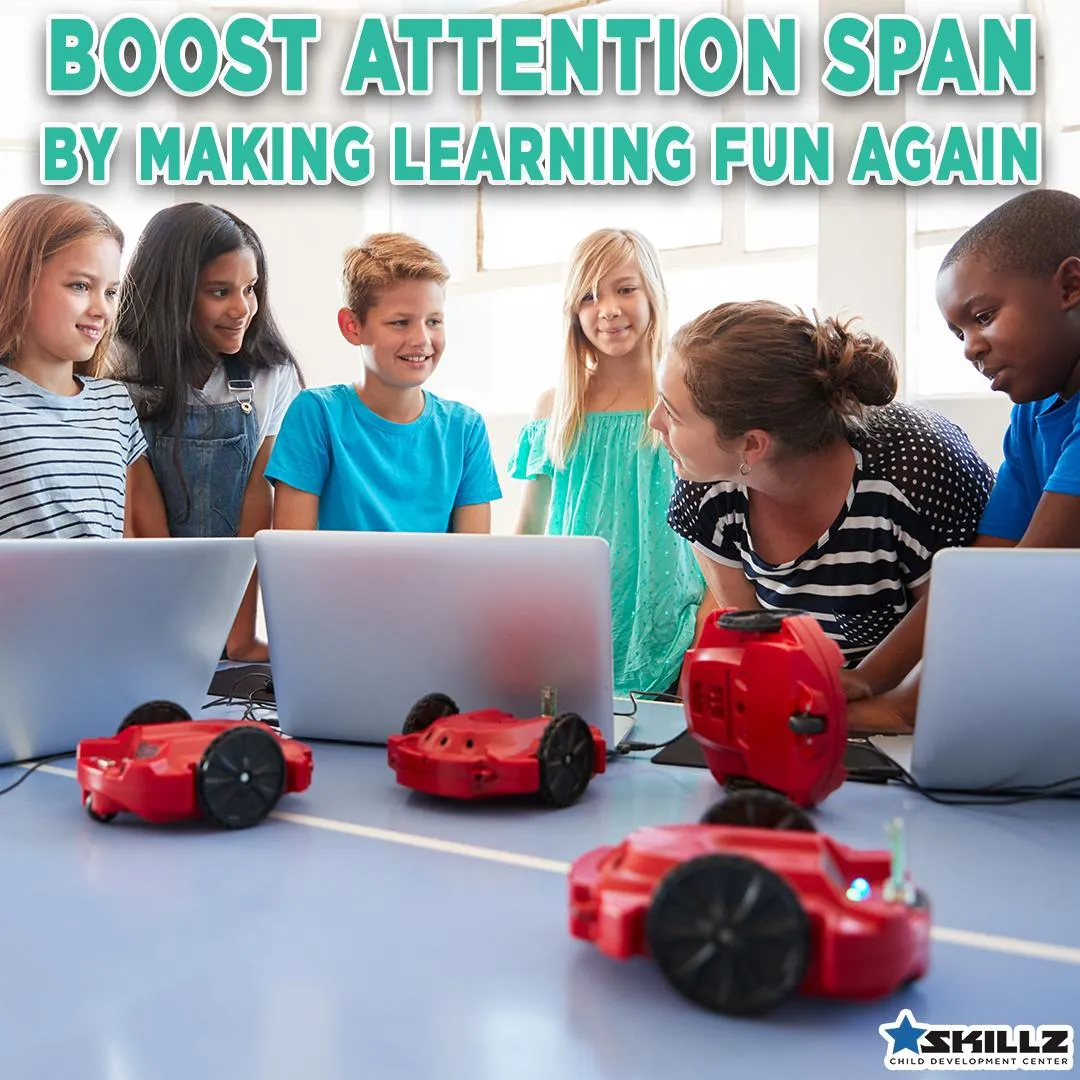
Attention span has long been a topic regarding the relationship between children and learning. As the years have passed, technology has been at the forefront of our everyday lives. This has caused the concern for inattentiveness to become even more of an issue. Children are constantly presented with new and exciting things that catch their attention, so it’s up to adults to find ways to teach new information in an entertaining way. This approach will maintain the interest level of the child so that learning can be cultivated.
Attention span refers to the time a person can focus on an activity. As most people know, this varies depending on the age. The general rule is 2-5 minutes per year of age is how long a child should be able to pay attention. However, to take it a step further, Neal Rojas, a developmental behavior pediatrician, states, “Attention span is elastic.” He refers to everything from the time of day that attention to a specific task is required to actual cognitive abilities and how a child interprets sensory input. Knowing that attention span will vary throughout the day can help adults tune in and make the necessary adjustments or plans to help them be as successful as possible.
When children are younger, adults make everything fun and exciting to learn. However, as children get older, much of the fun is taken away, and learning becomes a mundane task. Expectations go up; enjoyment goes down. Adults must remember that children learn best through play…not just younger ones, but all ages. The SKILLZ Child Development Centers use the following tips to keep children engaged in the learning process, increasing attention span and bringing a newfound excitement to learning again.
1) Gamify: Playing is one of the easiest ways to help children maintain attention and learn. And when children play with other children, it is even more effective. When this technique is implemented, adults find that children learn quicker, are happier, and learning new information comes easier. The SKILLZ curriculum utilizes a game-based learning format to associate learning with a strong positive emotion, which helps them retain information better.
2) Divide It Up: We should have expectations of how long a child should be engaged in an activity and the time frames within each period. By cutting the time into smaller chunks, children will be more likely to stay interested and retain the information better. The SKILLZ program does this by splitting children into developmental age groups in which the class structure is then separated into different activities.
3) Break It Down: When children are expected to complete challenging tasks, adults should take the time to break down the task so that the directions and expectations are clear. The SKILLZ instructors utilize the “7 Steps for Teaching a Drill” to make sure all students are confident of instructions to be the most successful during each activity leading to more satisfaction and understanding.
4) Boost Brain Power: Children’s attention spans can be exercised to become stronger. By engaging them in activities that require concentration, this muscle can be used. In SKILLZ classes, mat chats are utilized to quickly activate children’s learning efforts, and neurobics is used to engage their concentration and thinking skills. Also, positive chemicals in the brain are triggered, creating the ultimate brain power for learning.
5) Praise and Reward: As we know, children are motivated by praise and rewards. They want nothing more than to be recognized for their efforts and success. This is a critical step in maintaining their interest and motivation to learn new things. The SKILLZ instructors connect with each student, prompt, good behavior, and reward skills developed through hard work in each class.
When it comes to attention span, adults must be knowledgeable of what normal expectations are for children. Making simple adjustments to any learning environment can significantly boost a child’s attention span and make learning fun again.
Brain Training for ADHD
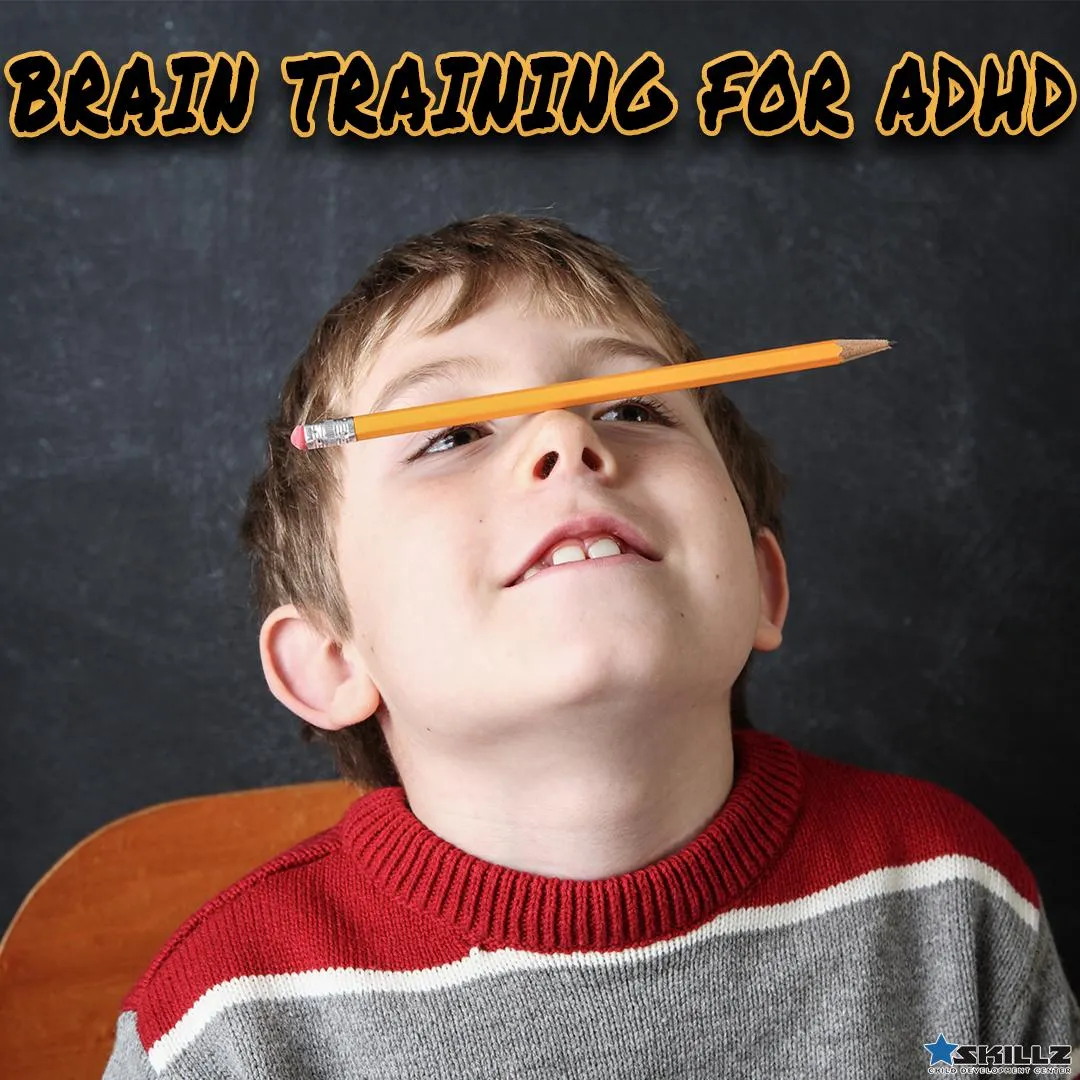
Although Attention-Deficit Hyperactivity Disorder (ADHD) is such a prevalent diagnosis, there are still many misconceptions surrounding it. People often assume that ADHD results from poor parenting, laziness, or some learning disorder. And with these assumptions come a wide range of approaches to “fix” the problem. However, with the lack of proper understanding of this disorder, it’s hard to find an effective method to implement. Becoming knowledgeable about the facts of the disorder can make way for more successful interventions that will build confidence in those children instead of shame.
ADHD stems from an imbalance of chemicals in the brain, largely that of dopamine, but new studies also find low levels of serotonin. More recent brain scans have also revealed that the amygdala and hippocampus of individuals with ADHD appear to be smaller and blood flow is slower to those areas. Since those regions are responsible for emotional processing and executive functioning, it’s no wonder why children with ADHD struggle in areas related to attention, organization, and emotions. Because of these things, the nervous system of those with ADHD functions differently. This leads to a need to be challenged and engaged in something interesting most of the time.
One of the biggest myths surrounding ADHD is that those with it are unable to pay attention. Instead, however, they have dysregulated attention and tend to be focused on multiple things at one time, causing their attention to be split into various areas. This then presents as disinterest, disorganization, or even laziness. This is precisely why ADHD is such a contradictory and frustrating disorder for everyone involved to deal with. In addition, it is very typical for a child with ADHD to be distractable during one activity but hyperfocused on another. Because they have an “interest-based” nervous system, children with ADHD generally only get in “the zone” when in a novel situation, are challenged, or in a competitive environment.
However, even in those types of situations, full attention can be short-lived. The key is to find the best approach for engaging attention and keeping it. Dr. Amnon Gimpel, MD, author of “Brain Exercises to Cure ADHD,” stated, “Any exercises that involve the coordination of complex movement stimulate the brain activities.” This type of “brain exercise therapy” is the same approach that SKILLZ Child Development Centers implement in their classes. Exercise coupled with deep mental focus is the ultimate combination for stimulating neural growth and improving areas of the brain that are deficient in neurotransmitters. The SKILLZ approach of combining a structured environment with exciting challenges, complex movement, neurobics, brain chemicals boosts, and physical activity is just what the doctor ordered to combat the symptoms of ADHD.
For children with ADHD, adults must be knowledgeable about the fundamental truths of the disorder. By understanding that these children don’t have the same motivations as a “neurotypical” child, adults can engage children in activities such as martial arts, which experts believe is better for your brain since it involves complex brain connection as physical movement, which increases dopamine. These things combined contribute to better focus, control, memory, and many other benefits for children with ADHD.
How Can I Help?
Shifting from Judgmental to Curious

In the words of Whitney Houston, "I believe that children are our future…show them all the beauty they possess inside." All too often, the magnificence of individuality is overshadowed by a need to meet the status quo. When a child exhibits behavior that is "problematic" or "difficult," adults often assume the child is defiant. However, often, the child is unable to meet the requirements that are being asked of them. Instead of jumping to conclusions, adults should make an "aspect shift" and reframe how they look at behaviors.
On her powerful graphic "Reframe the Behavior," Kristin Wiens, a Special Education Inclusion Coach, created a way for adults to begin the process of viewing a child's behavior from a "won't" to a "can't, yet." By becoming "stress detectives" and changing the adult's mindset from judgmental to curious, we can make way for a more effective method of working with children. Kristin notes that as this happens, adults begin changing their views and thoughts about the child. Adults then shift from saying a child is defiant to becoming curious about what stressors or lack of skills the child has as a reason for expectations not being met. This simple shift can have dramatic results in how adults approach children and how they view themselves.
As adults' thoughts change, they then begin to respond differently to the child. Instead of thinking of a child as lazy or attention-seeking, we begin to ask questions such as "How can I help?" This leads the way to what Kristin calls "removing barriers." "Find stressors, reduce them. Find unmet needs, meet them. Find skills deficits, teach them." As Dr. Stuart Shanker said, "See a child differently, and you'll see a different child." This approach helps the child feel supported instead of being frustrated and feeling shame. This method supports a growth mindset, which leads to more confidence, better behavior, and more cooperation. It's a win-win.
When children aren't living up to adults' expectations, it's important to remember that they are typically not doing it on purpose. By being mindful of developmental expectations, individual temperaments, varying learning styles, different personalities, etc., adults can play the role of detective. This will allow them to truly dig into what makes each child unique and how to help support them when things don't go as expected.
Quiet Parenting
Stopping the Cycle of Yelling
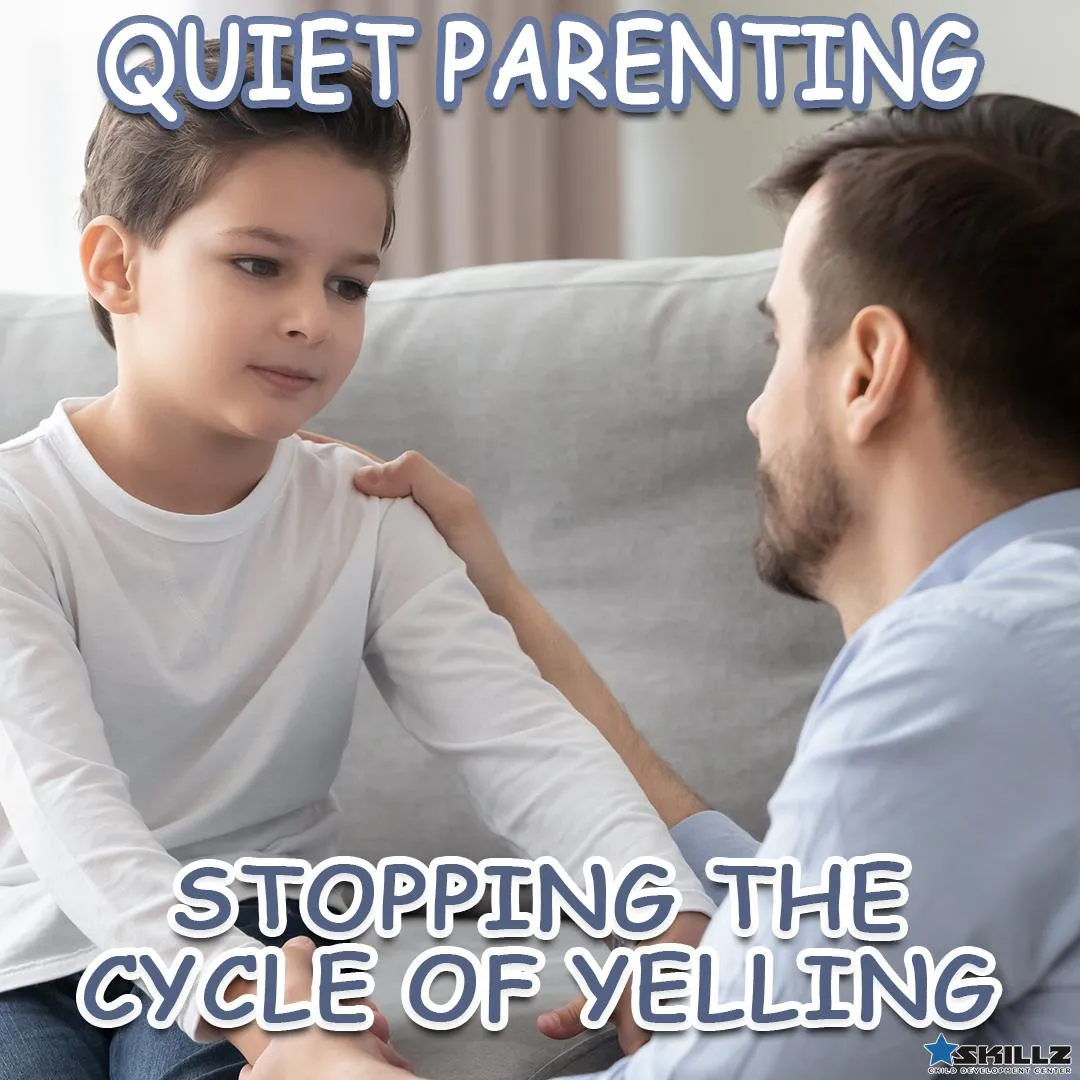
Parenting can be one of the most rewarding responsibilities we ever take on. With that, however, comes the ups and downs of getting children to comply with what we say while being pulled in a thousand different directions. It’s no wonder why parents often resort to yelling when begging and threats are no longer effective. And while yelling is generally the result of needing things done urgently or when the parent feels disrespected, it is unproductive. This approach scares children and makes the parent feel guilty. To more effectively get children to comply, parents should first know their triggers and then plan to parent more calmly.
It’s often difficult for parents to stop and think about the long-term damage yelling may be causing in the heat of the moment. Not only does it model an ineffective conflict resolution strategy to the child, but it also makes everyone feel bad and rarely reduces the behavior. Because children have sensitive nervous systems, yelling can create more anxiety and lead to more difficulty developing healthy coping skills. And yes, yelling may work initially, but gradually children begin to tune it out, and it may even cause the unwanted behavior to continue or even worsen. What parents must remember is that yelling isn’t a form of communication. As parenting book, author L.R. Knost stated, “Yelling silences your message. Speak quietly so your children can hear your words instead of just your voice.”
For parents to take a calm parenting approach all the time, it’s essential to have specific knowledge about themselves and their children and then implement a plan.
1) Understand Normal Behavior: As children go through different stages of development, some behaviors are more typical at certain ages. Knowing these can help parents feel that the behavior is less personal and just part of the age.
2) Know Your Triggers: Parents go through a lot each day and can get overwhelmed. Being mindful of your “triggers,” such as being tired, can help you mindfully prepare. As you monitor how often you raise your voice, you will become more aware of stopping it.
3) Implement a Plan: The best approach is to plan for days that may be more challenging. But the days that are still a struggle show yourself some compassion while also alerting your children and even taking a timeout for yourself.
When parenting involves a proactive approach, yelling decreases, compliance increases, and the parent-child bond strengthen. The SKILLZ Child Development Centers offer a supplemental parenting course designed to help parents approach their children in a calmer yet effective way. All eight of the Parent SKILLZ lessons lay the foundation for the best parenting outcome. When implemented correctly, yelling will become a thing of the past resulting in a more cooperative child and a healthier way to communicate.
The calm approach to parenting requires a lot of practice, and the awareness of our triggers can be painful at first, especially when they come from unresolved issues from our past. However, the ability to exhibit self-control during tense parenting moments can model more appropriate coping mechanisms, send a more effective message to the child, and create healthier communication between parent and child.
Childhood Fears
Developmental Expectations
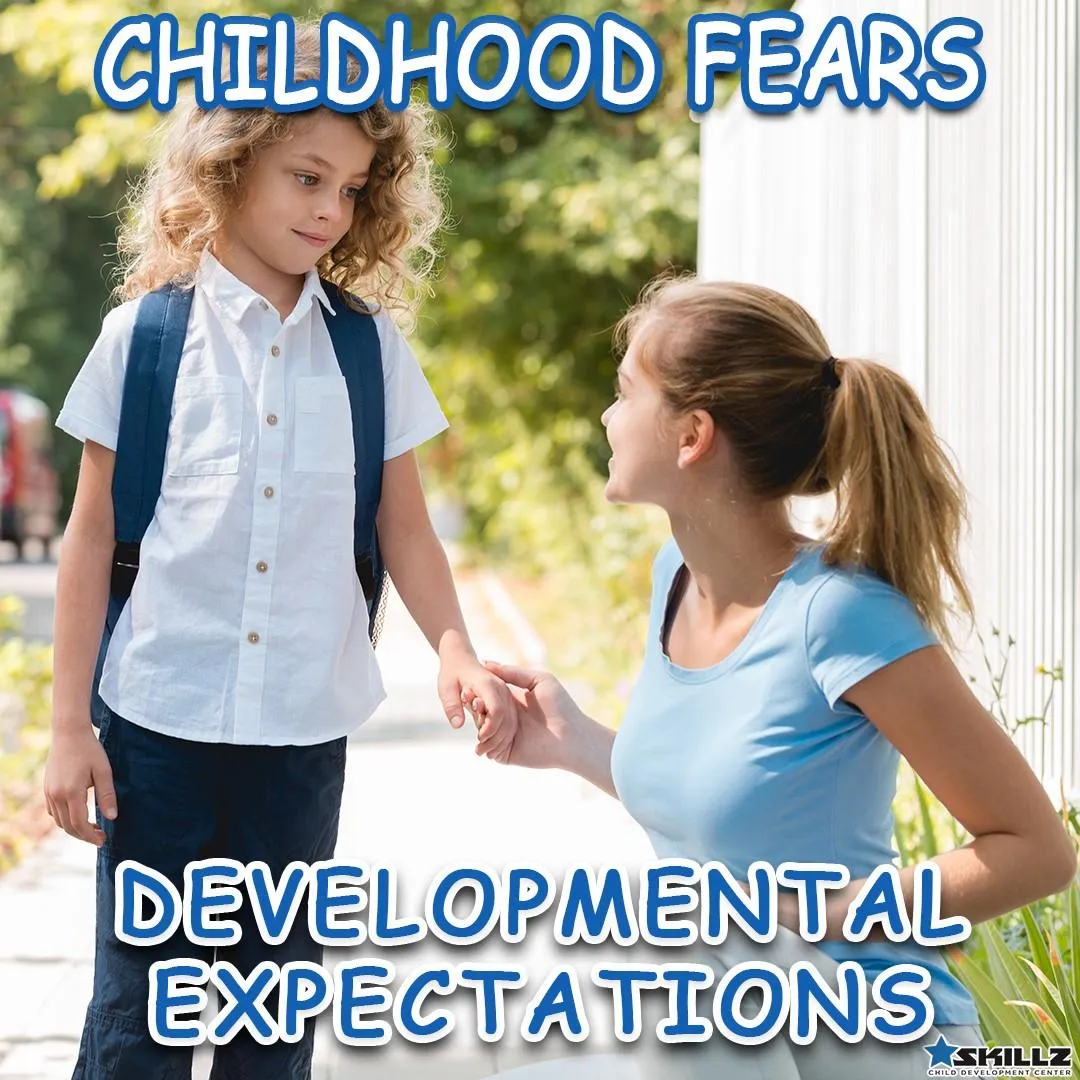
Children of all ages have fears, from babies to teens. And whether these fears are from real or imaginary places, they are nonetheless scary. Since our brains are wired to protect us, fears are a normal part of a child's development. Children will eventually outgrow fears but being knowledgeable about which fears are more common at certain ages will help parents navigate their children through them in the healthiest and most successful way. Having a plan to help children build bravery regarding their fears will help them learn to self-regulate and face other anxiety-producing events straight on.
When we think of fear, we generally consider it to be a bad thing. However, some fear is okay and can help children be cautious and set limits for themselves. But when fear begins to limit a child's ability to participate in normal daily activities and is persistent or overly intense, intervention with a professional may be needed. Normal developmental fears for infants are things such as loud noises and strangers. Toddlers are generally afraid of being separated from their parents. Young children usually fear things such as monsters in the closet and the dark. For older children, fears become more real-life and include things such as bad people and natural disasters. Teens begin fearing failure in school, social situations, and more significant worldly problems such as war.
When parents see their child scared, they generally want to fix the problem. However, often the comforting is excessive and can be counterproductive to the child learning to self-regulate. Instead, Dr. Rachel Busman says that parents should provide their child with "the scaffolding they need to stand on their own." To do this, parents must be uncomfortable with their child being uncomfortable. Validating feelings initially is essential, but then it's time to move on and help them become braver through practice.
How we comfort a child through their fears depends on their age. For babies and toddlers, parents should soothe them with hugs and soothing words. As children get older, asking them questions about their fear and verbalizing it will create an open dialogue for putting a plan into place for facing their fears. A stepladder approach is the best way to go about this. Slowly increasing exposure to events they are fearful of will help children practice while also having a parent's support. And some children will need a little more support than others due to their temperament.
Fear is a normal part of development, and as children grow, their fears change. Being knowledgeable of which fears are consistent with certain ages can help parents better support their children. Understanding this also helps parents balance the right amount of nurturing with a healthy push to face fears. By intervening this way, parents can prevent reinforcing the fear and help children learn to self-regulate.
Playful Connection
Filling Your Child’s Emotional Cup

Over the years, healthy connection levels between parents and children have decreased, leading to more challenging behaviors from children. Today's modern lifestyle has interfered with the opportunity for the parent-child bond to grow. This vital aspect of a child's life is essential for their emotional cup to be full, giving them healthy self-worth and self-esteem. To fill their cup, children need quality connection time with their parents every day. When they receive this, children will develop healthy self-worth and self-esteem and, therefore, approach the world with more kindness and compassion.
The "emotional cup" metaphor created by Upbility, publishers of therapy resources, asks that you imagine children have a cup that needs to be filled with attention, affection, and security. When this cup doesn't get filled, misbehaviors, arguments, and aggressive behaviors may be exhibited. The cup can also be emptied by stress, loneliness, and punishments. Children need positive emotional fuel to get through their day in the most successful way possible. But when their emotional needs aren't met, they will misbehave to get the attention they are seeking from their parents. Implementing ways to keep their cup full will lead to more positive behaviors because children feel secure.
One of the easiest ways to connect to a child and fill their emotional cup is through play. As Lawrence J. Cohen, author of "Playful Parenting," stated, "The single most important skill parents can acquire is playing." When children are babies, parents do just about anything silly to get them to laugh. But as children get older and can occupy themselves, playtime with parents is rare, if at all. Since play is the language of children, parents must learn to play again. Hide and seek, roughhouse and chase are just a few of the types of playtime connection children seek the most. The laughter that comes with this fills their emotional cup and reduces the chances for unwanted behaviors.
As children grow and develop, parents need to continue nurturing the bond they have with their children even as they get older. This continual filling of the emotional cup will help children learn that they are loved, and they will learn to love others. Providing children with quality playtime connection is a proactive approach to parenting that will not only reduce negative, attachment-seeking behaviors but will foster healthy self-worth.
Empowering vs Enabling – The Fine Line of Parenting
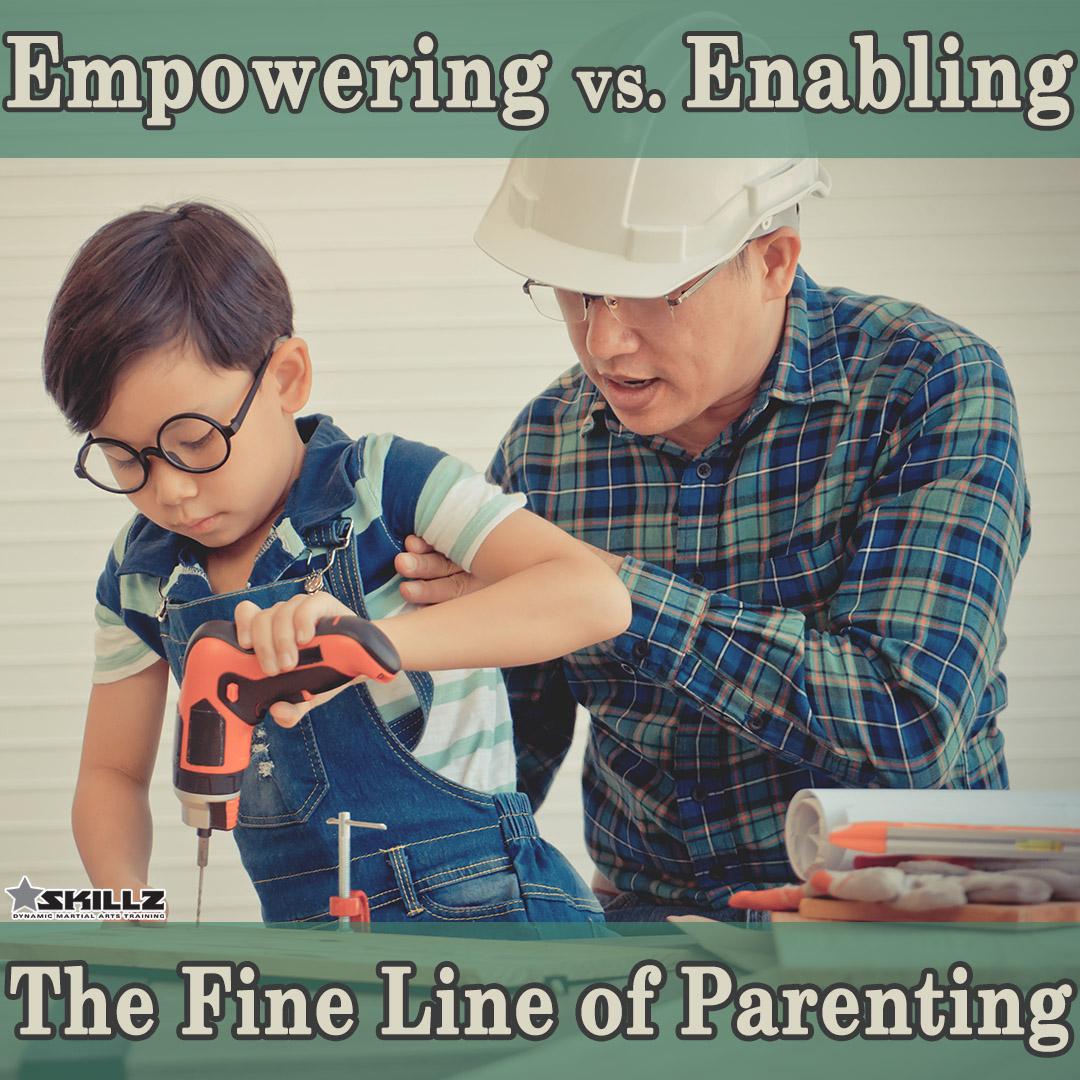
We live in a competitive world and most parents would jump at the chance to give their child every advantage imaginable. The world can also be unkind and, as parents, we feel a need to protect our children from everything possible. And yes, parents are supposed to help and protect their children but when does supporting children turn into over helping? The difference between the two is a very fine line and is often very difficult to decipher.
Responsible parenting means proving food, clothing, and shelter, giving attention and love, and protecting our children from danger. It does not mean doing everything for them and protecting them from anything that may bring them grief. This type of parenting is excessive and can develop due to a parent’s fear, anxiety, or peer pressure from other parents. It can also be a way that parents overcompensate for the difficult childhood they experienced. Whatever the case, although the hyper-involvement comes from a place of love, it can actually hinder a child’s ability to achieve autonomy.
In child development terms, autonomy develops when children can function independently and have choices. Without this, they may experience what psychologist Erik Erikson called “shame and doubt.” This leads to decreased confidence and increased anxiety. And when parents make all the decisions and fix all the problems for their children, those children have underdeveloped coping and life skills. The goal should not be to raise dependent children but, instead, to raise resilient and confident ones.
In order for this to happen, parents must empower their children by teaching self-reliance. The goal is to raise children who are independent and stable on their own. For this to happen children must be allowed to make mistakes and learn to be resourceful in finding solutions to problems that present themselves. Parents can do this by supporting their children without completely removing themselves from the process. It is important for parents to be there for their children as a sounding board. This will help them develop healthy coping strategies and feel more confident in their decision making.
The line between empowering and enabling is a very fine one. But as career and life coach Maura Koutoujian put it, “When a child is enabled, they miss out in the opportunity to cultivate intrinsic motivation - a critical component in developing accountability and self-confidence.” Although it’s hard for parents to see their children struggle, hurt and disappointment are a part of life and children need to develop ways to overcome those things on their own. Supportive parenting should always move children closer to independence and stability which will lead to resilient adults in the future.
The Power of Predictability

As hectic as life is most days, parents are often more concerned with getting everything done instead of strategically planning out their day so that it is predictable for their children. Knowing what activities to expect each day and knowing how parents will respond at the moment is critical in helping children feel safe. The consistency in this will ease children's moods and minimize the chances of a meltdown. Therefore, parents should establish predictability in their daily routines to ensure children have the best chances of a successful day.
When children are unsure of what to expect daily, they often become more anxious and, therefore, demanding their parents' time. Stress goes up, self-regulation goes down, and meltdowns ensue. This leads to more reactive parenting, which feeds into an already difficult situation in which no one comes out happy. When this is a typical daily pattern, children develop more insecurities as the unknown of what the day will bring or how their parents will react is uncertain. Children's temperament also contributes to how they handle things, their attachment to their parents, and the parenting style. The combination of these things can either make or break the day.
Predictability involves repeating patterns to create a consistent environment that fosters self-regulation and growth. The developing brain thrives on repetition, so when a child experiences a positive and predictable environment, they are less stressed, are better able to regulate their emotions, and are more open to learning. It makes parenting more effortless in the long run but only when parents are consistent in their responses to situations that arise. This ultimately takes away the guessing game for children and leaves them feeling more secure. Therefore, consistency and predictability in place benefit children and parents as well.
To begin, parents must implement strategies at home that are predictable. By doing this, children will feel calmer and safer and like they can conquer the outside world with confidence.
1) Morning Routines: Mornings can be one of the most challenging times for families. The rush to get everyone ready for work and school and leave on time is often a challenge. Creating a morning routine that is quiet and consistent provides children with a clear mind, which leads to a better ability to retain new information they learn in school.
2) Midday Routines: After a long day of being away from their parents, children need time to reconnect. Taking just 10 minutes of dedicated time together can relieve any stress from the day and help them prepare for any evening activities.
3) Nighttime Routines: At night, children need time to calm down from the day's busyness and relax. Having predictable routines in place will help quiet their minds, so they feel secure and will fall asleep easier.
Again, the key to creating an environment for any of these things is the predictability of it. When children can trust that these things will happen every day, they will feel more secure and self-regulate. However, if there is an expected change to a routine, parents must prepare children ahead of time. This will alleviate any unneeded stress and allow children to prepare.
The SKILLZ Child Development Centers created their classroom structure based on predictability. The class layout is the same each day, so children know what to expect. Children also feel secure with the Certified Pediatric Ninja Specialists who run each class because they are consistent in implementing reinforcement and expectations in the classroom setting. The Parent SKILLZ supplemental curriculum also provides parents with ways to strengthen the parent-child bond through consistency and connection, which is vital in creating a predictable environment.
Appreciation for a predictable routine is vital to creating an environment in which children feel safe and secure. By doing this, children's self-regulation skills increase, and stress is minimized. The calmness that comes with this gives children the best opportunity to more confidently take on life's challenges.
Teens Need Structure Too

Most often, when we think of implementing structure into our children’s lives, it is because we have a newborn that needs a feeding schedule, a toddler that needs a nap schedule, or a child that needs an activity schedule. When children become teens, they are often left to implement their schedules. And yes, they are on the verge of asserting their independence so that it can be a challenge. However, not implementing structure for them can be counterintuitive and leave them “real world unready.” Therefore, parents must establish boundaries, rules, and structure for their teens to create life-long success habits.
Adolescence is a period of massive changes in all areas of development. During this time, puberty triggers the neural systems, and the hypothalamus sends signals to the body to produce certain hormones. This, along with an underdeveloped pre-frontal cortex, makes way for intense emotions and impulsive behaviors. Not to mention how wacky sleep patterns become, all contributing to testing limits and parental frustration. However, leaving teens to their own devices will most likely lead to more impulsive decisions and, ultimately, trouble. Parents must remember that teens don’t have the cognitive control to resist temptations, and it’s better to steer them towards healthy, positive risks than to do nothing at all.
Believe it or not, teens need and want structure. Since they are already dealing with multiple changes in their bodies and minds, having boundaries in place gives them a sense of security. Clear limits and structure can keep riskier behaviors at bay, especially when parents take the time to discuss these things ahead of time with their teens. And although we may experience some pushback, the life lessons of time management, self-control, and responsibility will ultimately win out. And to top it off, when everyone is on board, confusion and frustration are reduced making relationships stronger while trust is cultivated. So as teens have rules imposed on them, they learn to set boundaries for themselves, thereby increasing their self-control.
As teens travel the pathway to becoming responsible young adults, parents can rest assure that routines and boundaries are powerful, positive influences. And while teens may resist some, they ultimately understand that their route to more freedom comes from the development of trust, responsibility, and accountability. When parents enforce structure on their teens, they eventually learn to manage a 24-hour day independently, which leads to lifelong habits of success.
Should I Worry?
Tuning into Teens’ Emotional Shifts
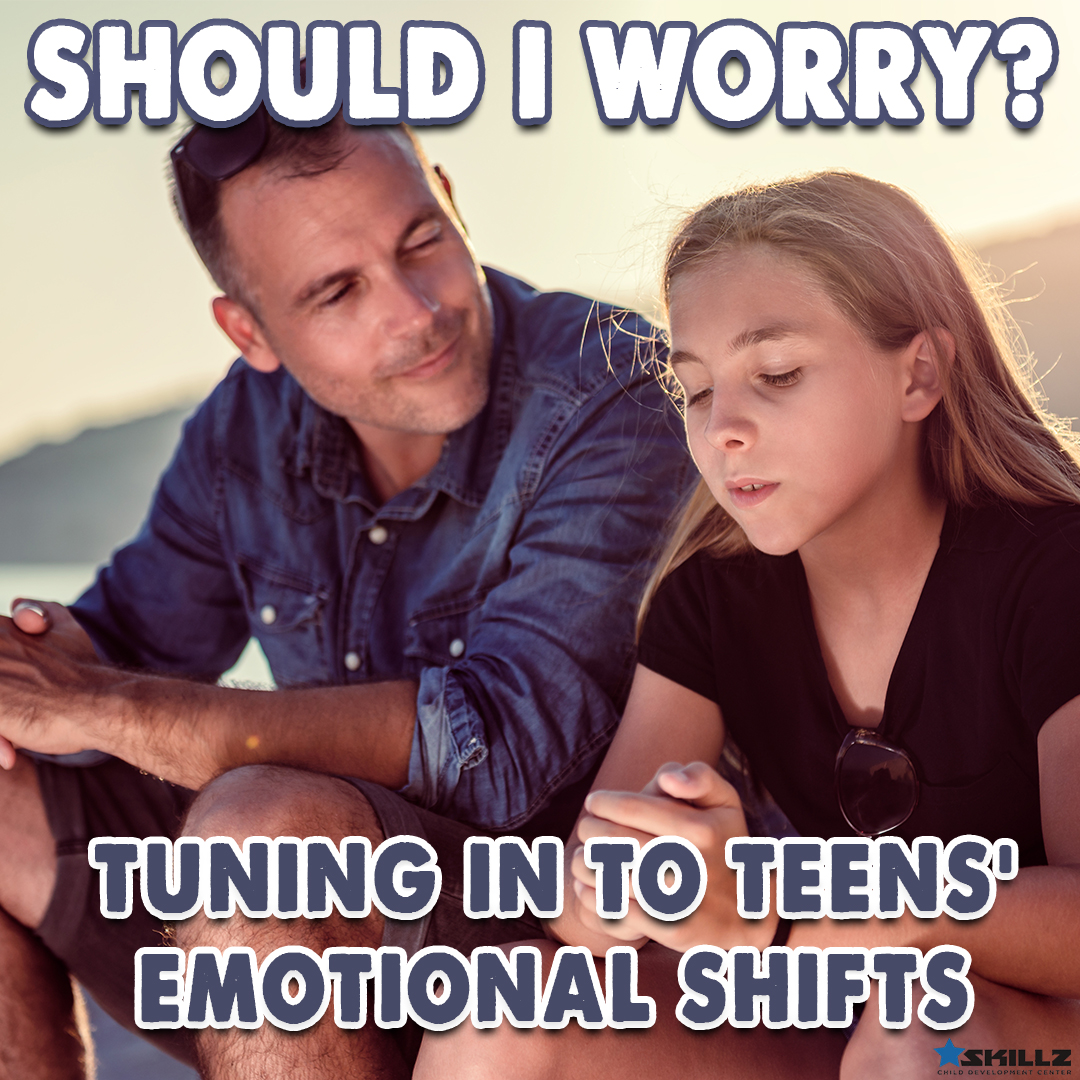
As we approach the one-year mark of an ever-strong pandemic that has rocked our world, we are searching for ways to keep ourselves mentally and emotionally in check. For teens, this has been an even more difficult feat. Adolescence is already fraught with stress and moodiness but adding in the social isolation and fear have led to an even greater rise in anxiety and depression among teens. And while parents are doing their best to manage their own stress and provide for their families, alarming signs of depression in teens are being overlooked. Therefore, it is vital that parents are attuned to their teens “normal” moods and know when they are exhibiting more harmful ones.
As teens grow and develop, it’s no surprise that the raging hormones along with academic, social, and even athletic stressors set the stage for teenage angst. And while it’s not always easy to discriminate between typical teenage moodiness and depression, observing behaviors that are continuous and persistent are cause for concern. Teen brains are already overly sensitive to stress since their prefrontal cortex is still developing. Therefore, the onset for serious psychological disorders is during these years. And even more disturbing is that the beginning of emotional distress seems to now be trickling into younger age groups, generally around age 10.
Our modern lifestyle has, no doubt, played a role in the increased stress in our teens. They typically get less exercise, eat more processed foods, and spend hours on some form of technology or social media. They get outside less and get minimal amounts of quality sleep. And to exacerbate things they are now living through a pandemic that has decreased their social support systems and kept them out of school off and on or indefinitely. So, things that once served to alleviate some of the pain are now gone too. Moreover, experts believe that teens have been raised with unrealistic expectations about the “real world” because many parents have tried to shield them from pain and disappointment instead of helping them develop coping skills and dealing with a problem head on.
Since anxiety and depression present in varying ways, it’s vital that parents are attuned to their child’s baseline personality. Sadness often shows up as withdrawal or irritability. And while moodiness often accompanies typical teen emotions, watching for extreme shifts in their mood and how long these things are lasting can give parents an enormous amount of insight. Now, more than even, it’s essential that parents do daily mood checks with their teens. These moments, however, are when parents should be gentle but persistent while also being ready to listen without trying to fix things.
As a part of the SKILLZ Child Development program, the Parent SKILLZ curriculum provides tips for parents to connect with their child, no matter what age. Being attuned to their normal personality traits can help parents better nurture the bond with their teen through patience and consistency. These things will encourage open dialogue so teens will feel their emotions are taken seriously. Also encouraging a healthy lifestyle with plenty of physical activity, balanced meals, and sleep will help stabilize moods.
Teens often have a hard time expressing how they feel so it’s up to parents, teachers, and other caregivers to identify the signs when moodiness turns into depression. Reaching out to other trusted adults for help with teens and get them talking, is important. Then the uncomfortable feelings that come along stress and other adolescent woes will be more manageable due to coping skills and a strong support system.
Is Your Child Real World Ready?

In recent years, parenting has undergone a shift and has become hyper-focused on the child. And while care, attention, and love are necessary for forming healthy attachments and helping children reach developmental milestones, an over-protective or coddling type approach can also hinder them. Rest assured, this parenting tactic comes from a place of love but to allow children to achieve autonomy, we must allow them the freedom to make choices and learn daily life skills. This will set them up for the most success in the future.
It’s no doubt our world has changed, and our lifestyles are more hectic and fast-paced than ever before. Coupled with the failures, peer problems, disappointments, etc., that children run into along the way, it makes it hard for parents to sit on the sidelines and just let things happen. And often, parents feel a sense of guilt for not having more time with their children, so doing more gives them a sense of relief and creates what they think is a moment of connection with their child. However, when children do not have to face everyday life challenges and are not given opportunities to learn daily life skills, they will be forced to depend on their parents even into adulthood. Dr. Mel Levine, author of “Ready or Not, Here Life Comes,” refers to this as the gateway to “work-life unreadiness.”
To find the right balance, parents should consider their child’s stage of development, individual maturity, and situation. While responsible parenting involves providing all the necessities and love to children, it doesn’t mean doing everything for them. As children grow and develop, practicing newfound abilities will allow them to get better at daily tasks while also learning new life skills to build their confidence. Taking time to teach children life skills, such as tying their shoes, doing laundry, or communicating their feelings, while guiding them through the process will foster more independence and resourcefulness and strengthen the parent-child bond.
In the SKILLZ Child Development Program, the Certified Pediatric Ninja Specialists provide a safe and supportive environment for fostering autonomy. By utilizing Teaching SKILLZ techniques such as “choices” and “intrinsic motivation,” instructors provide opportunities for children to make their own decisions, which gives them a sense of pride and builds their confidence. And when something doesn’t go as planned, instructors are there to help them get back on track. The Parent SKILLZ curriculum also provides parents with methods to implement in everyday parenting that allows for time for connection while also building life skills at home that are necessary for a successful future.
Parenting should always involve love and support, but understanding that this also involves allowing children to tackle the “firsts” of life at the developmentally appropriate age is essential. The constant process of finding the right balance of caring for and protecting children while allowing for the achievement of necessary life skills is vital. Supportive parenting should always move children closer to independence and stability to navigate the world solo and prepare them for adulthood.
Rapid Resets
Quick Ways to Calm an Emotional Flood

As we know, children can lose control of their emotions for various reasons, and the behaviors we witness are generally unplanned. And since anxiety can look like defiance, adults often respond in counterproductive ways. When children are stressed, the amygdala, in the downstairs brain, is triggered, and the “fight or flight” response takes over. This hijacking of the brain makes it hard for children to be reached through conversation resulting in a disruption in the current environment. Implementing rapid resets can calm children and get their brains back “online.”
When children are out of the zone, and their “lid is flipped,” the sympathetic nervous system has been fully activated, and they don’t recognize what is happening. The reactions we see are based on each child’s current developmental stage, communication skills, and emotional competency. Also, some children have an anxious type temperament and are more likely to react in a stronger way.
Luckily, the body has a natural reset button in the parasympathetic nervous system called the vagus nerve. This nerve runs from the brain stem, through the face, to the thorax and abdomen. When it’s stimulated, it sends a message to the brain that it can relax and the body calms down. When children experience a flood of emotions resulting from stress, the vagus nerve has to be activated to get children back to a teachable mindset. Then, and only then, can we begin to engage them in a logical, age-appropriate discussion of the situation and make a plan for next time.
So how do we get children back to a place of reasoning? By hacking into the parasympathetic nervous system with effective methods.
1) Deep Breathing: We all know taking deep breaths is a go-to solution for calming the body. However, Dr. Lucy Norcliffe-Kaufmann, an associate professor of neurology at NYU, suggests long, deep breaths but making the exhale longer than the inhale. The reason: when we exhale, the vagal activity is highest, and the heart rate is lowest. This creates a quicker calming effect. For younger children, this can be more easily done by blowing bubbles or a pinwheel or whistling.
2) Humming or Singing: Since the vagus nerve runs along both sides of the voice box, engaging children to hum or sing when they are in an emotional flood will calm them. This is used much like the way yoga incorporates “ooms” during a session, which brings about calmness by activating the vocal cords, in which the vibration sparks the vagus nerve.
3) Physical Movement: In general, any movement will essentially take the mind away from intense feelings and increase endorphins. However, specific movements can expedite calmness. Cat-cow pose works through the digestive system and spine where the vagus nerve resides. Also, activities that involve crossing the mid-line activate both sides of the brain to work together, so thinking becomes more balanced.
In the classroom, it’s often hard for a teacher to stop everything for children experiencing different anxiety levels, so utilizing rapid resets is critical. This can bring the entire class back to a more relaxed state while also nurturing emotional self-regulation. The SKILLZ program incorporates this by using Teaching SKILLZ, such as redirecting, prompting, and intrinsic motivation. The Parent SKILLZ curriculum is also infused with vital information to keep parents attuned and patient during their child’s emotional floods.
When we teach children quick and easy resets for stressful times, we encourage more emotional self-regulation and promote greater emotional resilience. By doing this, we counteract the dangerous effects of stress and arming children with the tools for happiness and improved overall health.
Nature and Nurture
Influencing Genes for Success
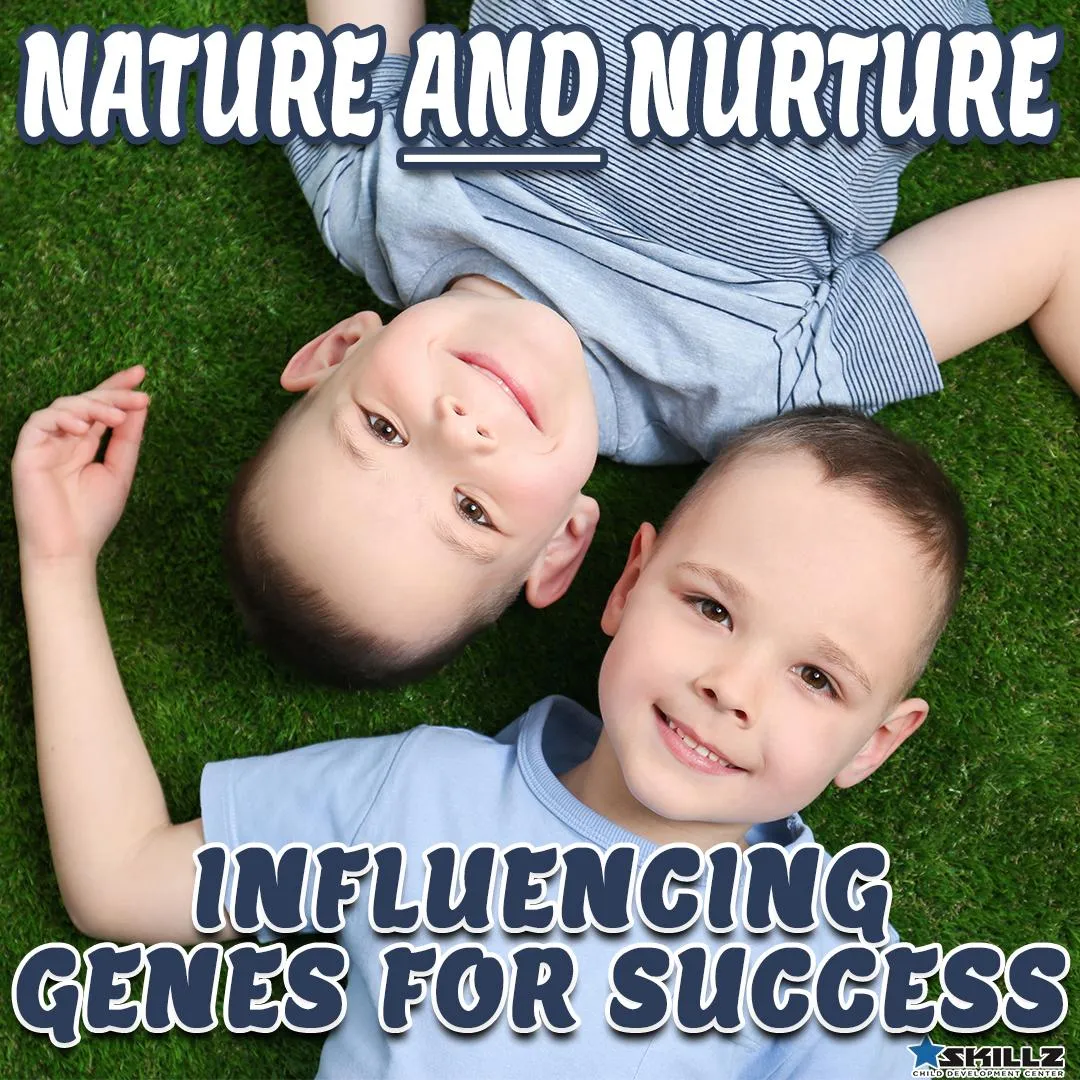
Is it nature, is it nurture? That is the question. This age-old debate, in the world of psychology, has been a source of controversy for decades. At some point, all parents have toyed with thoughts of which one has most influenced their child concerning personality traits, abilities, etc. And while different psychology fields have distinct beliefs, studies have shown that this debate falls along with more of a continuum, with both views interacting. With this knowledge, we can engage children in programs that will nurture the expression of traits that will lead to success and happiness.
In the nature versus nurture debate, nativists believe that all our physical and personality traits are pre-wired and cannot be influenced. On the flip side, empiricists believe that environmental factors such as childhood experiences, parenting styles, etc., influence how we develop. Today, most psychology and child development areas consider both sides and look at how nature and nurture influence how an individual develops. This approach evolved from a field of study called epigenetics.
Epigenetics is the study of how external factors can change the way genes are expressed. While we are all born with genes, we inherit from our parents, early childhood experiences, relationships, culture, and more can influence how much of a specific gene is developed. These environmental aspects make a collection of chemical marks on the gene, known as an epigenome, which alters the expression of the gene. This is why identical twins can show different personalities, skills, and behaviors. Since young brains rapidly develop, they are more sensitive to these changes. Therefore negative early childhood experiences can lead to adverse changes in the brain and cause the emergence of more harmful personality traits.
To give children the best shot at positive gene expression, we must provide supportive and nurturing experiences. And while this is most beneficial early on, neuroplasticity can support new neural connections later on, to compensate for less than ideal circumstances early in life. Adapting positive parenting styles and reinforcement practices, along with secure attachments, will provide children with a strong foundation for development.
The SKILLZ Child Development Centers provide a nurturing environment that applies the latest findings in child development and psychology to help children become strong, healthy, and resilient. This cutting-edge approach incorporates the activities that boost the release of positive chemicals in the brain, providing a healthy D.O.S.E. of constructive neural connections. The game-based learning format utilizes Brain SKILLZ and creates the most effective means for new learning to take place. In addition, the Certified Pediatric Ninja Specialists employ strategies that motivate students to do their best and help them feel successful. The Parent SKILLZ provides added support to families as well.
When we understand how a child’s environment plays a role in expressing specific genes, we can create more ideal experiences. Positive parenting practices and child development programs that engage students and support their physical, intellectual, emotional, and social development will increase the positive chemical markers on each gene, thereby furthering their expression. This whole-child approach will foster happier and more successful children.
The Power of Yet
Developing a Mindset for Success
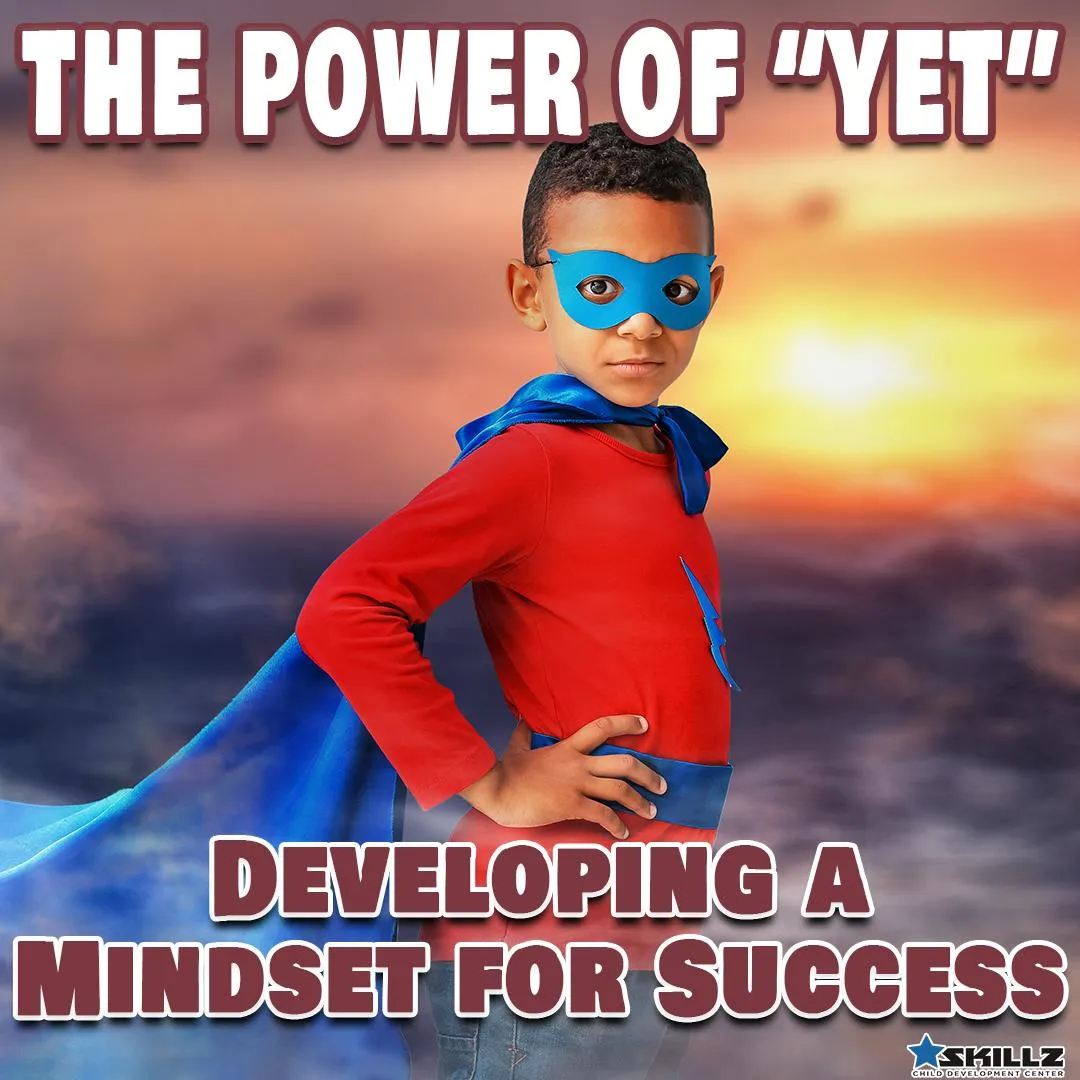
Goal setting is a characteristic that significantly links an individual to their future success. Having the right mindset is crucial and encourages our behaviors as we encounter different challenges. Since our mindset incorporates our own beliefs about skills and abilities that we possess, we must have a growth mindset and teach children the power of this as well. Simple yet effective tactics can be implemented to help children become more confident, resilient, and persistent in their drive to reach goals.
Carol Dweck, a psychologist, developed the theory of the fixed and growth mindsets in her book “Mindset: The New Psychology of Success.” She explains a fixed mindset is one where students believe their basic abilities, talents, and intelligence cannot be improved upon. These students find it hard to cope with failure and don’t take as many risks. She describes a growth mindset in which students know that their abilities, talents, and intelligence can be improved through effort, persistence, and good teaching. These students continue to work hard in the face of challenges and setbacks.
Within the growth mindset approach, Dr. Dweck coined the phrase “the power of yet.” The notion that adding the word “yet” to the end of a sentence that contains words such as “can’t,” “don’t,” and “doesn’t” can drastically improve the realization that skills can take time to achieve but that it is possible. A statement such as “I don’t understand this” changes a fixed mindset statement to a growth mindset statement by merely adding “yet” to the end of it. The understanding that a person’s effort and passion for a goal is as important as attaining this goal is the key. Just as we aren’t born knowing how to play the violin, a “can do” attitude and grit are an excellent combination for success towards any goal that we choose.
To teach children the value of persistence and perseverance, we must praise their efforts and “stick-to-it-ness.” Teaching them to appreciate challenges and accept that mistakes will happen while also encouraging tenacity empowers them to influence the result of the experience. This will build their confidence and give them the courage to try new things. The SKILLZ Child Development Centers offer a supportive environment that applies the growth mindset approach. The Certified Pediatric Ninja Specialists reinforce positive behaviors such as effort and perseverance to build intrinsic motivation. Therefore, students feel confident taking risks and making mistakes because they understand that we learn best when things are challenging.
Forming a growth mindset at an early age is crucial for future success and happiness. By shifting our mindset now, we can role model this for our children by teaching them that things often take time to accomplish but with perseverance, they can achieve their goals. This empowers them so they, therefore, try harder and take more risks in the future. This “power of yet” is an infusion of hope into future generations.
Helping Children Set Age-Appropriate Goals
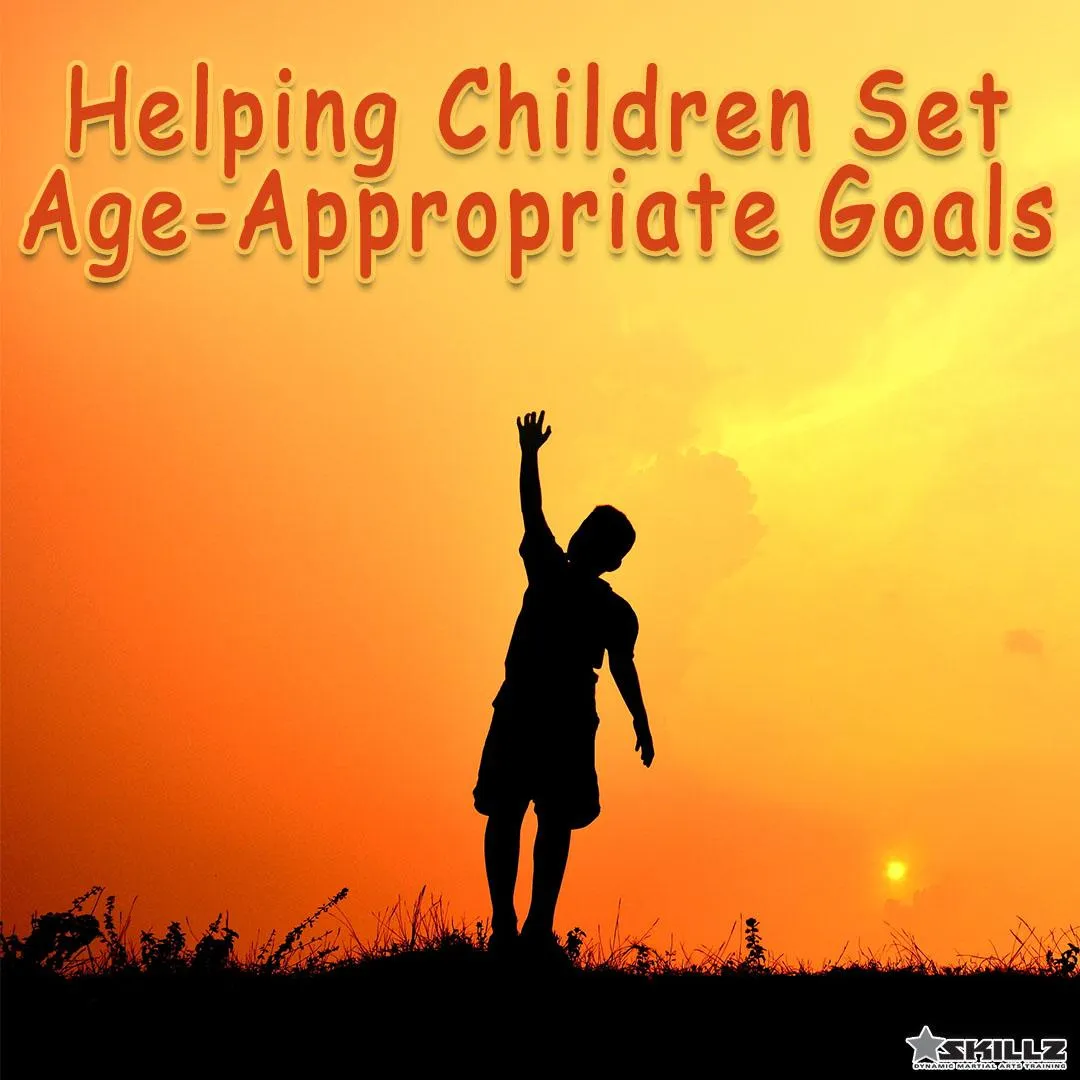
The New Year has arrived, and lofty resolutions have been set. Anything from working out daily to saving money to losing weight, our society knows how to dream big! However, when big dreams aren’t broken down into smaller, achievable goals, failure often ensues. And to make matters worse, our children watch us throughout this short-lived journey. So how can we teach our children to be excited about making personal changes while ensuring the goals are age-appropriate and attainable?
It all starts with a desire to accomplish something new or change something you currently do. When we help children with this process, it is important to find out what they wish to achieve... not what we want for them. The goal then needs to be written down and broken up into smaller, short term goals that are set in a certain frame of time. This will keep the momentum going as they begin achieving these quicker objectives and tracking their progress will help them see how much they have improved. Checking in and reevaluating goals throughout the course of it will also help ensure personal success.
When we help children set goals and apply active learning in the process, it helps them learn responsibility and focus as well as time management skills. For younger children, it is a way to set expectations that they can learn. For older children, it is a way to prompt a more mature understanding of goal setting and they can set longer term goals as well. For any age, however, when goals are accomplished, children’s self-esteem and self-awareness are increased.
But keep in mind, throughout this process there will be ups and downs. When things don’t go as planned, children may feel frustrated. It is vital that all achievements be celebrated, no matter how small. Remind them that improvements have been made no matter what the outcome is. Make sure that you help your child document all of these small wins by using posters or goal ladders. Whether or not the goal is met in the timeframe originally set, make sure to applaud all effort that your child has shown.
Goal setting can be an exciting thing but can also be overwhelming especially for children. When we help them write their goals down and make them into easily attainable small goals, we help them build their confidence. Celebrating their effort and perseverance throughout the process will help them continue to feel motivated. The result will be a life skill that will help them become successful adults.
Reinforcement vs. Punishment
Understanding Behavior Modification
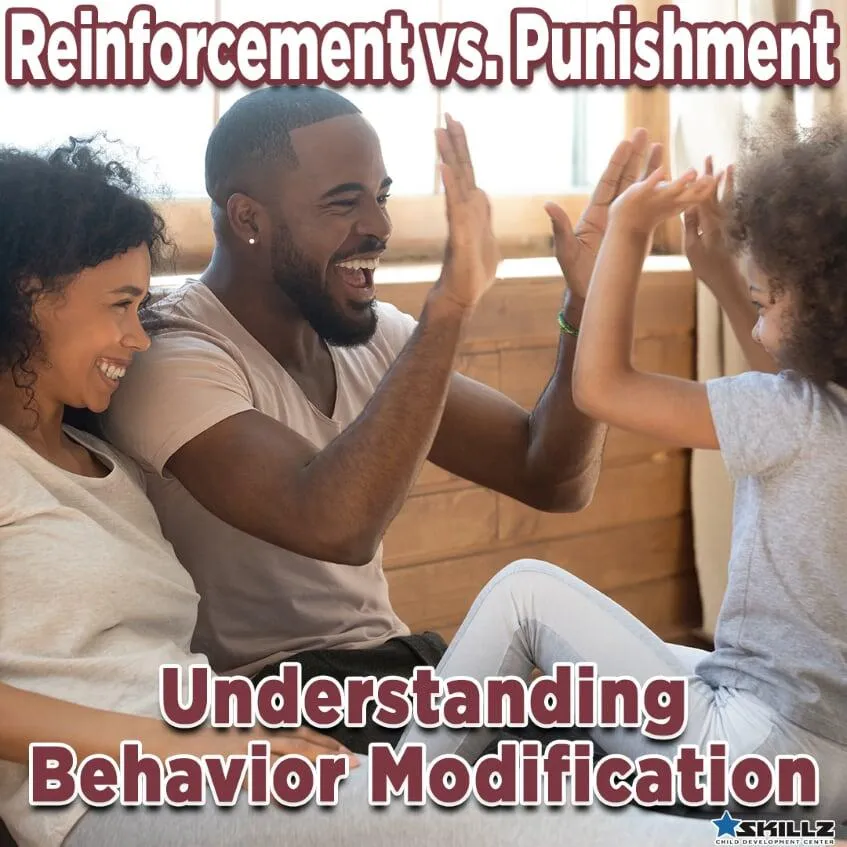
All parents want their children to exhibit positive behaviors that will help them transition smoothly through the different stages of their development. And while parents have the best intentions, they often don’t use the most effective discipline strategies to achieve that goal. And granted, parents do their best to implement the knowledge and experiences that they have in their parenting. However, becoming more familiar with operant conditioning concerning behavior modification strategies such as positive reinforcement can take their parenting to a new level.
Operant conditioning was founded by B.F. Skinner, who believed that the most effective method for understanding behavior, looked at the causes of an action and its outcomes. His findings spawned from Edward Thorndike’s work on the “Law of Effect.” Through this “method of learning,” relationships are made between behaviors and consequences, which can be positive or negative. As Skinner performed his studies, he found that reinforced or rewarded actions are more likely to be repeated.
In operant conditioning, there are key terms used to describe the types of responses, which are often confused. Positive means adding something, negative means taking something away, reinforcement means increasing a behavior, and punishment means decreasing a behavior.
1) Positive Reinforcement: A behavior is strengthened by the addition of a desirable stimulus. Ex. A parent gives a child more time to play video games if he cleans his room.
2) Negative Reinforcement: A behavior is strengthened by the removal of an undesirable stimulus. Ex. A parent makes a child pay $5 every time her room is not clean.
3) Positive Punishment: A behavior is weakened by the addition of an undesirable stimulus. Ex. A parents scolds a child when they misbehave.
4) Negative Punishment: A behavior is weakened by removing a desirable stimulus. Ex. A parent takes away a child’s favorite toy when they misbehave.
Holiday Parenting
Restoring the True Spirit of the Season
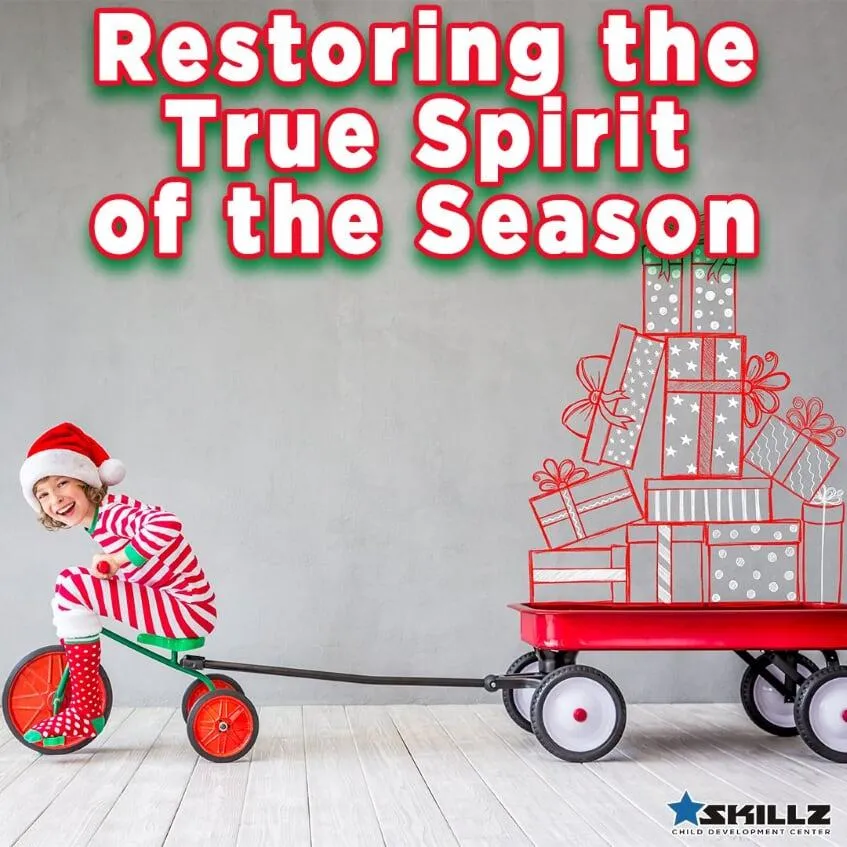
With the holiday season in full swing, families everywhere are struggling to make suitable plans for the pandemic. While our typical holidays are full of family gatherings, parties, and many other busy events this year, the pandemic has put a damper on our holiday traditions and, instead, increased our stress. And although our regular events are halted due to safety concerns, we must find ways to make the best of the situation. Using these uncommon times to foster empathy in children and get back to the true meaning of the season will help make the holidays special.
All humans are born with the capacity to be empathetic. However, we are not instinctively considerate of others, but empathy is, instead, developed through secure attachment relationships and experiences. Early signs of empathy begin just a few days after birth and are usually observed as a baby crying when it hears another crying. This emotional response is due to the firing of mirror neurons. As children get older, they begin tapping into the cognitive side of empathy. This is because their executive functioning skills are more developed, so they can better understand others’ points of view and better regulate their own emotions.
To nurture the empathetic muscle, we must help children exercise it. Since we are presented with an atypical holiday season combined with divisions in communities, now, more than ever, we should work with children to strengthen their empathetic responses. This begins with parents modeling empathy to others, including their children. Exhibiting patience and giving grace to others during these difficult times alleviates stress and makes everyone feel more understood. Utilizing current situations as learning tools for developing empathy will start the process. Teaching children what selfless giving is, is a great start. Helping them understand that not everyone has the same things can start the conversation. You can then encourage them to make decisions on how they can help others less fortunate.
In the SKILLZ Child Development program, life lessons such as patience, kindness, and sharing help children become more empathetic. The Certified Pediatric Ninja Specialists that run the classes are knowledgeable about development at each age level and can, therefore, implement and use opportunities to foster empathy that is age-appropriate. The supportive environment also helps students connect, and the brain-based focus supports the development of executive functioning, which fuels their ability to be more empathetic. Also, the Parent SKILLZ tips provide easy to implement methods that help parents connect better to their children and ultimately create secure attachments and model empathetic responses to others.
Now, more than ever, our world needs empathy. As the spirit of the season surrounds us, patience, and compassion for each other should be at the forefront of our relationships and interactions. Using these uncommon times to strengthen our empathetic muscles can create more compassionate, generous, and thankful community members. We can then attain joy and hope that the season should bring and use this unusual holiday season as a path for making more meaningful traditions for future generations.
Parenting Styles
Implementing the Most Effective Methods
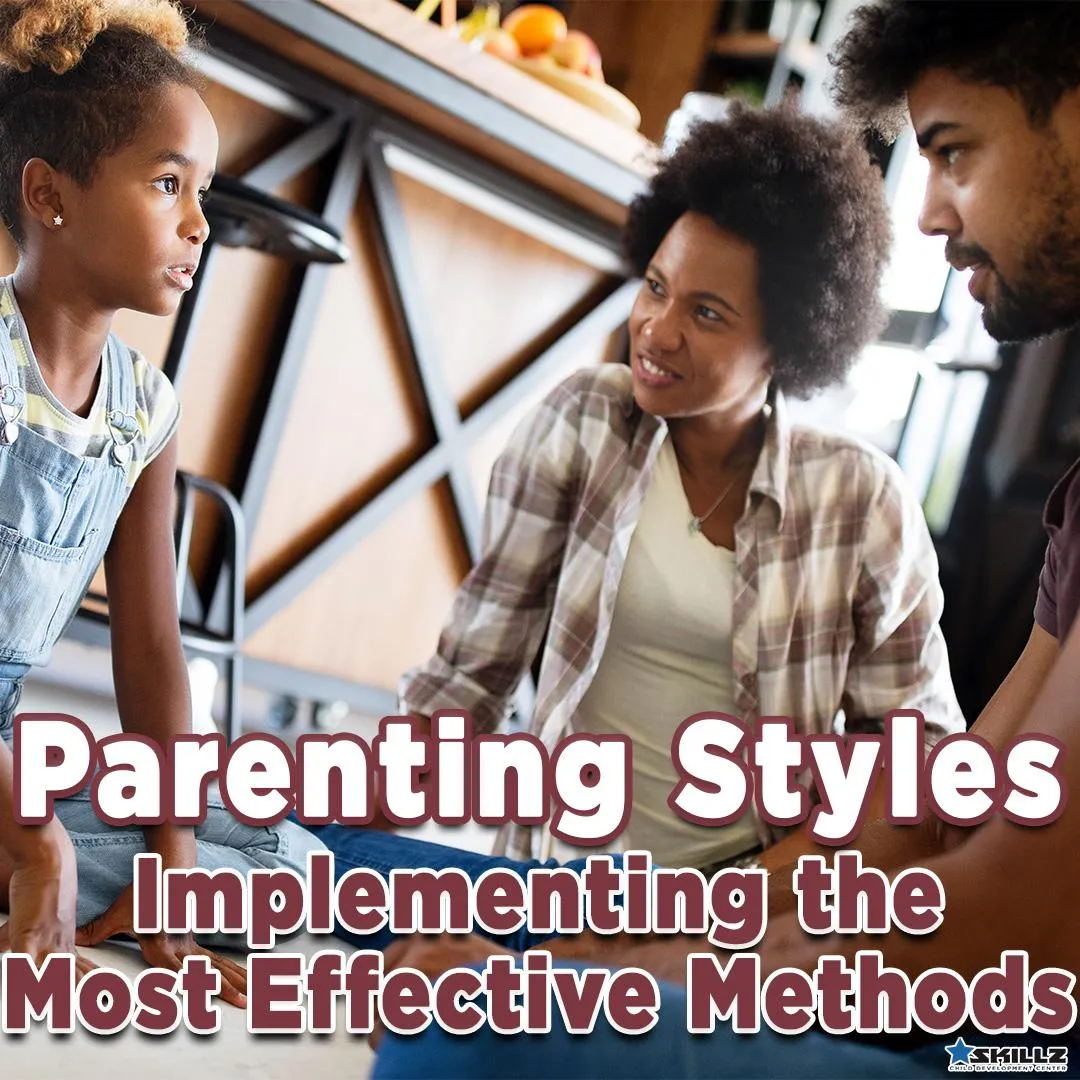
Becoming a parent is, for the most part, an exciting adventure to undertake. Along with this, however, comes an enormous amount of responsibility. And while most feel prepared, others may experience anxiety and uncertainty about how to begin this journey. But no matter what, parents ultimately want to raise their children to the best of their ability with the information they possess. Knowledge of our parenting style can help us adjust, as needed, and apply the best approach for our children's healthy development.
Four distinct parenting styles were originated by Dr. Diana Baumrind, each of which has specific characteristics presented by the parent and outcomes, therefore, expressed by their child. Parents often settle into one of these four styles depending on how they were raised, their belief systems, and their child development knowledge. However, many will exhibit overlapping qualities from the four styles. Understanding this, we can view parenting styles as a spectrum in which parents may apply different styles depending on a child's temperament and unique situations.
1) Authoritarian: These parents often feel that children should be "seen and not heard," and rules are rigid and be followed without question. Communication is one way, and the child's attempts to question or negotiate are seen as "back talk." These parents are often less nurturing and feel that life lessons are best learned through a "tough love" approach. Punishment for poor decisions is harsh, and guidance for better decision making is lacking. Because of these things, children are often unhappy and less independent and have low self-esteem, poor coping skills, and behavior problems.
2) Authoritative: These parents spend time implementing strategies to prevent problems by creating rules and utilizing positive discipline approaches. Although they set high expectations, they allow input from their children and guide them in problem-solving difficult situations while also applying praise and reward systems to reinforce good behavior. These parents explain things to the level of their child's understanding and help them develop a sense of awareness regarding values and morals. Therefore, this style creates more independent and self-disciplined children who are happy and have lower levels of mental illness and delinquency.
3) Permissive: These parents have the "kids will be kids" approach and are more of a friend to their child than a parent. They are nurturing and have incredibly open communication. However, they have minimal expectations and have limited or no rules in place. And while they sometimes use consequences, they often don't enforce them. This approach gives the child the ability to make their own choices, good or bad. Because of this, these children often don't respect rules or authority figures, struggle to reach goals, are egocentric, and have poor impulse control.
4) Uninvolved: These parents have little knowledge about what their children are doing and appear indifferent. They may seem to neglect their children, although this is not always deliberate and may, instead, be due to a lack of parenting knowledge or because they feel overwhelmed. These parents usually have few expectations or rules, if any, and leave children to raise themselves. Due to the lack of communication and nurturing, children often have behavior problems, don't do well in school, and have difficulty controlling themselves and their emotions, often leading to delinquency.
As a progressive program, SKILLZ Child Development Centers and the Certified Pediatric Ninja Specialists who run them are armed with the latest knowledge in science and psychology, which lays the system's foundation. Coupled with the methods applied in each class by instructors, parents receive support through seminars on parenting techniques and supplemental curriculum that give them knowledge on the most effective approaches. The information and skills are quick and easy to implement but have enormous benefits.
Parenting can be rewarding and challenging at the same time. As they say, "it takes a village." When we understand the different parenting styles and how they affect children long term, we can move along the parenting spectrum to achieve the best results for each child.
Holiday Parenting
Keeping the Joy Alive

The hustle and bustle of the holiday season, this year, maybe a little less intense but, no doubt, still exciting. While holiday parties may be missing from our typical December schedules, the pandemic can't stop the spirit of the season! Decorating the house, wrapping gifts, and baking goodies will keep the joy alive. Ultimately, just as in any other year, however, the excitement can become overwhelming and put children into full sensory overload. This, coupled with the world's unsettledness, can increase cortisol, causing more stress than joy. Implementing positive strategies into our routines can help counteract these tensions and reconnect us to the season's true meaning.
During the holidays, children's emotions are at the forefront, and a season of excitement, happiness, and hope quickly turns into apprehension, stress, and irritability. The constant stimuli and lack of downtime lead the way to exhaustion and crankiness, and, therefore, children become more reactive, and behavior issues result. Even the most laid-back of children have difficulty managing their emotions. The ups and downs of the emotional roller coaster, along with the craziness, make it challenging for parents to keep themselves calm, let alone their children too. What should be a time of love and peace quickly turns into frustration and arguments.
Much of the season's adverse effects come from upended schedules, late nights, and unhealthy habits. And because the season is "magical," parents often assume their children will automatically be on their best behavior. Sadly, this is not the case, so parents often resort to shouting, threatening to call Santa, or taking presents away. And yes, parents may win the fight, but it ultimately results in everyone feeling horrible. To help prevent these things from happening, it's essential to keep some routines in place, such as snack and bedtimes, and allow children some downtime each day. It's also crucial for parents to give their children meaningful attention and have positive strategies in place to reinforce good behavior.
As a leader in child development, the SKILLZ Program offers parents a supplemental curriculum that provides a positive approach to parenting. The eight quick and easy Parent SKILLZ helps parents be attuned and patient with their child's ever-changing holiday emotions, recognize the importance of adaptability to the season, and nurture them when overwhelmed with stimuli.
The holidays should be a joyful time of year. To keep things magical, it is necessary to maintain some normalcy amid the chaos while also creating opportunities for children to do their best. Having positive reinforcement strategies in place can help alleviate undesirable behaviors. Giving grace to children when they feel overwhelmed will also provide more peace and connection throughout the holiday season.
Attachment Awareness
How Attachment Styles Affect Classroom Behavior

All children have their own unique way of interacting with the world around them. And while much of this is contributed by their temperaments, the degree of emotional nurturing plays a significant role. This essential piece is how attachment is formed. The emotional bond between a child and their parent lays the foundation for how the child will relate to other people and environments they encounter throughout their lives. When we know how the type of attachment contributes to behaviors observed, we can then serve children in the classroom in a more effective way.
Dr. John Bowlby, along with Dr. Mary Ainsworth, developed the Attachment Theory. They created the "attachment behavior system," which is the guiding system for our patterns of developing relationships. The level of love and security felt by a child is the basis for how each of the four types of attachment is formed.
1) Secure Attachment: These children see their parents as a firm base of support in times of need or difficulty. In new situations, they may show some distress when separated from their parent but are better once the parent returns. Because they have developed trust that their parents always meet their needs, they trust others more and are confident to explore things around them. These positive feelings lead to more success in the classroom.
2) Anxious-Resistant Attachment: These children have tremendous amounts of separation anxiety and display strong emotional reactions to this. In new situations, they lack the confidence to explore new things, even when the parent is present or has returned. These behaviors are generally developed from an unpredictable parenting style, where the parent alternates between caring, angry, and even insensitive approaches. These children may have more difficulty in the classroom with relationship development and may isolate themselves.
3) Anxious-Avoidant Attachment: These children are very independent of their parents and have minimal stress when separated. Even after the parent returns, these children often don't acknowledge them and prefer emotional distance from others. Typically, their parents have cared for the child's physical needs but have been emotionally unresponsive. In the classroom, these children are likely to resist help and show more aggression or other behaviors such as lying and bullying.
4) Disorganized-Disoriented Attachment: These children are typically the victims of abuse or neglect by their parents, and there is no specific pattern of behavior. They look to their parent for basic needs to be met but with fear that they may be hurt. They often avoid their parent and fear others as well. Because they struggle with developing relationships, they may switch between being withdrawn to being disruptive and aggressive.
Awareness of these types of attachment can assist teachers, counselors, coaches, and other adults who work with children in recognizing individual needs to help fill the gaps. The SKILLZ Child Development Program we use at AB Karate utilizes this knowledge to strengthen each child's individualized approach and needs. This method encourages an appreciation for a child's emotional deficiencies, so the Certified Pediatric Ninjas Specialists in the class can address these things with a supportive social environment and classroom management. Also, the program offers parents ways to improve connection leading to a more secure attachment.
As a child grows, they develop attachments to others that they interact with frequently. Using an approach that incorporates attachment awareness when working with children, adults can create an environment that is a secure base for them. This insight provides valuable information into each child's world to influence their relationships positively, which will lead to improved learning.
The Sweet Spot of Learning
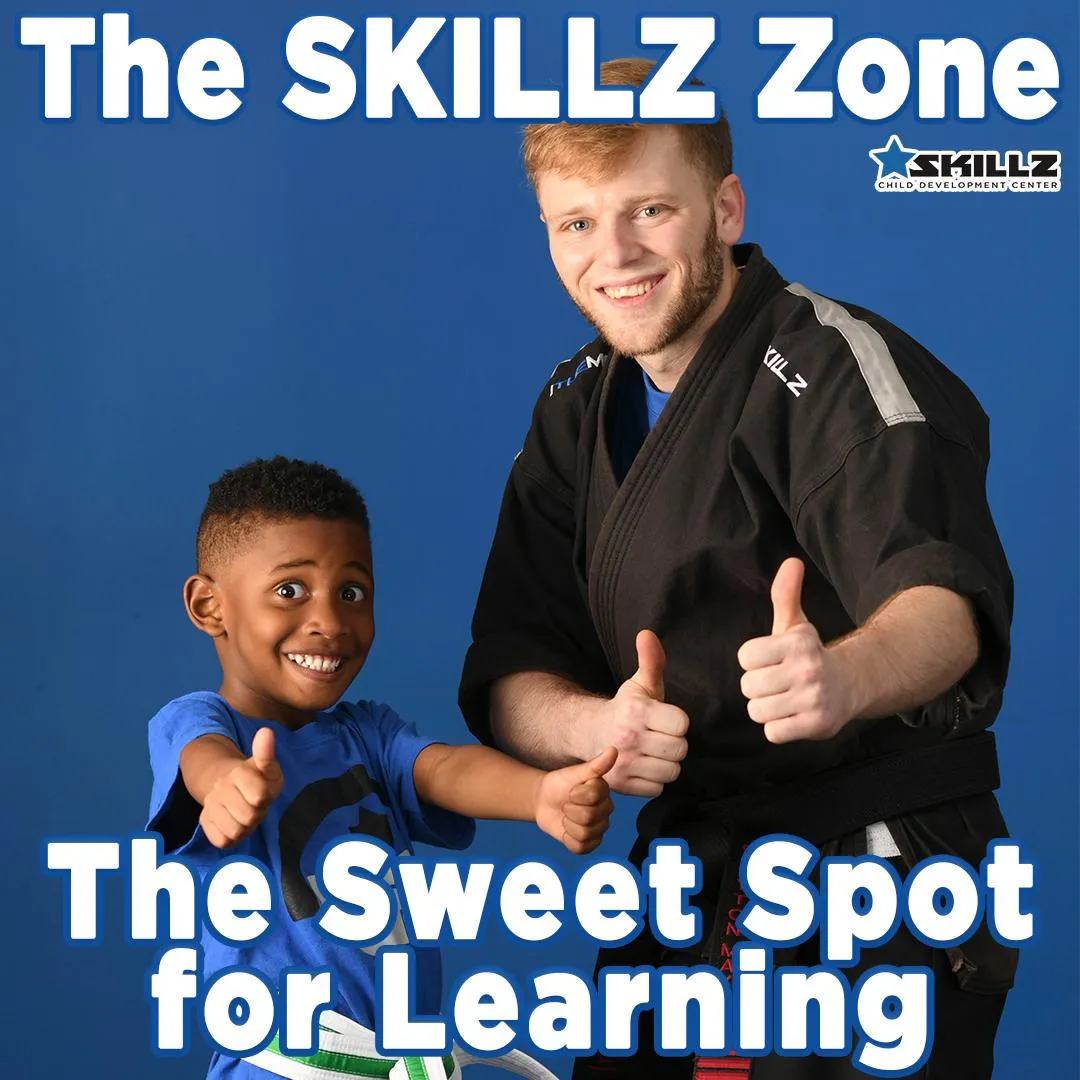
We’ve all set goals, to some degree, throughout our lives. Some were easily achieved while others we just gave up on completing. This is because most plans are either set in the comfort zone or the danger zone. And while our initial motivation generally puts on a path to setting lofty goals, it can lead us to failure. Finding a balance between these two zones is critical in increasing productivity and avoiding stagnation. The “SKILLZ zone” is the optimal place to do this. By teaching children this early on, we can ensure that they have the necessary tools for consistent future successes.
We are all very familiar with the comfort zone. This is where we feel secure and have skills in place to help us maintain the status quo. Many people spend a lot of time in this zone because it doesn’t require much change. This is also the place that we withdraw to when we feel panicked or overwhelmed. And although feeling safe is essential, the comfort zone doesn’t allow us space to grow, so we become indifferent to expanding ourselves. This essentially blocks us from learning any new skills that are beneficial to our growth.
On the opposite side of the comfort zone is the danger zone. This zone is where we feel completely overwhelmed and out of control, so only surviving takes all our attention and effort. This often happens to those who set goals so far from their current abilities that they become overwhelmed and panicked. Because we are “wired to survive,” these uncomfortable feelings cause us to retreat to our comfort zone, and any possibility for new skill achievement comes to an abrupt standstill. We are then, once more, faced with apathy for anything challenging.
The key to breaking free from this cycle and beginning to set goals that are challenging, yet attainable is to form ones in the “SKILLZ zone.” This is the zone where dreams are not so far off that we are too scared to try but are also not close enough to be too easily achievable. Therefore, new skills are just out of our reach, making it the sweet spot for learning. For children to settle into the “SKILLZ zone,” they must feel the environment is safe and supportive.
In the SKILLZ Child Development program at ABK, this zone is the foundation of the program’s design. Since each class is age-specific, the starting point and goals are based on appropriate expectations in physical, intellectual, emotional, and social development for that age group. This, coupled with the game-based approach to learning, creates an environment that is fun yet challenging. Also, the instructors that run each class utilize their knowledge of science and psychology as well as Teaching SKILLZ to establish an environment that makes each student feel safe. All this combined makes the achievement system of earning stripes and belts an enjoyable process and gives each student more confidence to set the next goal.
Learning new skills and abilities should be enjoyable, and getting there should come from engaging in activities where we feel safe enough to try something beyond our current limitations while also not going overboard. Consistent progress towards these things opens up a child’s curiosity as to what else they can achieve. By doing this, we are helping them always challenge themselves, which will give them the power to achieve anything they want in life.
Whole-Brain Parenting
Engaging the Brain for Optimal Development

On any given day, we may experience moments of high emotion in reaction to an event, or we find ourselves trying to control everyone and everything around us. Either way, our mental well-being is in danger, especially if we find ourselves stuck in either scenario for long. It can be difficult for children to get unstuck without some help from a parent or other adult. To give children the support they need when faced with this, parents must have a basic understanding of their child’s brain development. By incorporating this knowledge into interactions, parents can support children in learning and growing through a whole-brain approach.
To help us get a clear understanding of how these two extreme reactions can present in children,” Dr. Daniel Siegel and Dr. Tina Payne Bryson created the concept of the “river of well-being” in the book “The Whole-Brain Child.” Along the river of well-being, there are two banks: the “bank of chaos” located in the right brain, and “the bank of rigidity” located in the left brain.
The bank of chaos focuses on emotions rather than the content of an event. This side also receives input from the primitive “downstairs brain,” which, combined, creates strong feelings related to experiences and relationships. The waves of these intense emotions can lead to feeling overwhelmed or out of control. Up to about the age of 3 years old, children are primarily functioning from the right side of their brain. Due to their lack of language development, getting stuck on the “bank of chaos” can often happen. As children get older, they can better express themselves; however, the underdevelopment of the logical, “upstairs brain” still makes it difficult for them to avoid getting stuck on the right side.
On the left side of the “river of well-being” is the “bank of rigidity.” This side is very literal and creates structure in our minds. When children start asking “why,” parents will know the “left brain” has begun to respond. And while this integration is good, children that become emotionally overwhelmed can find themselves stuck on this bank where they become too literal and lose view of the whole picture. They will then avoid the strong feelings and end up in an “emotional desert.” When this happens, children will appear distant and say things such as “I don’t care” because they only hear the words and ignore non-verbal cues. This response makes them less willing to cooperate.
When children get stuck on either side of the river of well-being, parents must be attuned and respond accordingly. The SKILLZ Child Development approach at ABK helps parents implement the best tactic when faced with this. By applying the Parent SKILLZ techniques, parents connect with their children, are patient in responding, and nurture appropriate responses. Since during an emotional flood is not the time to insert logic, parents should “connect to the right” by validating their child’s emotions and helping them calm down. Once the child is more relaxed, then parents can “redirect to the left” and help the child brainstorm more logical reactions.
By promoting horizontal integration between the right and left sides of the brain, parents can create a more harmonious arrangement from which children can learn and grow. Understanding that the brain is influenced by the way we parent can help create opportunities for more vital brain coordination. This leads to healthier brain development and fosters a strong parent-child bond and leads to happier children.
The Developing Mind:
Understanding Your Child’s Behavior
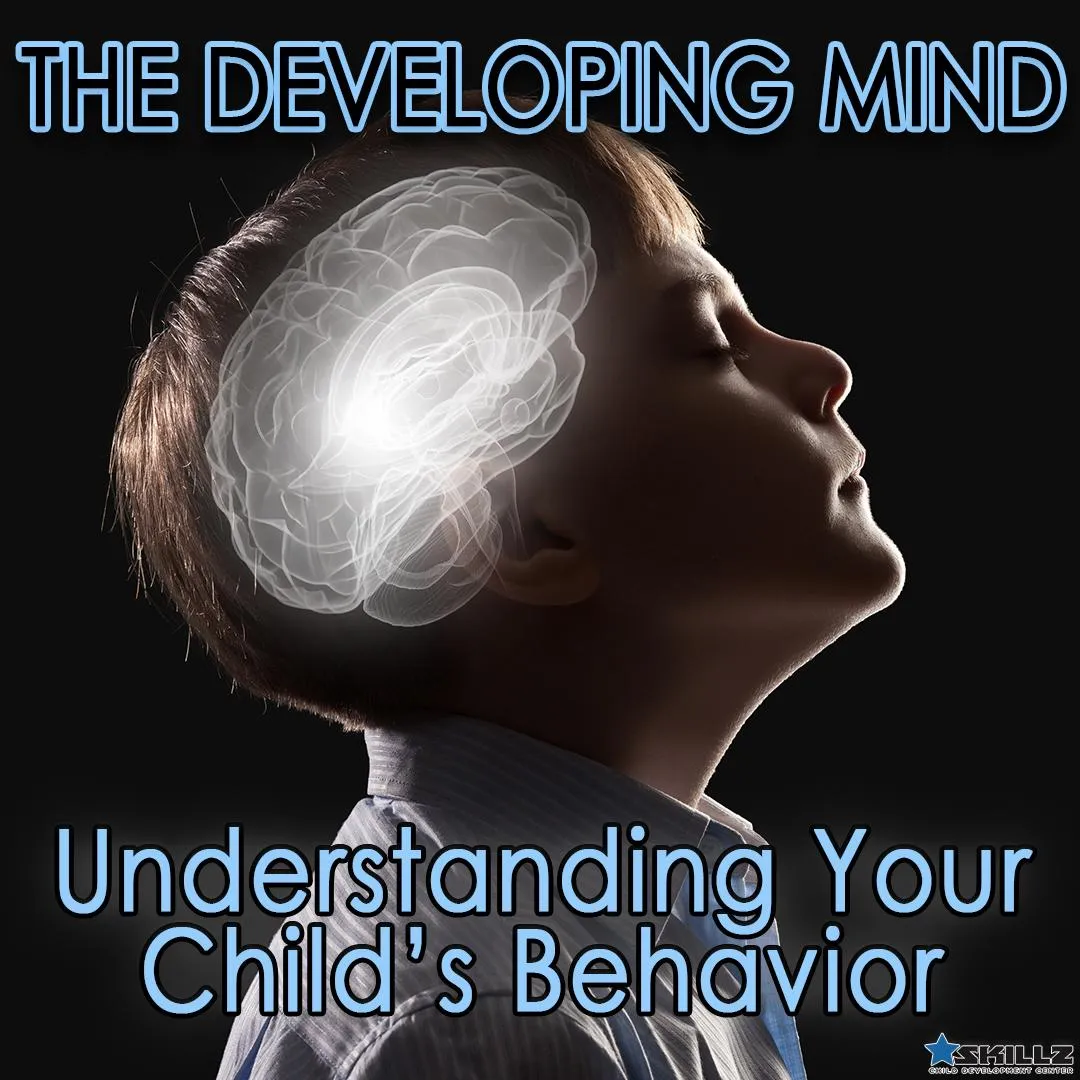
One of the biggest struggles in parenting is understanding why perfectly sweet and smart children can, in an instant, turn into the most difficult beings ever faced. It’s often as if a switch was flipped and chaos has ensued. This typically results in parents becoming frustrated at their child and disciplining them in the heat of the moment. And while this may seem like the best option, it can be counterproductive in many ways. When parents become knowledgeable about the basics of brain development and how this affects behavior, they can help integrate all areas of the brain and have better parenting success.
The key to whole-brain integration is having a basic understanding of children’s brains. To simplify this, Dr. Daniel Siegel and Dr. Tina Payne Bryson, created the concept of the “upstairs brain” and the “downstairs brain” in the book “The Whole-Brain Child.” When children are born, their primitive, “downstairs brain” is well developed. This part is responsible for the basic functioning of the body such as breathing and the heart beating but also incorporates innate responses related to strong emotions such as fear and anger. The amygdala, a tiny, almond-shaped mass, is the supervisor of the downstairs brain and stays alert for anything threatening. When there is perceived danger, our basic survival instincts kick in and we act before we think. For children, this often presents as a tantrum because they are flooded with stress hormones and strong emotions.
Above this is the sophisticated, “upstairs brain.” The pre-frontal cortex, specifically, is where higher thinking, decision making, and problem-solving take place. This part of the brain shows us the bigger picture and helps regulate our emotions. During “downstairs tantrums,” this is the part of the brain that needs to jump in and help. The problem is the upstairs brain doesn’t reach full development until our mid twenty’s. Since it is not fully functional until then, children are not able to access this part of the brain all the time to make better decisions during an emotional flood.
Armed with this knowledge, adults can help reinforce the metaphorical “staircase” from the downstairs to the upstairs brain. This is where vertical integration takes place. If downstairs tantrums are handled with discipline, it can, instead, force children even further down into emotional turmoil. Instead, this is best handled with attunement and connection. As a tactic of the SKILLZ Child Development approach, these two concepts create a more constructive way of dealing with an emotional flood and strengthens the child’s ability to tap into the power of the upstairs brain on their own. This approach allows emotions to be resolved, instead of ignored, while also engaging decision-making skills. As a result, children can self-regulate and return to a place where they can learn and retain things better.
Since adults aren’t typically knowledgeable about how the brain develops and functions and what this has to do with children’s behaviors, they must become informed. By becoming familiar with the development of the brain, adults can be more understanding and patient with children during upstairs tantrums. Knowing that these types of tantrums are due to a lack of skills in the upstairs brain, not a lack of motivation to be good, we can take a more productive approach to parenting.
The Mood Booster
Increasing Endorphins to Improve Learning
Children today are presented with varying types of stressors in almost every aspect of their lives. The infamous “bar” has been set so high that in order to achieve it, children are asked to forgo “fun” and work towards superiority in everything they do. And while goal setting is an essential skill for future success, unrealistic expectations have led to increased rates of anxiety and depression in children and teens. This, unfortunately, is counter-effective to confidence-boosting and productive learning. Therefore, children and teens must be given opportunities to feel boosts of endorphins, which leads to improved mood and learning.
Endorphins are produced by the central nervous system and the pituitary gland. Their main function is to alleviate pain and boost pleasure. They are most often associated with exercise since the release of these “feel-good” chemicals trigger a state of exhilaration which is usually referred to as a “runner’s high.” In recent years, studies related to endorphins have begun to focus on how this chemical promotes learning. They have a positive effect on an area of the brain that regulates memory and learning called the hippocampus. The meditative effect that endorphins also have help children be more present and in the moment by shifting their focus away from day-to-day challenges.
Since physical activity is essential to brain development, neuroscientists have been urging parents and teachers to work on stimulating these good-feeling brain chemicals. By boosting these positive neurotransmitters, cortisol will be reduced leaving children with happier feelings, which develops clearer thinking and enhances attention skills. This makes learning easier, so knowledge is better attained ultimately leading to more confidence. Therefore, it is vital that children have physical education and recess time in school, have outlets for physical activities throughout each week, and playtime outside. Establishing times that children can play and laugh will go a long way in improving mental health and school performance.
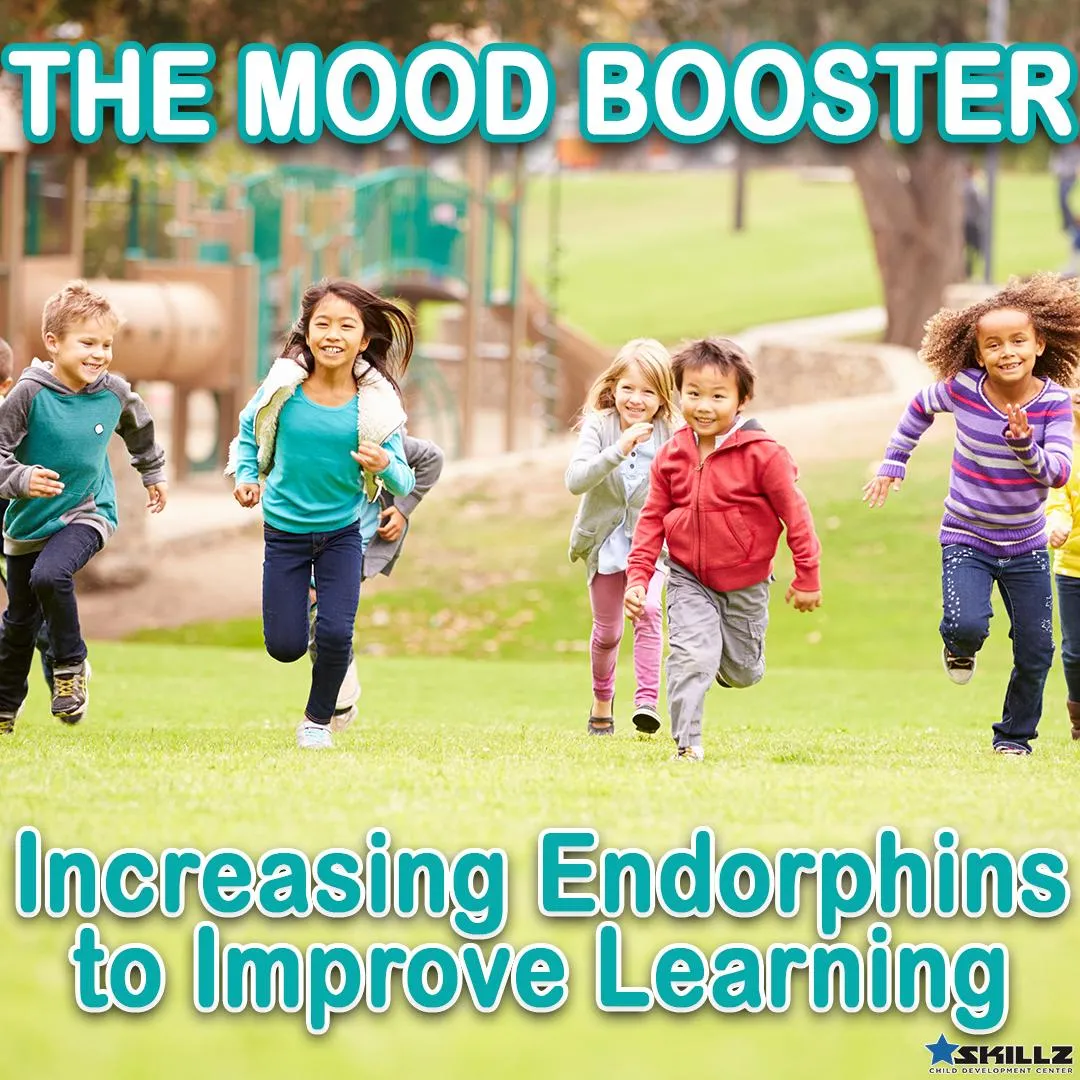
As a child development center, the SKILLZ program has been on the cutting-edge of establishing classes that utilize this knowledge. The innovative methods implemented in each class incorporate the most important aspects of child development and learning. Not only does the martial arts training boost endorphins but combining it with game-based learning creates a fun environment that strengthens learning. This engagement also gives students a sense of belonging and fosters friendships.
By teaching with the brain in mind and utilizing all information in the areas of child development, science, and psychology, we can create opportunities for children to have the best learning experiences. When children are in a good frame of mind, they learn easier so providing time for them to be active is essential to heightened performance in school. This not only improves their learning abilities but also builds confidence by giving students a sense of accomplishment. The mind-body connection is a powerful thing.
Patience
Patience is character trait that is being tried now more than ever. Take a few extra seconds when responding to poor behavior. This demonstrates compassion, empathy, and self-control on your part. Sometimes all you need to do is think about responding in the most patient manner to help re-direct your child. A few seconds can make a big difference.
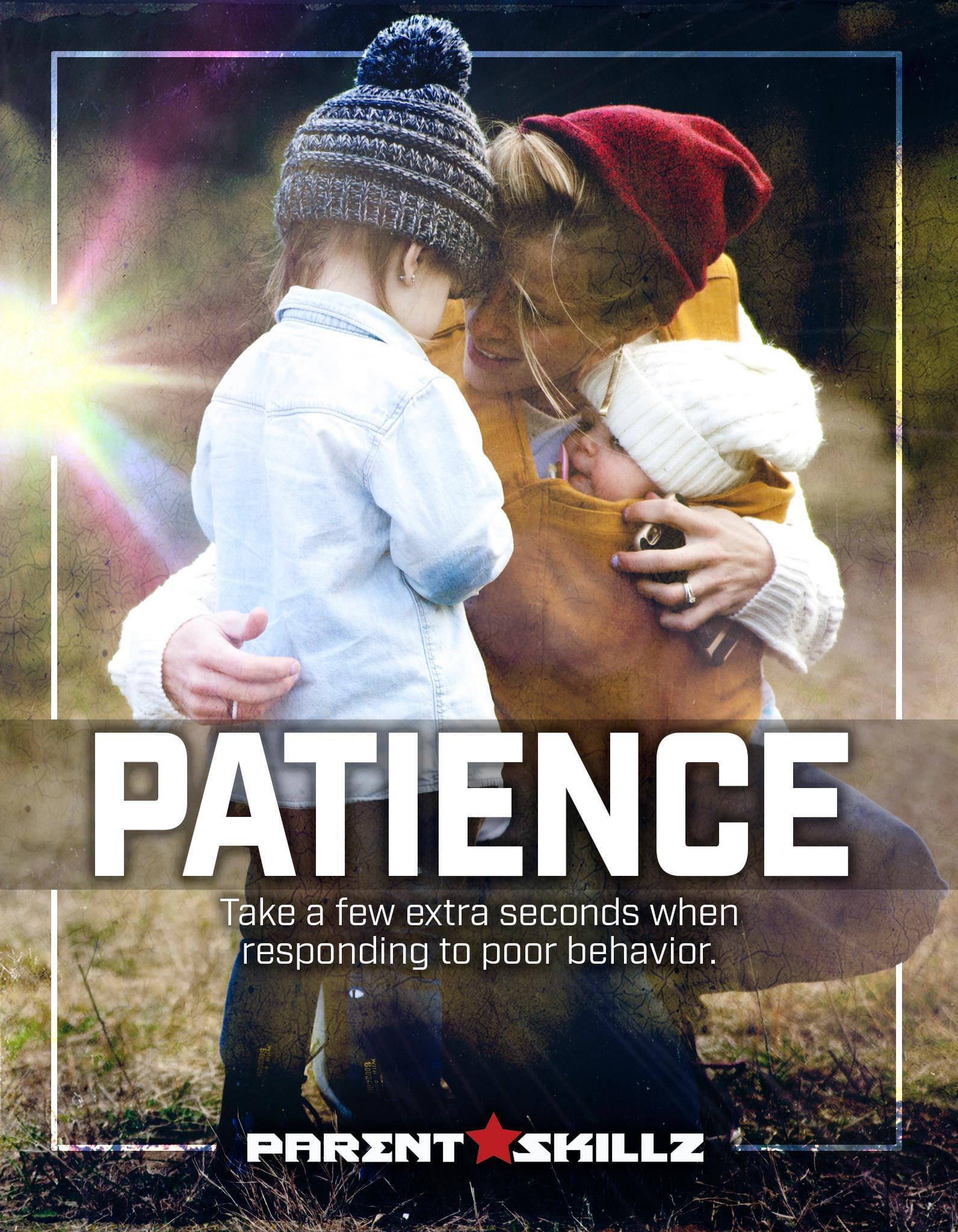
1. Ask, Listen, Explain
Patience helps you to establish better solutions for difficult moments with your child.
If your child has a temper tantrum, for instance, take a few seconds to calm down before reacting. Then, ask questions to help determine what is really driving the behavior. Listen to what they say and then explain what they could have done instead.
Patience can lead to understanding and solutions. Be patient and ask the right questions to get your child back on track.
2. Give a Do-over
A do-over is exactly as it sounds – the chance to do something again. Using patience means giving your child the chance to act in a better way than they did the first time around.
The perfect time to implement a do-over is when your child says something out of anger, such as “You are not my favorite mommy!” A do-over begins by telling your child that this is not the proper way for them to speak to you. You may begin with, “Let’s do this over. What is a nicer way to talk to me when you are upset?” This gives them the chance to explain why they are upset in a different way. It may be as simple as they didn’t want to stop playing to eat dinner. Allow them the chance to re-phrase and then go from there, such as letting them know that they can play more, just after dinner.
When you allow your child a do-over, you use patience with your child and apply patience to the way that you react to their behavior.
3. Provide Teaching Moments
Many people assume that discipline means “to punish,” when it really means, “to teach.”
When your child makes a mistake, you can either punish, or you can discipline through patient teaching moments. In a soccer game, if a player misses the ball, the coach doesn’t yell and get angry with them. Instead, they explain what went wrong and help the player by letting them know how they can improve the next time.
A parental teaching moment is the same. When your child makes a mistake, use patience to explain what they did wrong and provide them information that will help them improve or not make the same mistake again. A teaching moment provides options and solutions, while punishment does not.
The question to ask yourself today is how patient are you with your child. How many times do you give them do-overs? Try to give them as many do-overs as possible so they can learn how to behave and communicate better. In the long run, both of you learn valuable teaching moments through patience.
Keep Cool While Keeping Healthy:
5 Summer Snacks
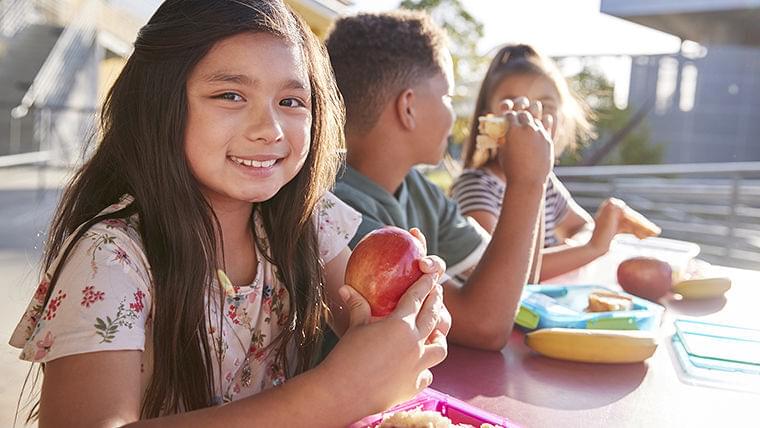
Pico de Gallo – Not many kids jump at the idea of eating vegetables for snack time, but pico de gallo turns healthy veggies into fun. It’s so easy to make – just dice tomatoes and onion, then sprinkle with a touch of salt, fresh lime juice to taste, and cilantro. Serve it up chilled with cucumber slices or black bean chips for a healthy twist from the standard tortilla chips.
Rainbow Fruit – It’s hard to beat out fruit as a snack – it’s healthy, hydrating, and quick to prepare. Make use of those kebob skewers and seasonal produce for a healthy and fun snack sure to delight. Raspberries, strawberries, and watermelon all make easy in-season picks for red. Consider cantaloupe or orange slices for orange, bananas or pineapple for yellow, green grapes or honeydew for green, blueberries for blue, and purple grapes or blackberries for purple. Stack one of each colored fruit in rainbow order on the kebob and serve cold – it’s just that easy.
Froyo Pops – This one takes some ahead planning, but once done, you have snacks for the whole week! Using a popsicle mold (or if you don’t have one, a simple ice cube tray or small Tupperware container), add your choice of fruit – fresh or frozen – to the bottom of the mold. Top it with low-sugar yogurt, then add some more berries. Top it off with one last layer of yogurt, then add your popsicle sticks and pop in the freezer. They’re easy, healthy, and filling – and a perfect way to stay cool on even the hottest of days.
Frozen Grapes – If this one isn’t yet a staple in your summertime freezer, it should be! Thoroughly clean fresh green grapes, pat them dry, then pop them in the freezer in your choice of storage container. Dole them out as needed. They’re healthy, fun, and refreshing – bet you can’t stop after just one.
Fruit and PB Dip – Natural peanut butter is a great way to introduce protein and healthy fats into your diet, and this peanut butter fruit dip is the perfect way to enjoy it. In a small bowl, combine 8 oz of low-fat sour cream or Greek yogurt with ½ c natural style peanut butter, ¼ c. low-fat milk, 2 Tbsp honey, and 1 tsp. cinnamon. Serve it up with bananas or apple slices.
at Bay This Summer!
Today I wanted to offer a few tips on how to keep boredom at bay this summer! These are simple tips that you can implement NOW, and will help set your ninja up for success.

Communicate the plan
Every evening, take a few spare minutes and review the “plan” for the next day. A little bit of structure will go a long way and will also help everything go smoothly. If possible, try to include 45min-1hr of physical activity doing things such as swimming, biking or practicing your forms!
Work together to develop effective summertime habits
Many parents will set boundaries and limitations for their kids which is great, but if you include your kids in the process they will better understand the “how” and “why”. This will help them better understand why certain things are limited and also help them find ways to keep themselves entertained. Talk with your ninja and determine how much electronics time per day & week are appropriate. Then work together to come up with a list of activities they enjoy!
Be a good role model
Get outdoors and show them how much fun it is to be active! Children will often make better choices when their role models are doing the same, do so and they will be more willing to give it a try! This can be as easy as having them teach you how to play a game! You can even take it to the next level and have them teach you how to do a few kicks or a form!
We hope that this has given you a few ideas to use when tackling summer boredom! If you are out and about or on vacation don’t forget we would love to stay in contact by posting a picture or video on our FaceBook page. We hope you are enjoying your summer and can’t wait to see everyone back on the mat!

PERSISTENCE
Older students: The determination to keep going even when faced with challenges or initial failure.
WEEK 1 Persistence defined: What it means to keep going and what it means to quit.
WEEK 2 What gets in our way? Fears, priorities, poor character & peer pressure
WEEK 3 What keeps us going? Sup-port-Passion-Action-Rea-son-Knowledge (SPARK)
WEEK 4 When we are having trouble persisting: Re-framing, self-talk, confiding & recharging!.
Dear Family,
This month we are going to be discussing the powerful word, persistence.
People who persist make a choice. Instead of giving up when faced with challenges or failure, persistent people try something else. They keep going because something inside them tells them to strive. Their goals are in sight and they know they can achieve them if they stay determined.
People who persist have “grit.” Angela Duckworth, who has made a career focusing on the grit, says that a person’s “grit score” predicts achievement under challenging circumstances. For example; a West Point cadet’s grit score was the best predictor of success while the grittiest contestants of the Scripps Spelling Bee were most likely to advance to the finals.
There are many barriers to success that can derail even the grittiest people. From naysayers to repeated failures, poor self confidence to lack of resources, persistent people must weather the storms. Persistent people aren’t without their frustrations and challenges but they are more likely to keep going as they arise.
Every child must learn new things. According to Brene Brown, when people are learning, they often get into a shame cycle during which every frustrating hurdle or failure is a reason to shower themselves with shame. You might hear phrases like: “How did I not know this? How did I make this mistake? I’m not good enough.” Dr. Dehra Harris, who works with elite performers, found that instead of getting caught in shame cycles, elite performers remain in a constant learning phase. They see each action to gain expertise/mastery as a “singular attempt to attain a learning outcome.” They persist.
There are many ways to help persistent people stay the course. Providing Support, igniting their Passion, encouraging them to take Action, reminding them of the Reason they want to see the goal to fruition and providing them with the Knowledge they need to move forward are vital. By lighting a person’s “S.P.A.R.K.,” the gritty person can persist.
That means that we need to stress effort and grit over intelligence and talent. Research tells us that those parents who stress effort over innate gifts, tend to rear children who try harder and work longer on achieving their goals than others.
We thank you for your support. You are pivotal in helping to make our school one of the best personal development centers in the world.
Best Regards,
Your Motivated and Dedicated Instructors
We all know a person in our lives that cannot stop talking about their problems, challenges, injuries, health concerns, relationship troubles, and much more. They come in and immediately put the focus on them and their tale of woe.
Be honest…do you like being around these people? I’m sure some of them are good friends and you want to help them out. You want to be a good person and listen to them, be a shoulder to cry on, and possibly even offer suggestions.
Does that ever help? More than likely, the answer is no! In my experience, this gives them the green light to complain more, sulk more, and put all their troubles on your lap.
The reality is complaining is a way of getting attention. They have something to say and they want you to agree that they have it so much rougher than the rest of the world.
What if that person accepted 100% responsibility for the position they are in. What if they accepted they are in a tough spot, whether it was their fault or not, and decided they are going to make the best of it with a great attitude.
Mike Smith was the head coach of the Atlanta Falcons from 2008 to 2014. In his book, “You Win in the Locker Room First”, he talks about installing a NO COMPLAINING POLICY.
Smith says people that complain are energy vampires and will drag a team down. Be careful who you surround yourself with because they may influence your attitude in a bad way and make it difficult for you to achieve your goals.
Nelson Mandela was arrested and put in prison for 27 years. Did you ever hear him complain while serving his sentence or after he got out? The answer is NO! When asked what he was doing while serving out his sentence, he said he was preparing. WOW! Now that is a great attitude!
The Swahili term “hakuna matata”, means no worries. What if, instead of complaining, your knee jerk reaction was, “No worries!”?
You think to yourself, “I’ve got this. Yeah, it’s a minor inconvenience, but I will make it through. No worries!”
Tony Robbins says your life will completely change when you trade your expectations for appreciation. So instead of thinking everything should go smoothly for you and there should be no trouble in your life. Focus on everything you have to appreciate and be thankful for.
Think about it. I have a wonderful family, great wife, awesome little girl, and I work with an incredible team. I have said it again and again. The best people in all of South Florida train at Elite Force Martial Arts. And lucky me…I get to see them 6 days per week!
So first I challenge you to go one week with no complaining. Discipline yourself. Sure, it will be tough. Writing this reminds me not to complain!
Put an alarm reminder in your phone that says, “trade expectations for appreciation” and have it go off 3 times per day. This will serve as a gentle reminder to focus on gratitude and eliminate complaining.
Complaining drains energy. Appreciation enhances energy and puts you in a great mood.
Train hard, be your best, and make someone feel great today!
As a man was passing the elephants, he suddenly stopped, confused by the fact that these huge creatures were being held by only a small rope tied to their front leg. No chains, no cages. It was obvious that the elephants could, at anytime, break away from their bonds but for some reason, they did not.
He saw a trainer nearby and asked why these animals just stood there and made no attempt to get away. “Well,” trainer said, “when they are very young and much smaller we use the same size rope to tie them and, at that age, it’s enough to hold them.
As they grow up, they are conditioned to believe they cannot break away. They believe the rope can still hold them, so they never try to break free.”
The man was amazed. These animals could at any time break free from their bonds but because they believed they couldn’t, they were stuck right where they were.
Like the elephants, how many of us go through life hanging onto a belief that we cannot do something, simply because we failed at it once before?
We see this a lot in our martial arts training don’t we. Students that struggle with a particular technique or requirements to advance to the next rank start coming up with reasons why they can’t do it or won’t be able to do it instead of trying to find the solution to overcome the obstacle. “I’m too old, I’m not flexible enough, my work schedule makes it impossible, my child has ADHD and so on and so on.”
If everyone would just understand that the obstacles, the struggle and the failures along the way are actually the necessary ingredients to becoming a black belt champion it would be much easier to accept and even embrace them!
Please feel free to share this message with your friends and family. You never know who needs to read this message today! You can learn more about us at www. or message us on Facebook.
Meet the authors of our blogs and Vlogs:
Dr. Robyn Silverman and her Powerful Words Character Development program.
WHO IS DR. ROBYN?
Dr. Robyn believes that young people are assets to be developed, not deficits to be managed. With that ideology in mind, she spends much of her time speaking, writing and podcasting about the best ways that parents, educators and mentors can help children and teens thrive. Battling bullying? Dealing with divorce? Need to have a conversation about responsibility, respect, focus or confidence? Dr. Robyn takes you from beginning to end so that you feel ready and your children feel understood.
With all the work that Dr. Robyn does, challenges are met with practical and accessible tips, scripts, stories and steps to make even the toughest conversations and parenting situations easier. As a mother and a Child & Teen Development Specialist, Dr. Robyn gets it. She is your one-stop-parenting-shop delivering exactly what you need, when you need it, from someone you trust.
Source: https://www.drrobynsilverman.com/
Also...
The Author of Skillz blogs: Jennifer Salama of Skillz Worldwide.
Jennifer is a 4th-degree black belt and has been training in martial arts since 2001. She has a Masters Degree in Child Psychology and has embraced the SKILLZ curriculum because of its focus on child development and using Martial Arts as a vehicle to develop the child as a whole.
America's Best Karate Center
641 N. Resler Suite 301 - El Paso, Texas 79932
915-833-3400
Copyright © 2025 -ABK Martial Arts
